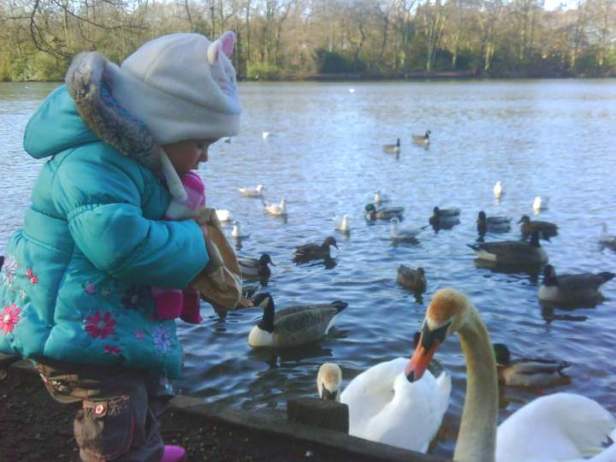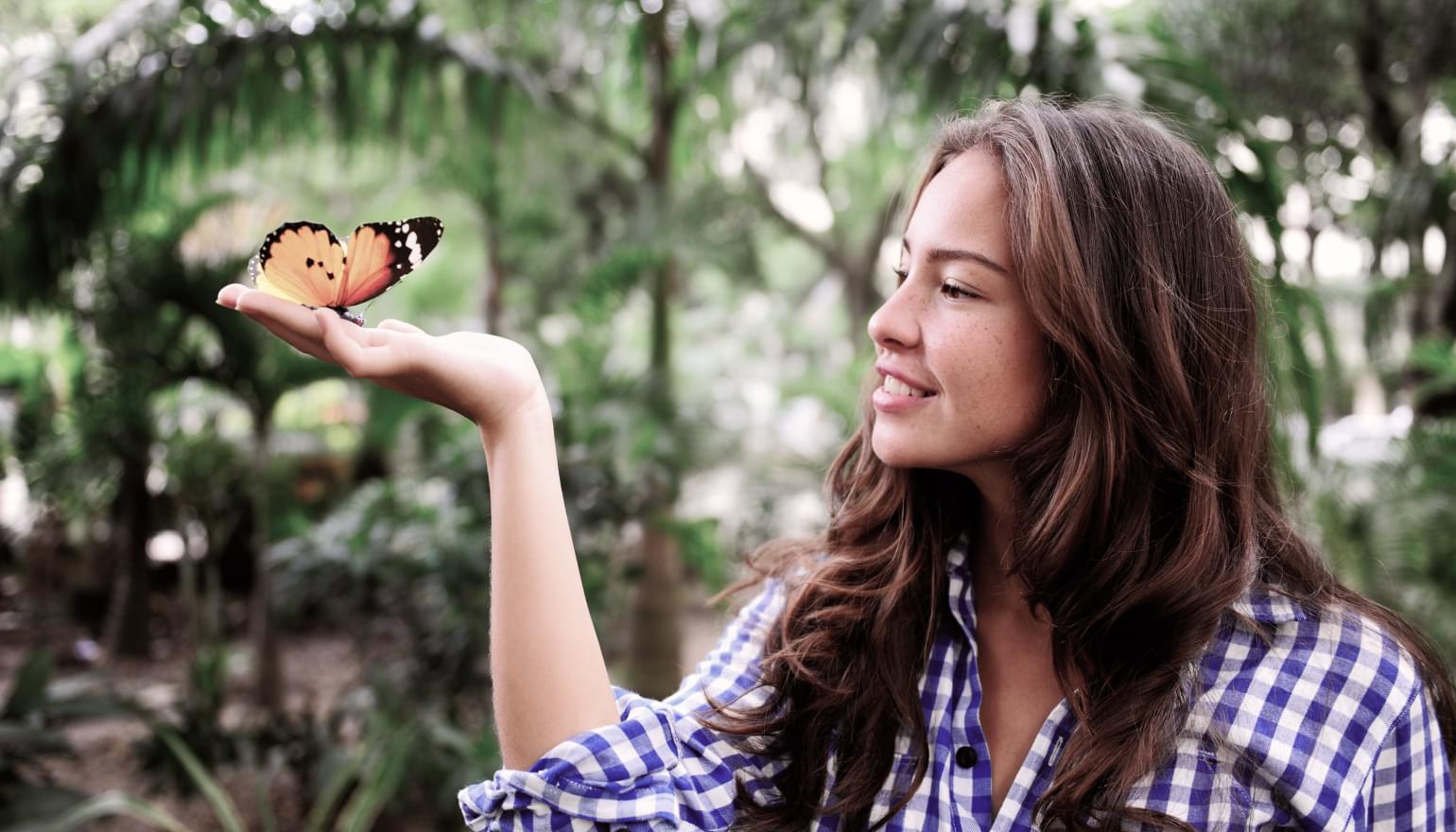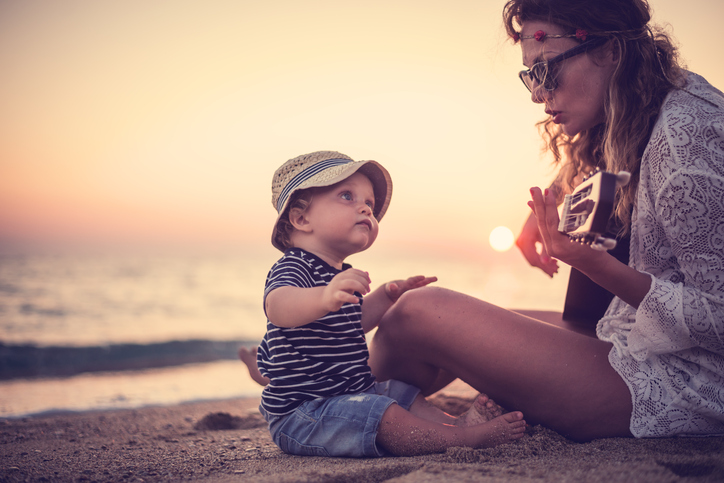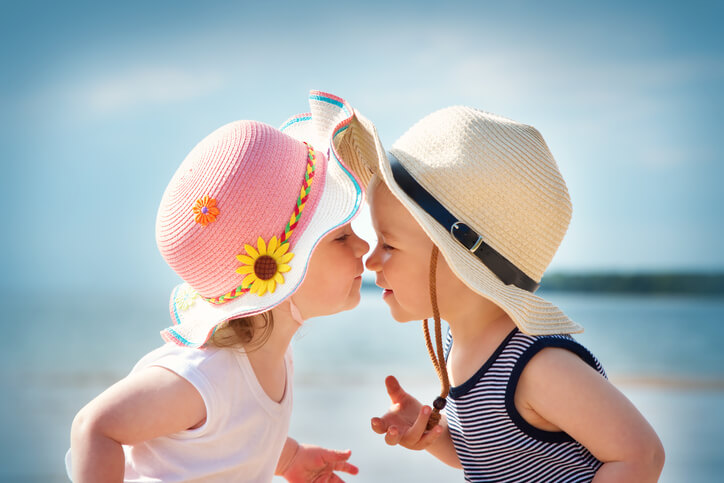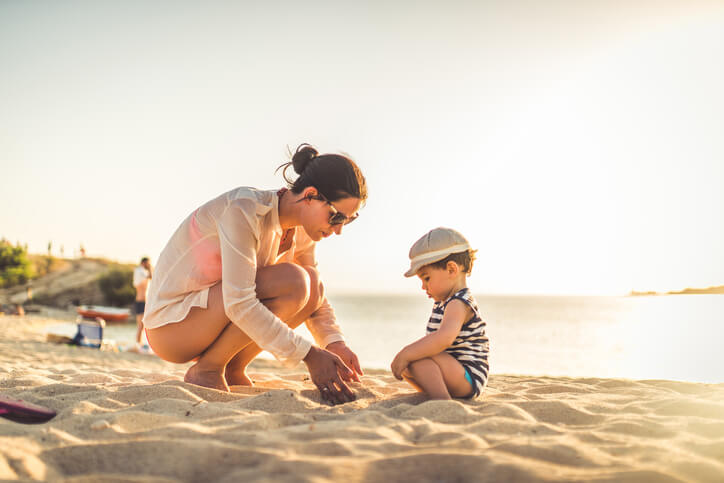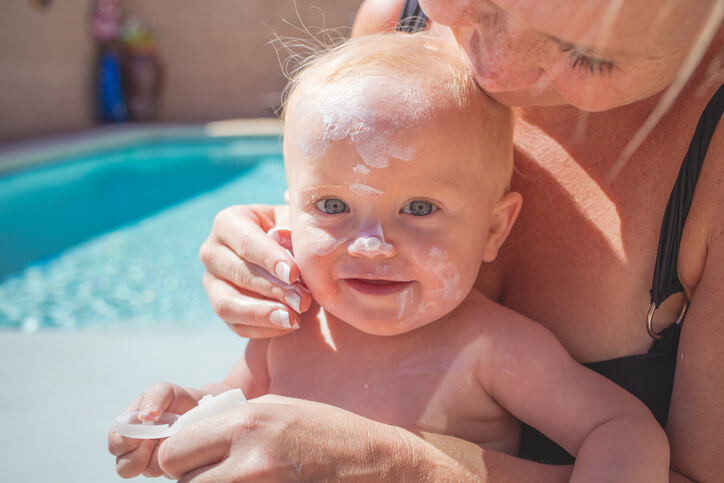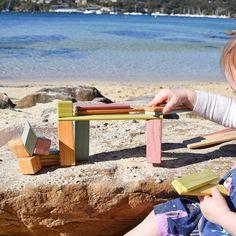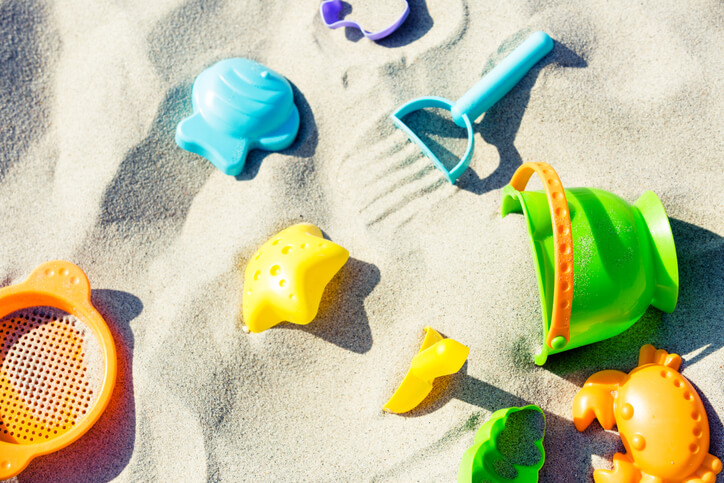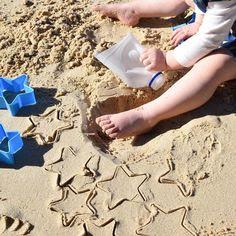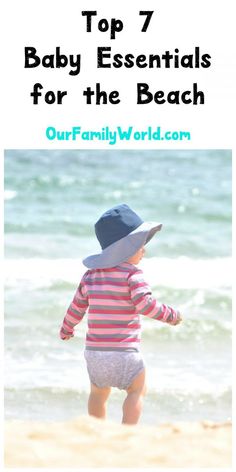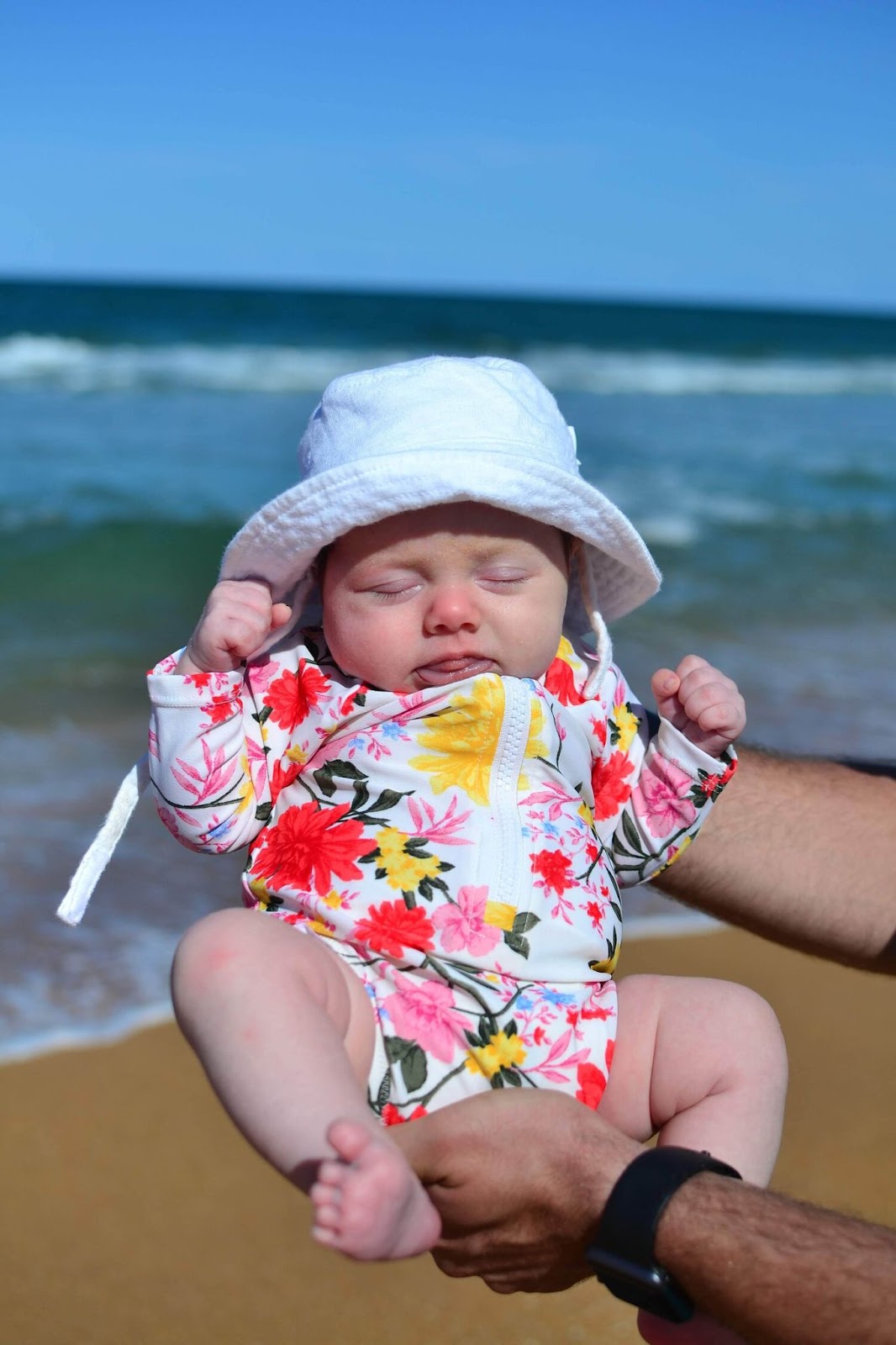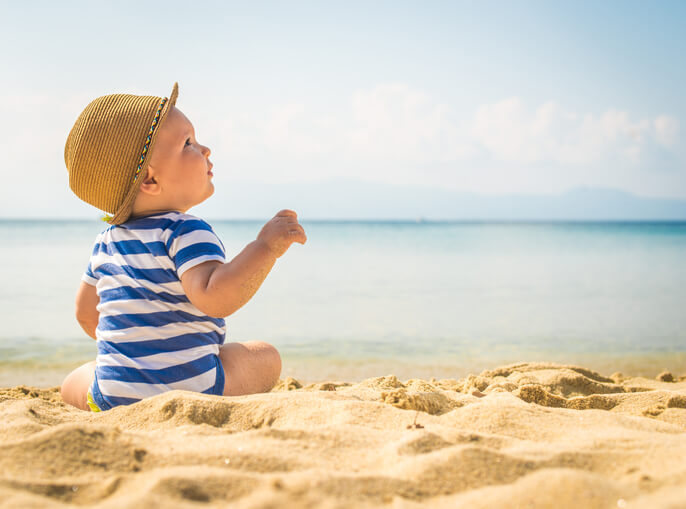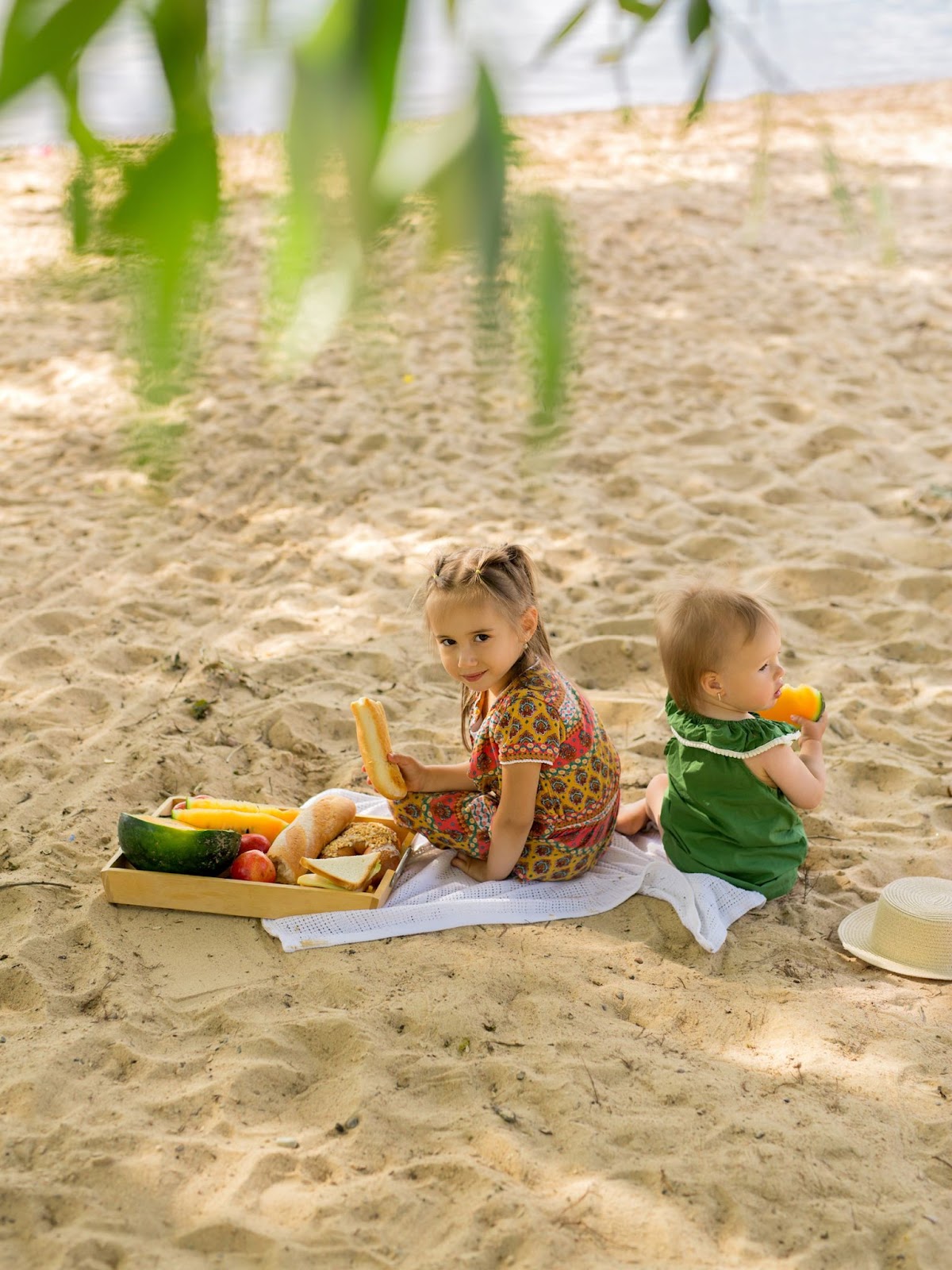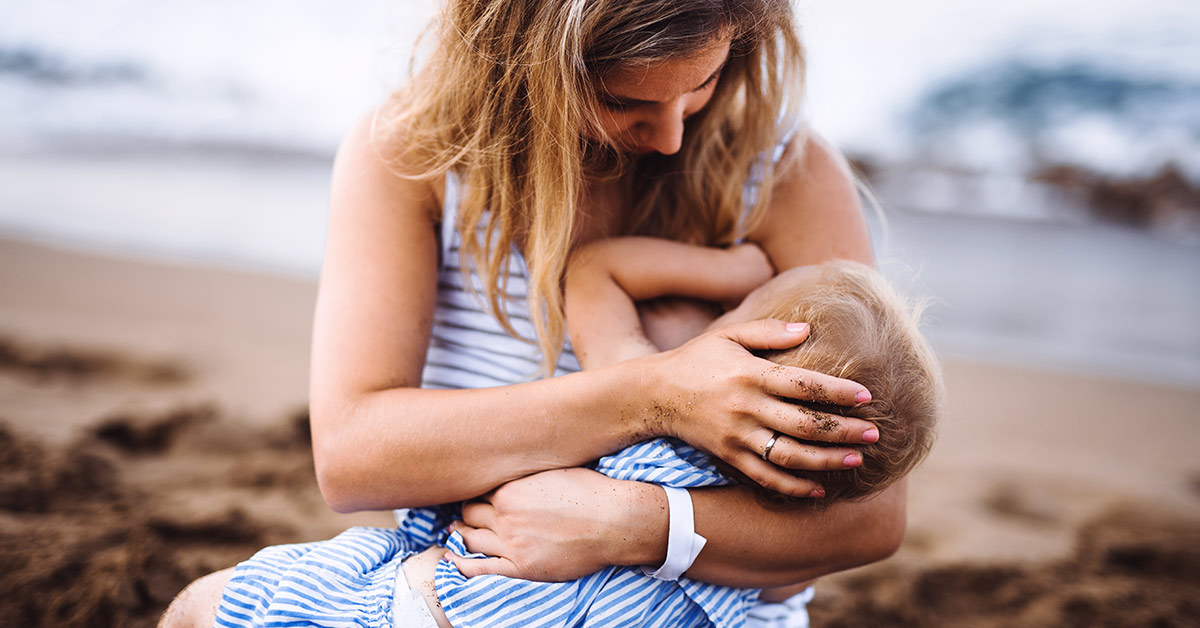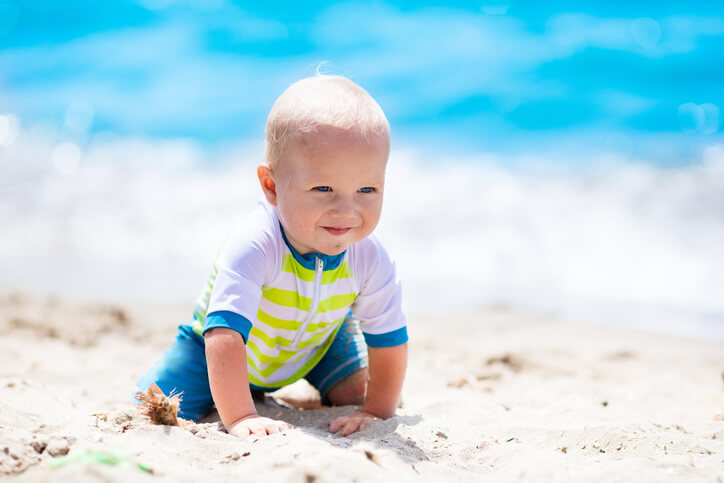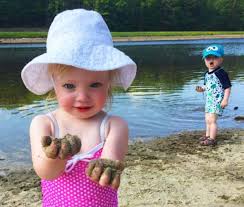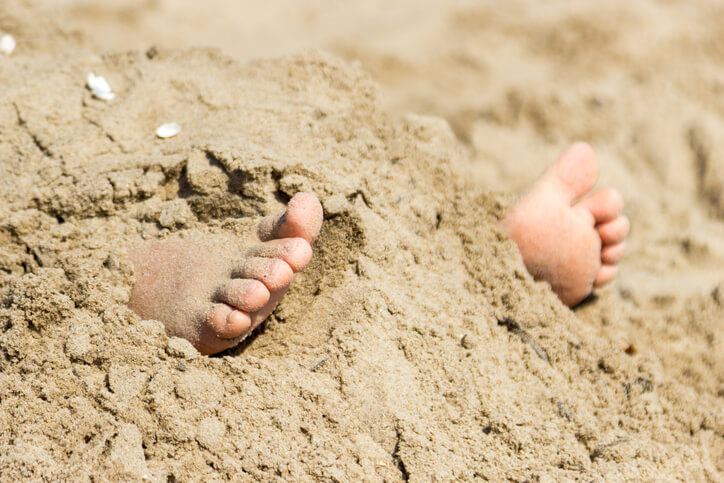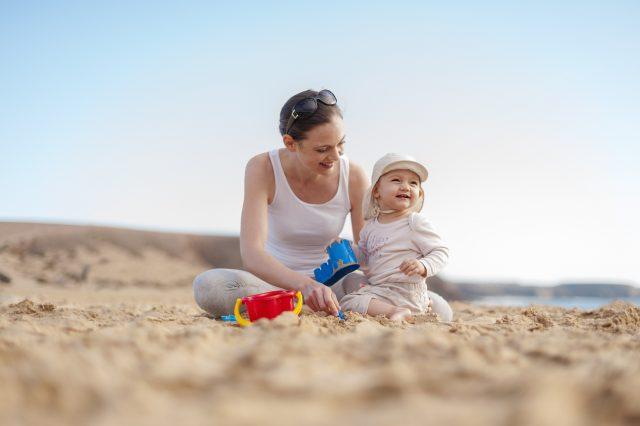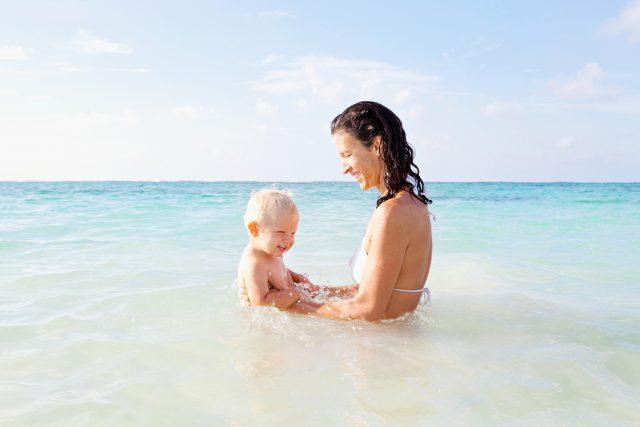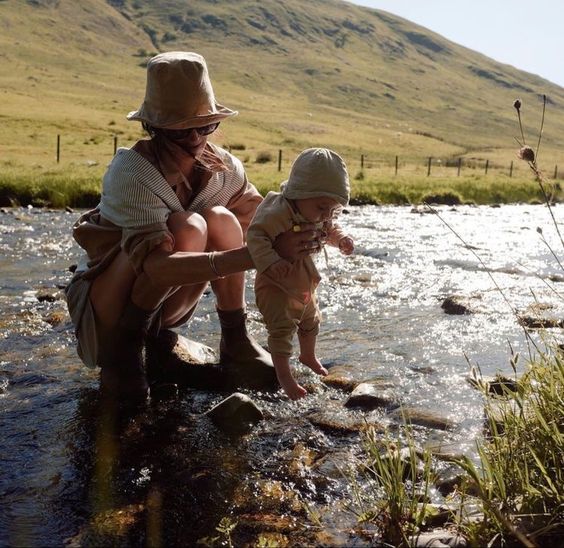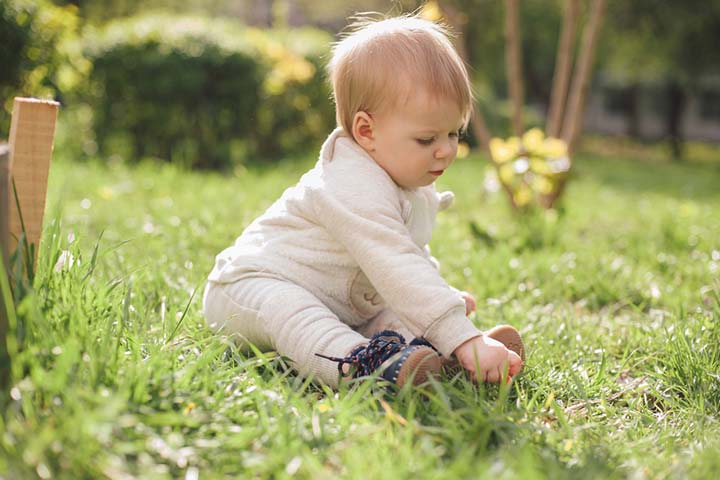
Superscript
TONS OF FUN OUTDOORS WITH YOUR INCREDIBLE BABY!
Just because your baby is small, doesn’t mean you have to stay inside all day. There are many enjoyable outdoor activities that can be enjoyed with babies! Be sure to practice smart safety as you enjoy your time outside. And both, you and your baby will be invigorated as you breathe in that fresh air and soak in that sunshine.
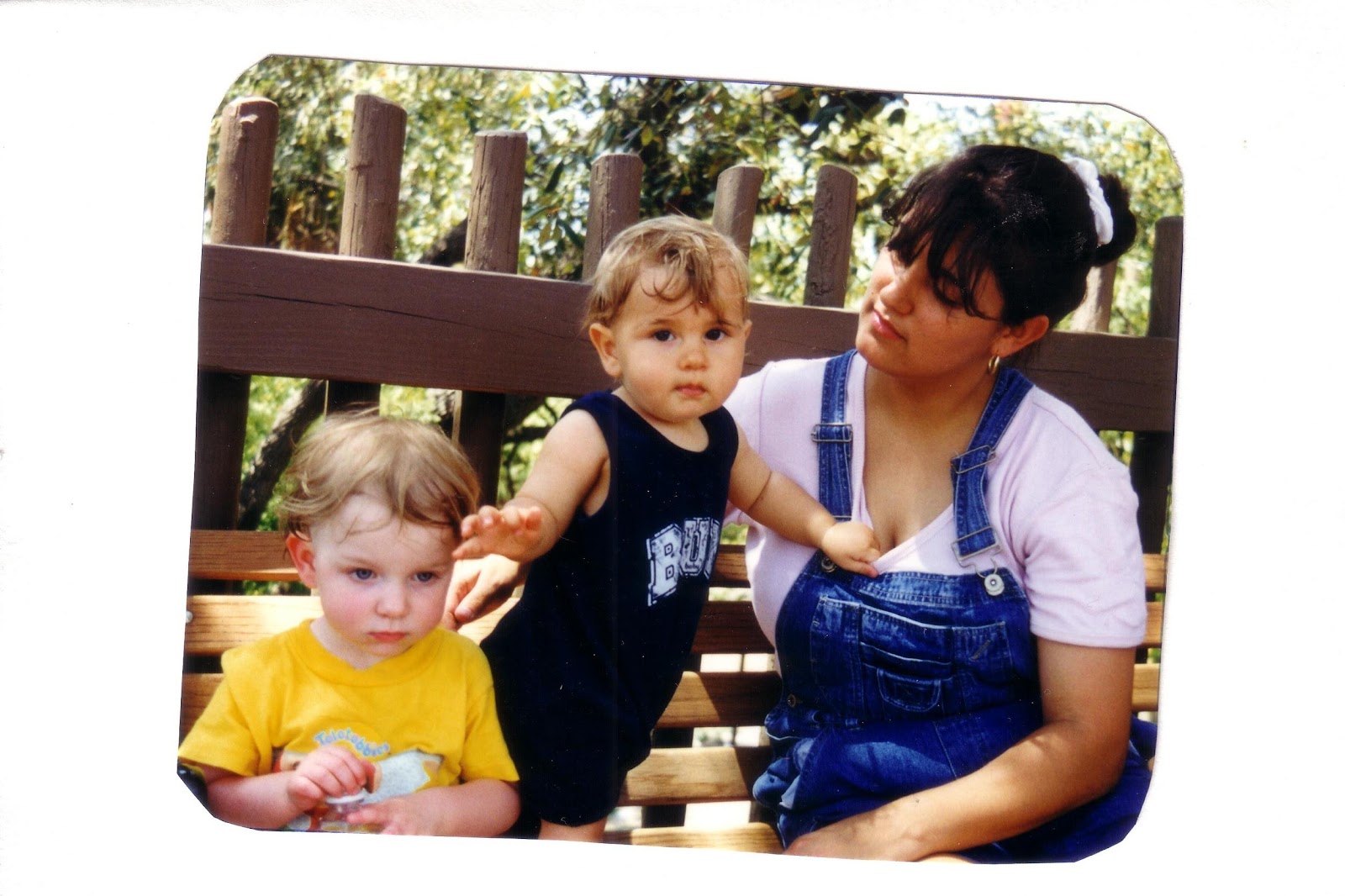
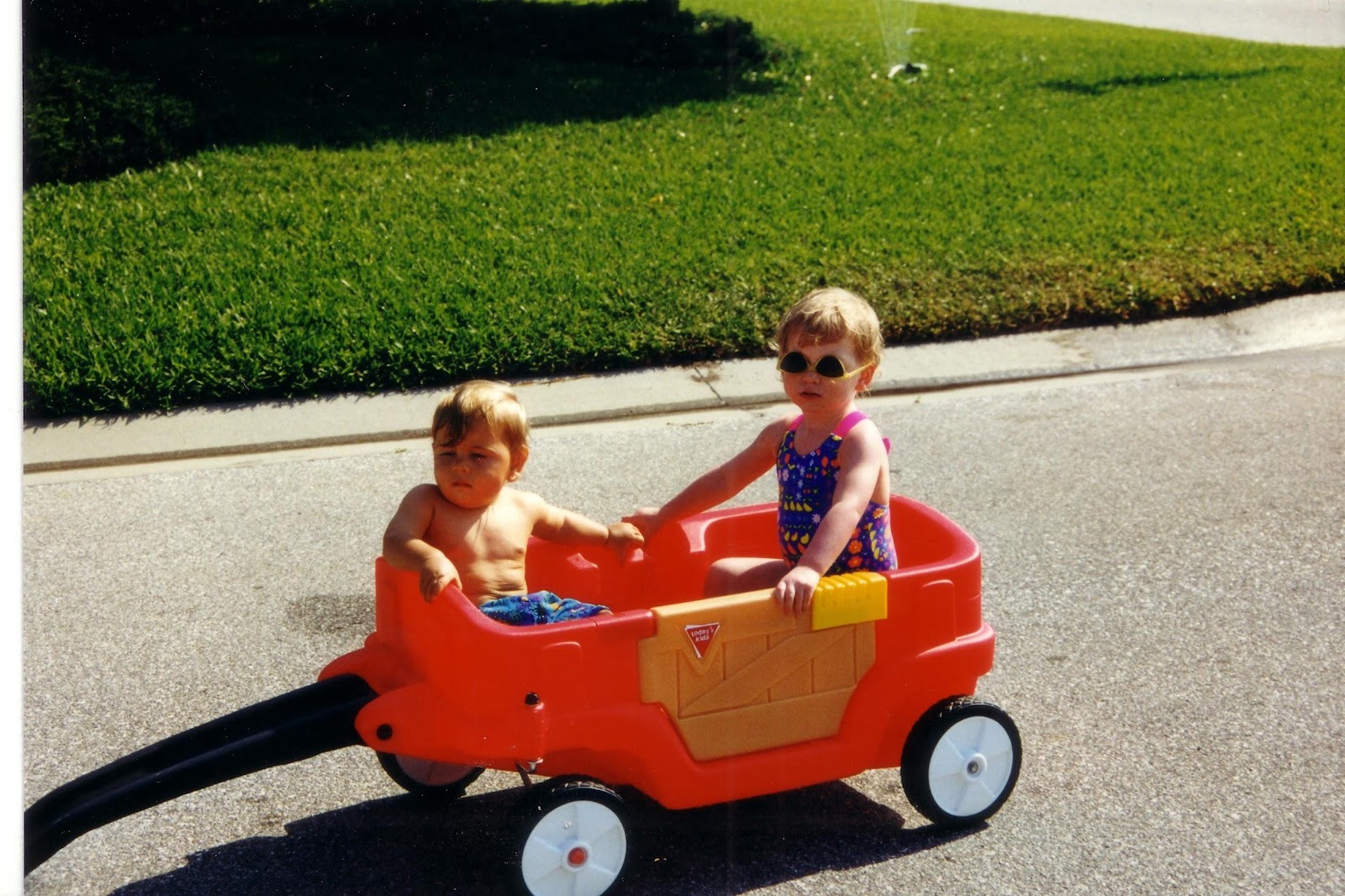
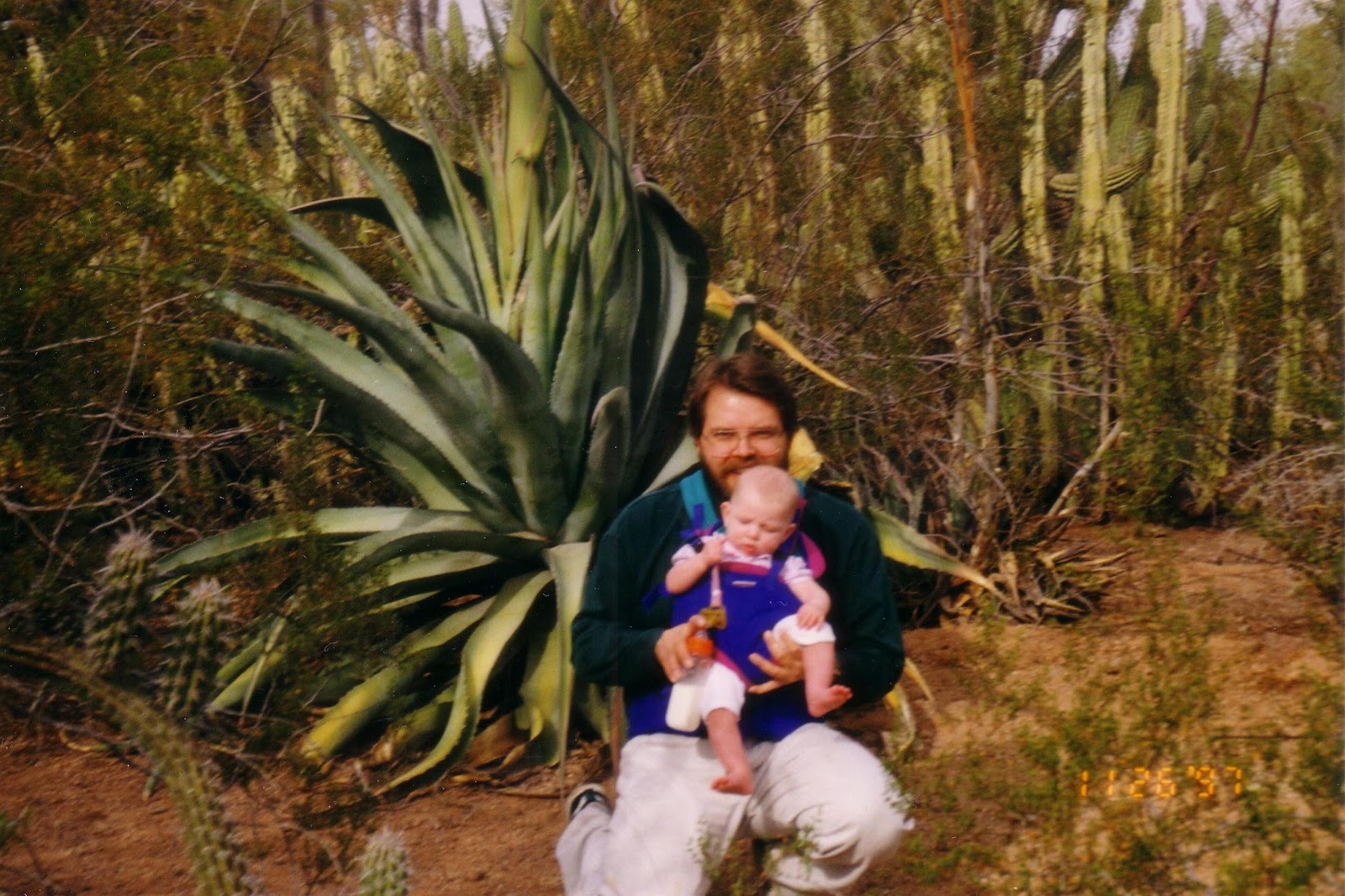
Breathing the fresh air from the trees will energize you and give you a little extra oomf. Getting some sun will give you the vitamin D your body needs. And your baby needs to see, hear, and smell things from the outdoors to learn about the world outside of his home.
Infants need interesting things to look at, as well as a variety of sounds, temperatures, and smells. Research shows that being outside gives them a more meaningful sensory experience than being indoors. Imagine the difference between lying on a blanket outside watching the flickering leaves of a tree, feeling the sunshine and the breeze, hearing a dog bark nearby and smelling freshly cut grass. Now contrast that to lying on a blanket in the house and looking up at a ceiling or mobile. The sensory experiences cannot be matched. Their senses are stimulated by vibrant colors, new scents, the attributes of temperature and weather, and the natural sounds like birds, bullfrogs and crickets. Nature is balanced just right for stimulating their senses. I love just hanging out with children outdoors and doing whatever peaks their interest for that day. If you can just go with the flow, the day will be a great adventure. H. M. Fales
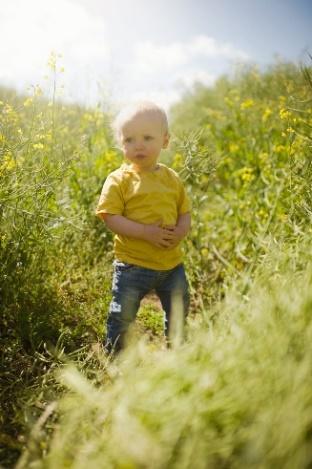
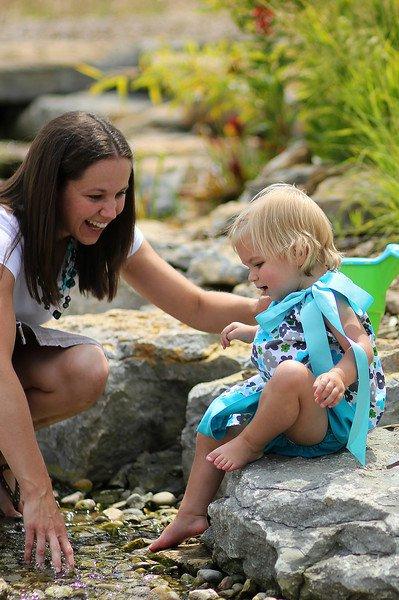
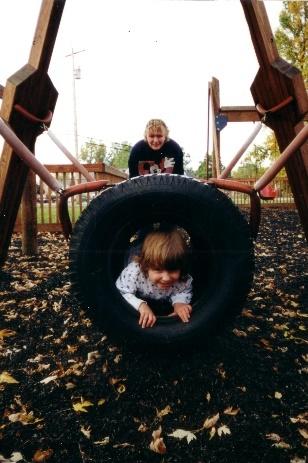
Babies that spend time outside are often healthier and sick less often.
The fresh air and sunshine (Vitamin D) can do wonders for anyone’s health. Spending time outdoors also gives your baby an escape from indoor germs and bacteria. Recirculated air in closed environments and germs on commonly touched indoor items are the main causes of children getting sick. In fresh, outdoor air, babies do not have to rebreathe the germs of others, and the chance for spreading infection, viruses, and illnesses is reduced.
Exploring Nature With Your Baby
BY ALICE HONIG
From the first hour of life, when a baby stares into the eyes of his new parents, he is learning all about this brave new world. Babies try to make sense of what they see, touch, taste, grab, hear, hold, and squeeze. Think of a baby clutching a hunk of ripe banana, slowly squeezing it, and watching in wonder as the yellow, creamy fruit slithers between his fingers.
Babies are born primed to learn how the world of people and objects works. That is why they love exploring their outdoor surroundings. Every bug, animal, or bird that your baby sees is a brand-new experience — especially because babies spend so much time indoors. When at the park or in your yard, don't be surprised if your baby wants to touch a nice earthworm as she inspects the grass at the edge of her blanket. Many babies love to feel a caterpillar crawling on their arms.
Natural experiences should come in doses that are understandable for your baby and in ways that keep your baby safe, of course. Babies are forever exploring, whether trying to poke a finger into an electrical socket or attempting to tip over a stand so that they can pull at and maybe taste the shiny green leaves of a plant. Babies are often unaware of dangers, and toddlers can climb with agility and fearlessness into hazardous situations.
Opportunities to experience nature up close stimulate infant senses, provide a sense of loveliness for him to appreciate, and encourage you to label objects — flowers, plants, and animals — and to explain their characteristics using as many of the senses as you can.
Technology has made its way into every aspect of our lives. Children see less and less of nature and the outdoors and more and more of touchscreens and televisions. The following suggestions provide great ways for you and your child to safely experience the outdoors and will lead to rich learning experiences.
As you walk with your baby in a pack on your back, point out sounds she can listen to, such as a bird chirping or crow cawing at the top of a tree. Point out the insects crawling, the doggies running around sniffing, and the squirrels climbing up trees. As your baby begins to use some language, she may call your attention to a bird flying up and settling on a tree branch. Rejoice with her excitement. The world of animals and birds is a new kind of discovery for her. Spying on Squirrels and More with Ranger Rick For more about other animals, use theTreehugger Site
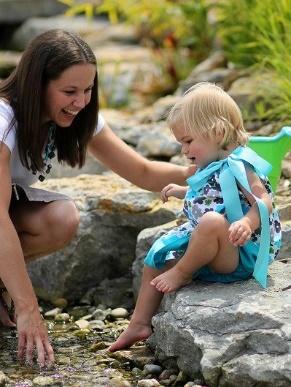
Exploring a river, looking for water critters, catching tadpoles, finding special rocks or even arrowheads was a favorite pastime I shared with my Dad. Kids require little direction when it comes to this kind of fun. Give them a river, some water shoes and set them free.
Enjoy Bird Watching Together
Try to guess which bird is singing that song. Explain male and female colors. In the spring, leave some scraps of material or yarn for the birds to find and use in making their nests. In the winter, drive through areas where there are trees to see the nests they have built.
Get Outside & Connect: Roll Down a Hill
Do you remember rolling down grassy hills as a child? I sure do. I remember rejoicing with my brothers and neighborhood friends whenever we found the perfect spot to go for a roll. We laughed, we squealed with joy, we connected with nature, and we helped our bodies develop properly. What could be better than that?
Children need to move and play outside on a regular basis in order to develop healthy sensory systems. Rolling down hills is a great way to get outside, connect, laugh, and have fun. It is also the perfect activity for the developing sensory system. Get outside and go for a roll down a hill today!
Start Nature Treasure Discovery Boxes:
Babies and toddlers really enjoy playing and tinkering with random loose parts. You can make them a nature-themed bin full of all sorts of natural treasures for them to build and play with. These develop the sense of touch. You will see the budding scientist as they explore the objects.
Consider filling a small tub with smaller containers that they need to open and explore and fill and empty. Think shells, pretty stones, pieces of driftwood, maybe some paint brushes and small scoops too.
Hope is twenty five and still prepares herself with...the right outfit and something to collect natures treasures in.
As a baby she would be content with her treasures and sorting them in different ways for the longest time.
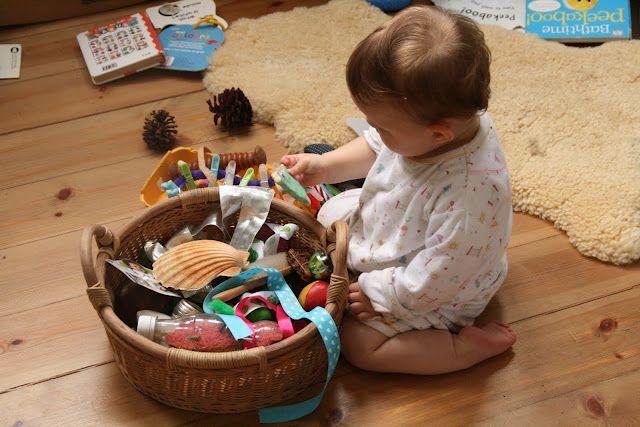
For an added task, give them some water to paint these treasures and watch how their colors and textures change.
Visit the zoo .
Wheel your stroller close to an exhibit and point out what your baby is looking at, whether it's a seal splashing in the water or a monkey swinging from a branch. You have been reading animal stories to your little one from early on. Now, at the zoo, he gets to see all those creatures that were in the storybooks. Let your toddler tell you that he is watching Horton the elephant lift up his trunk!
Stroll through a garden.
Flowers and plants offer your baby sensory and aesthetic pleasures. She will be sensitive to, and admiring of, the colors, sights, and sounds. Trees, flowers, and plants provide opportunities for talking about rough bark, delicate blossoms, and perfume smells. Some flowers are lovely to look at but don't have a smell when you sniff them. You can also pick up your baby to show her a butterfly nosing about to get nectar. (A butterfly bush in your garden will attract more of these beautiful "flying flowers!")
Create a garden sensory bin: It was a great way for him to get a different perspective on everyday items from our backyard. With the garden sensory bin, he explored a lot of other things first, but then, it was time to SPLASH 🙂.
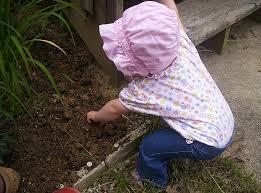
Try Mud Painting and Activities:
Mud painting is an easy-to-put-together activity that combines nature exploration with fine motor skill development. Feeling ooey gooey mud between your fingers is a fascinating sensory experience for little ones. Babies can try to finger-paint with mud (or chocolate pudding if you want an edible option) 20 glorious ways to play with mud!
Digging dirt is a favorite whether their a boy or a girl:When the weather’s nice, we are outside all day. Because my boys love digging, and I do not want a yard full of holes (especially a yard that sees as many games of tag as ours!), this spring we set up a small area for the kids. It’s a natural play space, where they dig, make mud pies, create natural sculptures – to play. Setting up a play space for digging from Simple Play Ideas
Cool off with Simple Water Play Ideas: Let's get started with our fun water play ideas for toddlers and babies! The idea of water play is to keep it simple - don't overthink it and you'll find that it becomes a favorite baby activity!
Watering with Watering Can
The humble watering can is great for what it’s intended to be- to water plants! And more!
Watering plants is a great activity for your child to develop his arm muscles! As he lifts the “heavy” watering can, he flexes his cute little biceps. This simple movement helps his overall body development.
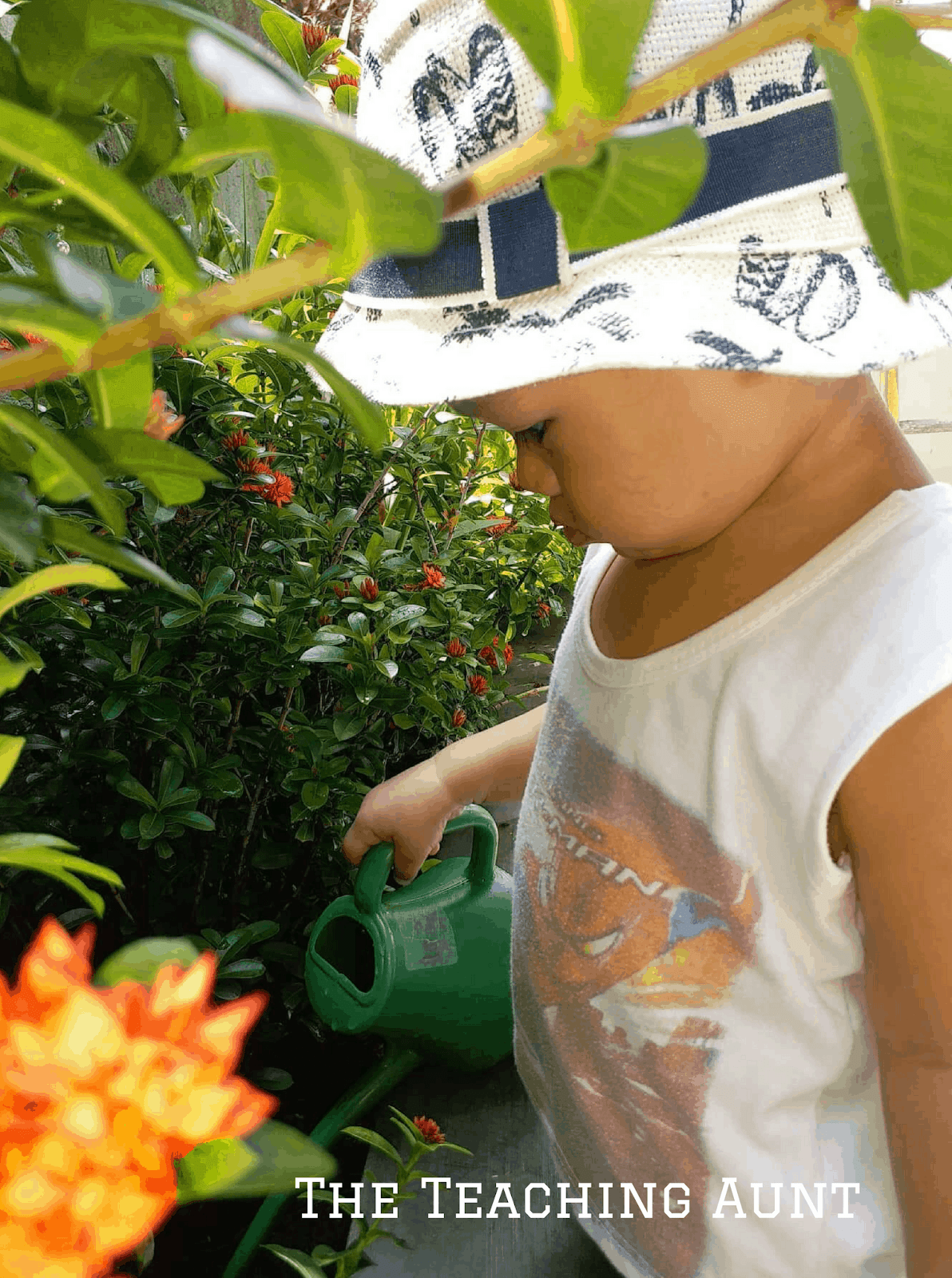
In addition, watering plants is a wonderful jumping board for teaching about the importance of plants and water. As early as toddler years, we can already begin teaching them how to conserve water!
2. Scoop and Pour with Gardening Spade
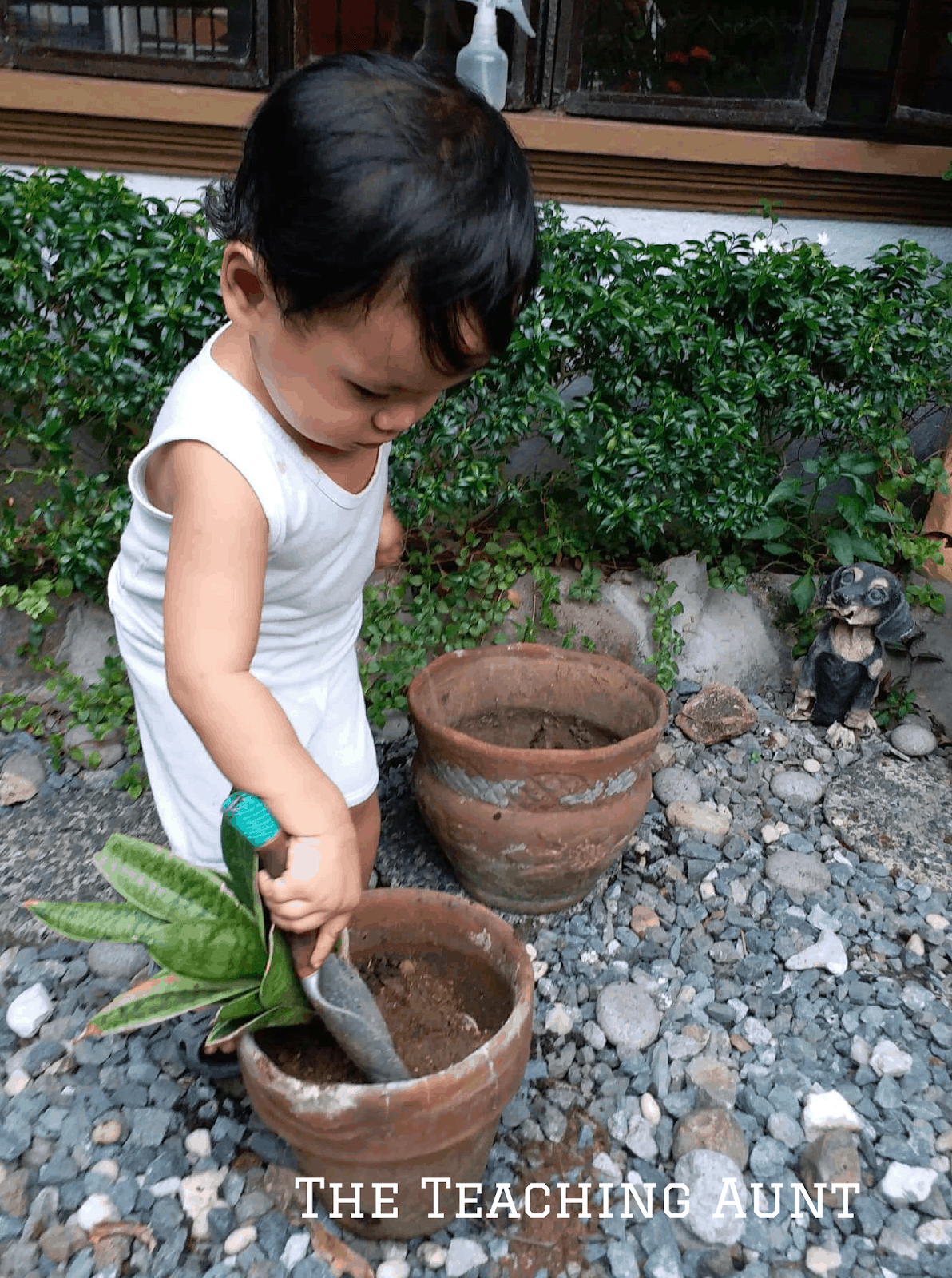
The spade is another gardening item that may be used for scooping and pouring. Two proven favorites by toddlers!
As they scoop and pour dirt, they develop their fine motor skills and they get to practice their eye-hand coordination. I mean, they need to look where they are pouring, right?
And it’s an added bonus if they see an earthworm! It’s instant Science lesson about creepy crawlies!
3. Spraying with Spray Bottle
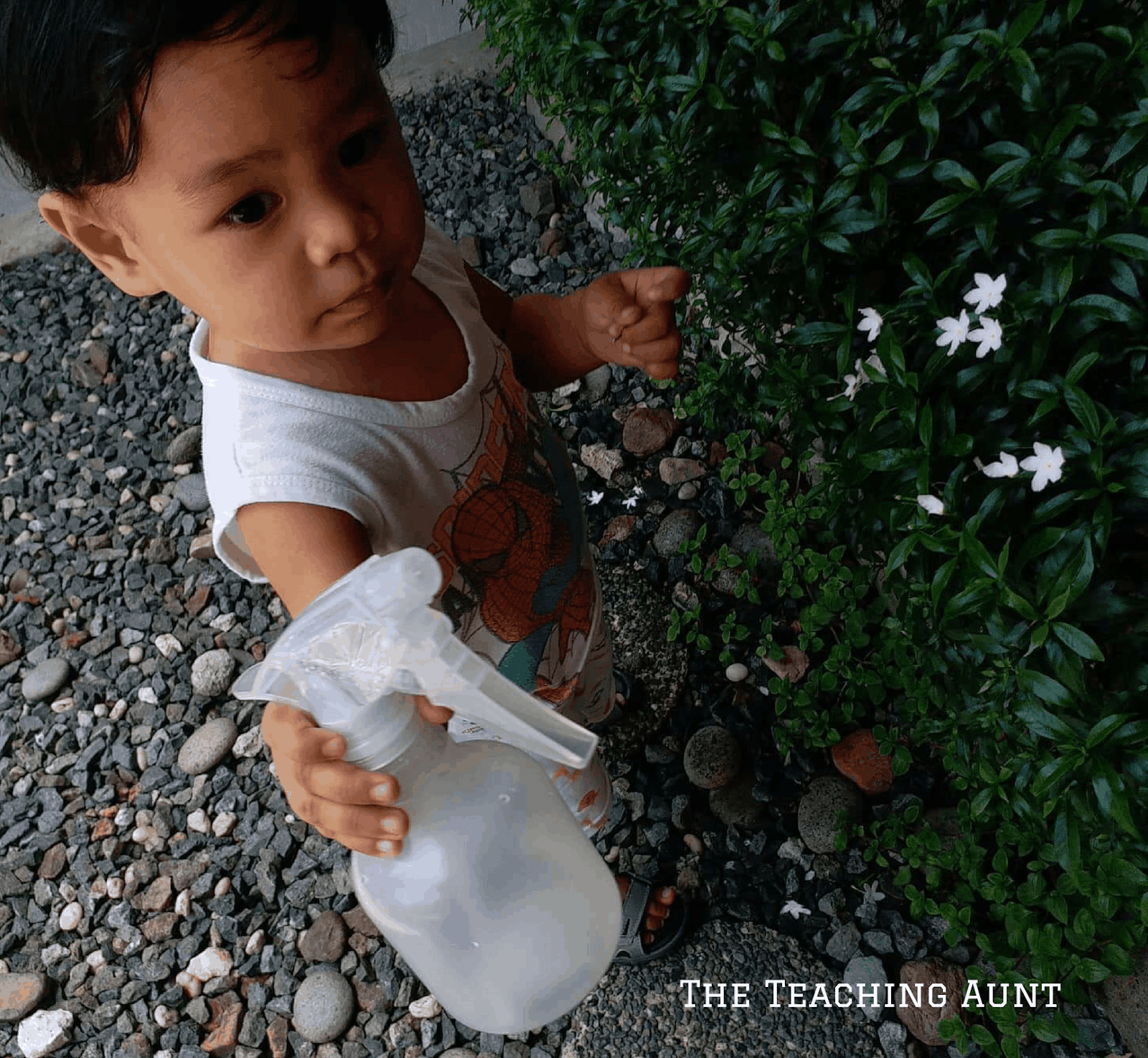
As we’re still on gardening tools, let’s not forget the sprayer.
If the watering can is for the arms, the water spray is for the hands and fingers. Every time they put pressure on the lever, it strengthens their finger muscles- muscles that are responsible for writing!
Imagine that. A pre-writing activity without using a pencil!
4. Squeeze a Sponge
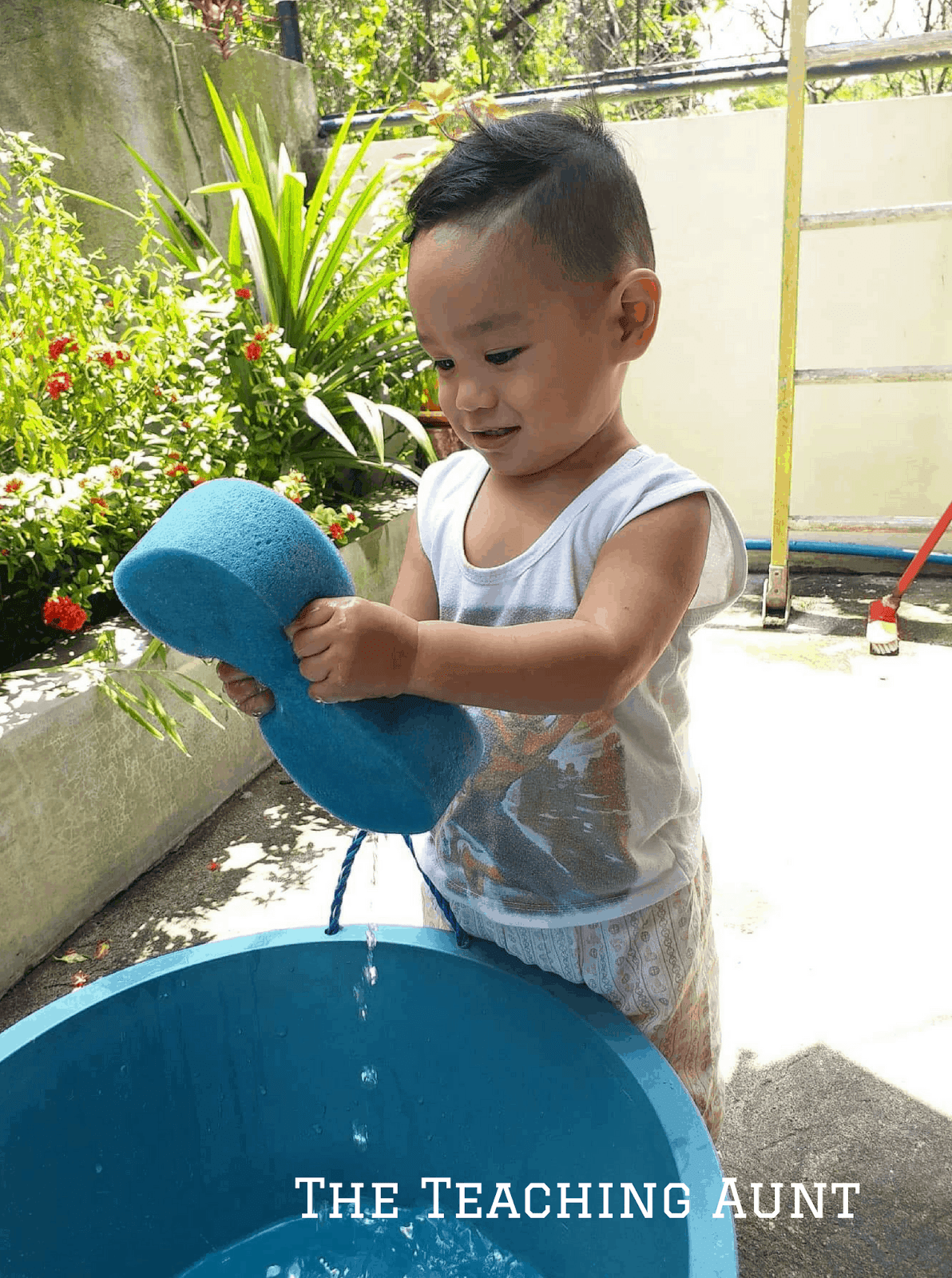
Let’s head to the garage. In here, you’ll see the sponge used for cleaning the car.
The sponge is also a versatile item that could help your child develop his fine motor skills. The squeezing movement is great for their cute little fingers!
It’s another pre-writing exercise!
Make sure that the sponge hasn’t been used with harsh chemicals before and you’re good to go. Or to be safer, just buy your toddler his own sponge. It will be worth it!
5. Use a Water Dipper
Like the watering can, this item targets the whole arm. And fingers, too! Your toddler’s grip will be exercised here as he takes hold of the water dipper’s handle.
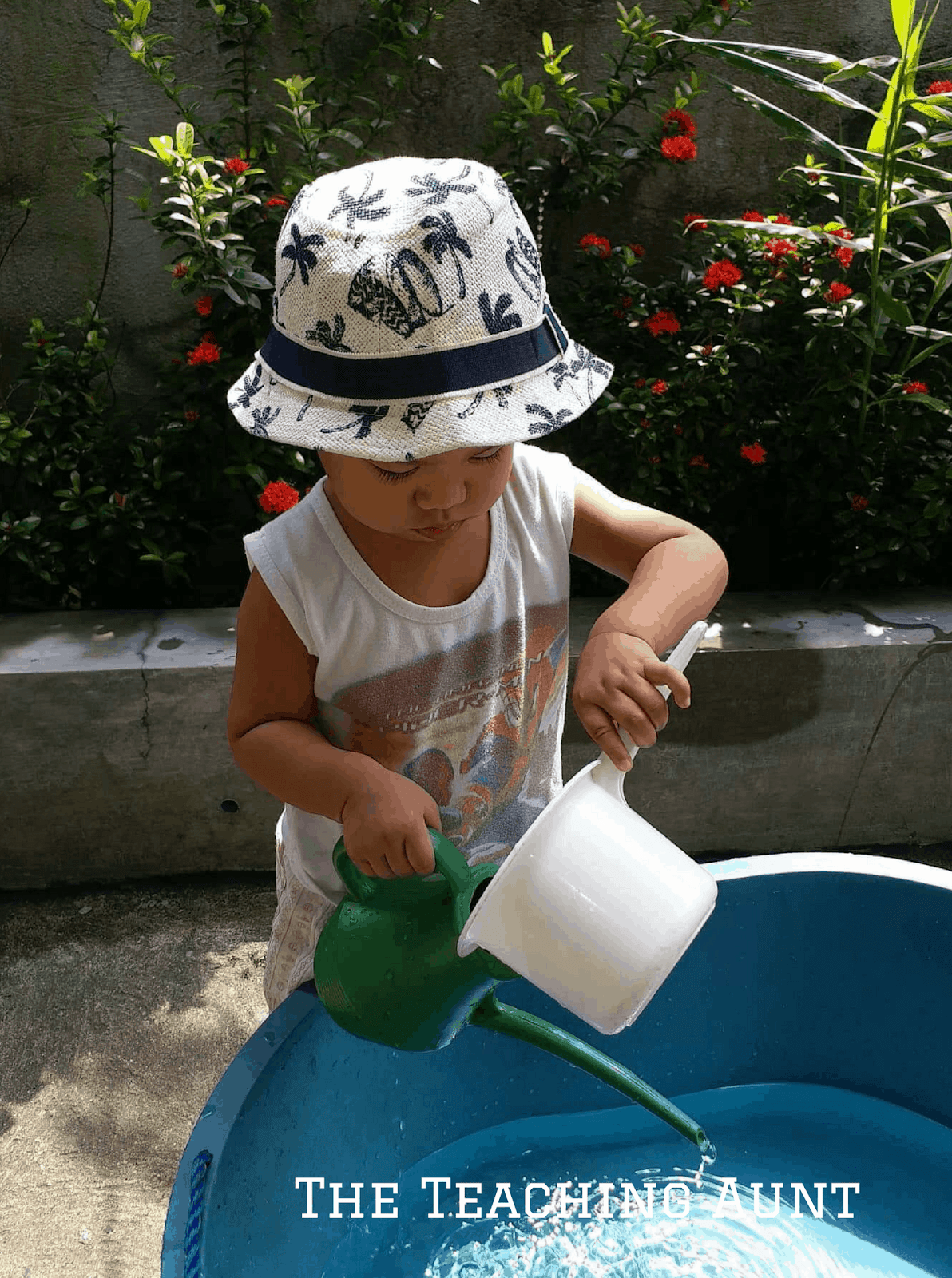
This is also another great item for scooping and pouring. You hand this to a child and I’m sure he’ll be busy in no time.
Not only will you nurture the love of nature in your children or grandchildren, but you will also strengthen your relationship with them through quality time spent together. Let nature be a foundation for wonderful memories that will be cherished and remembered long after you’re gone.
Enjoy these experiences together!
SIMPLY OBSERVING THE WONDER
OF THE NATURAL ENVIRONMENT!
Activities for babies don’t need to be complex or overly planned. After all, everything is a first experience for a baby! So when they scream with excitement or want to take something home for a closer look, glet them. Stop and see what they are excited about, pause and get excited too.
Nature walks or hikes with a baby are all about how nature intrigues them. The reason to take a child for a walk is to create memories and develop an interest in the natural world. At this stage, when they are processing so much new information about the world, people, and objects around them, they interpret everything through sensory motor system. So make sure that you enjoy the fresh air and learn about your childs interests and what catches thier eyes. That information is crutial in developing your child's independant thinking and for you when you are planning playtime.
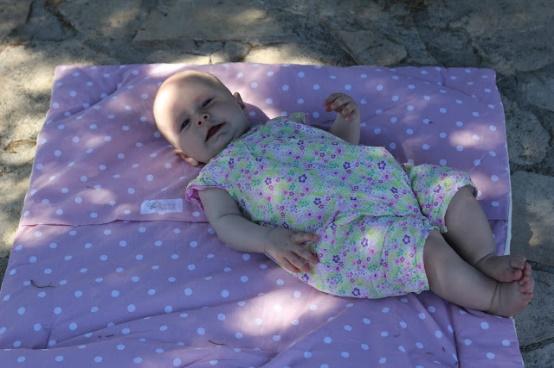
For this simple activity we took a rug outside and, together, laid down underneath some trees. I lay next to her and looked up and around to get a sense of her vantage point. How amazing to see things from a different perspective!
The light made some beautiful patterns through the leaves and branches of the trees around us, and nearby bushes and leaves swayed in the wind. These also made a lovely, calm sound and the whole setting was perfect for quiet observation together. Big sisters played around us while we lay there, and periodically brought over flowers, pinecones, and leaves that they had found which they really wanted to share with baby Bean!
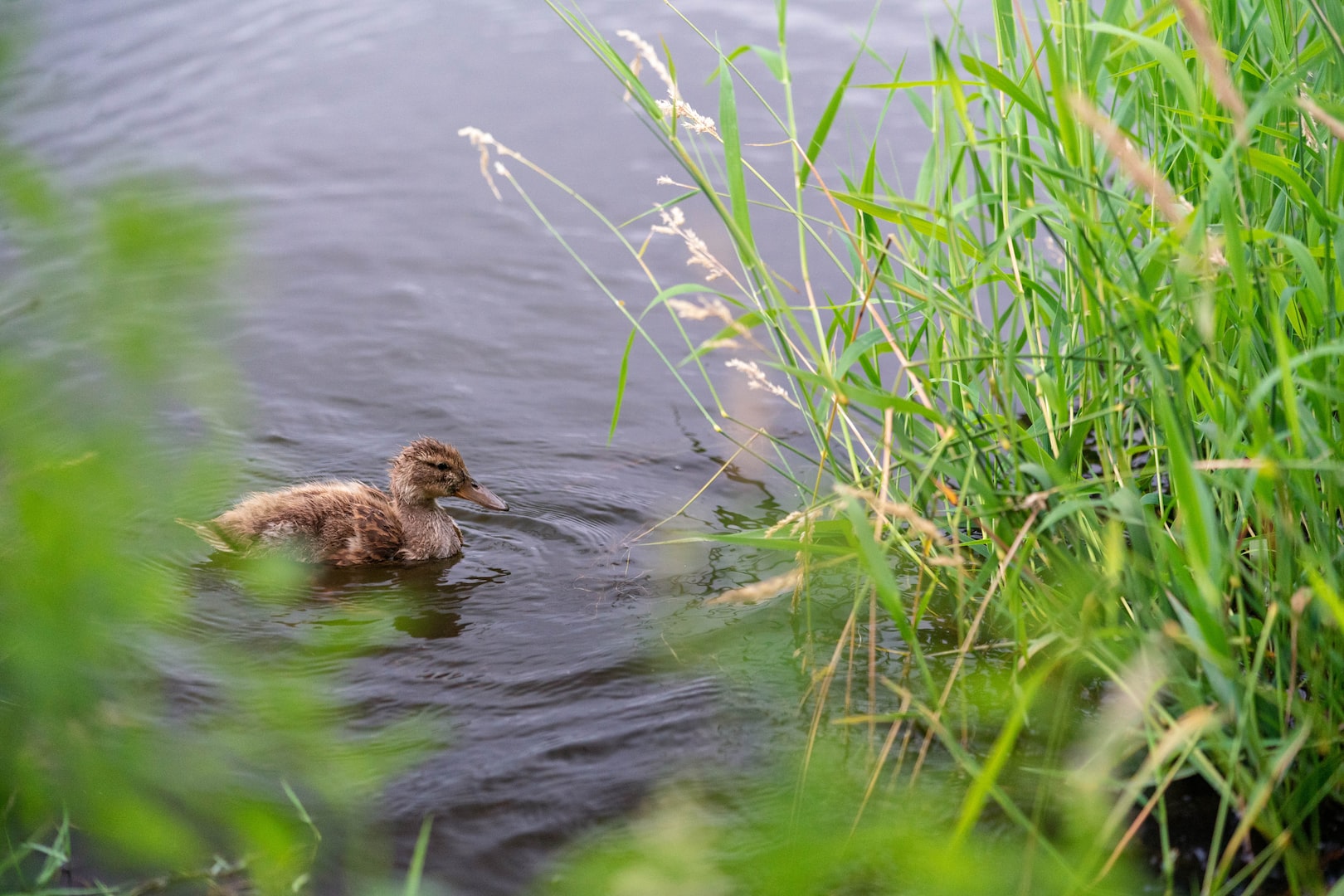
We are on holiday now so these sights and sounds are different to those we would find back home in the garden or park in our big city. But even at home in the garden, the first experience of toes and fingers in the soft grass are not to be overlooked! How about feeling the damp sand at the beach or sand pit, trailing little fingers in water or over smooth pebbles, deliberately standing in the wind, going out at night to see how dark it is and look at the stars together!
They all lead to a wonderful enriching for little babies and are so valuable as a way to learn together about the world we live in.
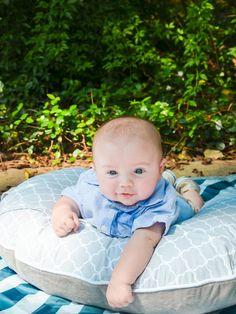
You can lay your babies on their belly on a blanket or sit them up on a blanket in the grass. Help them to explore their new environment by touching and feeling all the outdoor things:
grass
sand
pinecones
smooth rocks
rough rocks
twigs
flowers
leaves
Just make sure you maintain close supervision, so they don’t put these items in their mouth. Also, start building language and vocabulary by talking to your baby about these things that they are seeing, hearing, and feeling.
Your baby is learning so much at this age and taking in everything you are telling him. Here are some ideas of ways to talk about the outside to your baby:
What they can feel:

a smooth rock
blades of grass
a crunchy or soft leaf
warm sun on their skin
the breeze and wind
the hot ground
What they can hear:
cars and trucks honking and driving by
birds chirping
wind from the trees
dogs barking
bugs buzzing
What they can see:
blue sky, green grass, yellow flowers
car, house, ball, bike
butterfly, birds, bugs
other animals and pets, people
Exploring and Enjoying Nature Their Way
Kids are always up for something new, so keep them interested in the outdoors by switching up what you do together. Just remember—you don’t always have to be doing something. Just sitting and observing can be an eye-opening experience.
1. Focus on unstructured play
Don’t “manage” children’s experiences when they’re in nature—simply let them explore, touch, and smell anything that interests them (as long as they’re safe, of course). While it’s tempting to turn each interaction into a teachable moment, allow kids to be curious and indulge their senses and observational skills without an adult jumping in to be the “expert.”
2. Let them get dirty
Being in nature is about getting wet, muddy, and disheveled—and, potentially, stung by a bee or scraped by a rock. While kids need to be kept safe from serious injury, don’t encase them in bubble wrap: let them wade into the shallow creek, climb the tree, and touch the slimy stuff. If they’re old enough, let them head out in a group and explore without adults around. Knowing they can handle themselves in the natural world gives kids a definite sense of confidence.
3. Get them the tools & gear they need in their size
A pair of binoculars, a multi-tool, their own water bottle—having their own gear can be a huge boost for a kid. Teach them how to tie up their own hiking boots, walk them through how to use a knife safely, clip a carabiner to their belt loops, and you’ll have an outdoorsy kid for life.
Take them to a park or a local garden
to take pictures-
Oh that one always brightened our day!!!
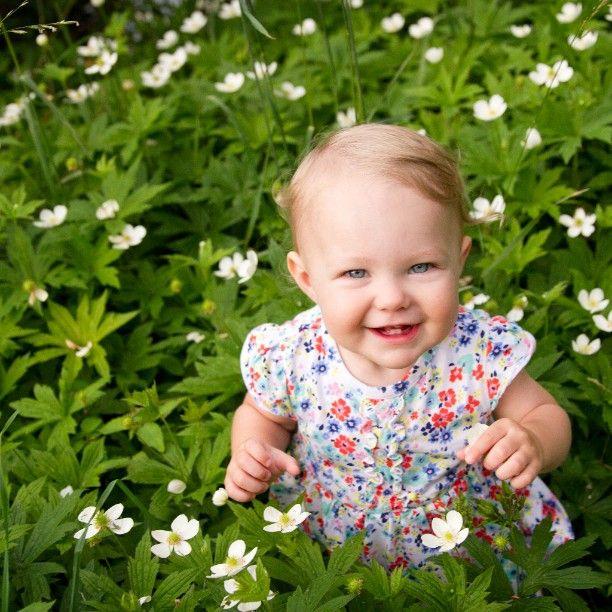
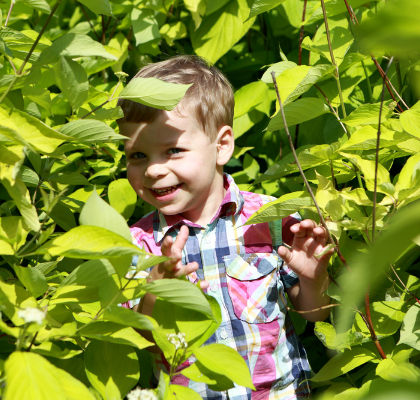
Bring a playful friend to help baby get in the mood to explore and giggle! Then take a snapshot of then using their senses to enjoy their time outside. Pack a couple outfits for different environment.
Hope was always playful in a garden, so I planted her a half-acre wildflower garden.
Her and her friends eventually went bug hunting there almost every day.
Related Post: 12 Simple Activities to Help Your Baby Sit up on Their Own
Whether actively interacting or simply lying down and watching them float around, bubbles are a magnificent and magical way to help development and enjoy the moment.
Making an Outdoor Adventure Photo Book
I forgot to do this with Hope. She did have posters in her room that worked the same way. Here’s two ways of creating nature photo books. I liked to bring my camera with me on any excursion outside. Taking pictures of them in nature or something we saw along our way. I thought of it as a teaching tool for littles. They could learn about animals’ names as well as their habitats and homes. Hope always asked what their homes were like to help feed them and make sure they were happy and safe at night.
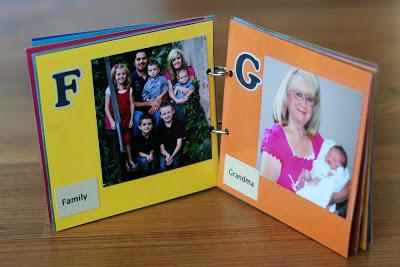
Richie and Weston LOVED to look at photos of people in their family, especially group photos with themselves. I made them pretty old school using paper and photos. I just bought a pack of 6×6 colored paper (I liked Index cards best) and found some fun stickers, then I found photos that I had on hand. I got them both laminated (with Contact Paper), hole punched them and put them all together with 2 rings. The boys loved to add their own stickers and titles for each page.
They were super easy, and the boys loved them!!! I like this method because I could add pictures of their adventures with their natural family and us their foster family. It was good for them therapeutically because I turned it into a people that loved them and happy moments project that they continued the whole time that they were with us. Their naturals families loved to provide photographs for their books. It boosted their confidence.
You can Use a Nature Adventure theme but make them the same way.
__________________________
Everywhere we went, Sara would point and say, “huh huh” as she was not quite talking! But that is how she let me know where all the other babies in the grocery store are with a pointing motion and a smile. Since she’s so happy looking at babies everywhere we go, I came up with a fun DIY Magazine Baby Book she can look at home or in the car. You can use this same process for any topic that your child enjoys.
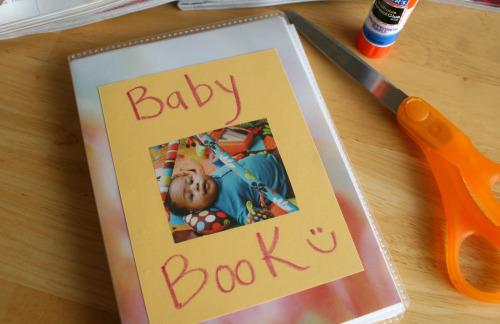
Supplies for DIY Magazine Baby Book:
Photos, old magazines, (preferably nature magazines for our use)
scissors
small photo album, available at most stores for a couple dollars near the frames
small paper and glue stick for the cover
stickers
With this photo album, it let me take out the cover. So I slid it out, glued on a piece of paper and wrote “Baby Book” on it, giving it a title.
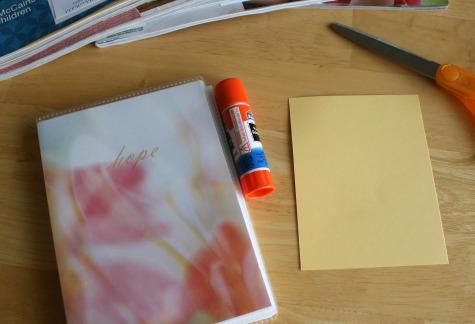
Dig out your photos or old-saved-for-crafting magazines from your craft room, you have a pile of these, right?! Flip through the pages and cut out pictures of babies and toddlers. I tried to find a few with actions, like laughing or bath time, etc.
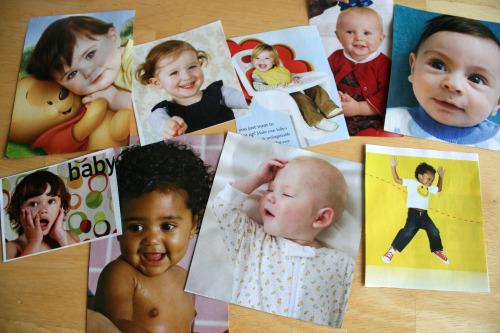
There’s a few ways you can add them to your photo album:
1. cut each picture to match the size of your photo album,
2. glue them to another paper to slide into the album, or
3. simply put them in the album as is!
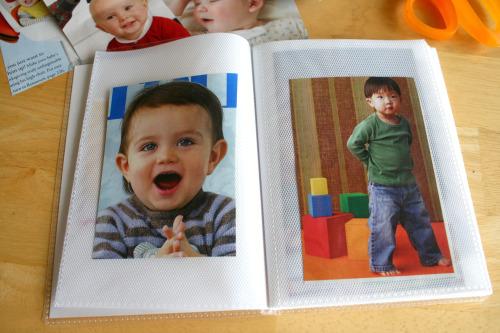
Once you’ve got all your photos in place, hand the album over to your baby to go “ga-ga” over… literally!
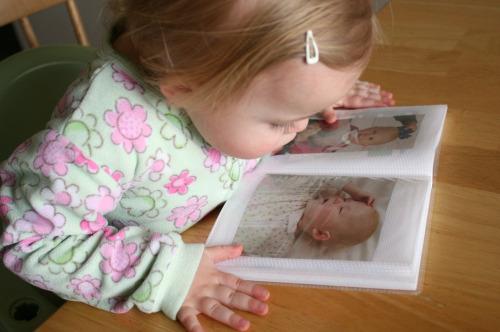
Babies love watching bubbles dance in the wind
If your baby needs extra support in the tummy time position, place a rolled towel or cushion under the chest to help her lift her head.
Tummy time fun! Place a shallow pan of water in front of your baby and blow the bubbles up and towards the pan. Some bubbles will land and stay in the water before popping. Blow these around gently. You can also place some bubble liquid in the water and blow through a straw to create a growing mountain of bubbles. More tummy time activities here.
Spend time together on your tummies watching the bubbles fall to the ground. Try catching a bubble on your wand then let your baby reach to pop it. He’ll be able to do this before he develops the ability to reach out and pop a moving bubble.
When sitting, be it leaning against you, independently on the floor or in the highchair, encourage pointing to the bubbles, leading to grabbing, catching or popping them with a clap!
Bubble play activities for crawlers, creepers and toddlers
Leave a large bubble wand and/or a tightly sealed container of bubbles where your older, mobile baby or toddler can safely reach them. This way he can let you know whenever he is ready for some bubble fun.
Once crawling, creeping and walking he will love to chase after the bubbles and pop them in the air or on the floor. Provide extra sensory input by doing this across all sorts of safe surfaces; carpet, floorboards, grass, sand etc. Access more crawling activities here.
Safely arrange obstacles for your crawler or toddler to move over or under to get to the bubbles, for example, cushions, pillows, tunnels, and chairs.
Bubbles are great fun at bath time, though be careful, as it can get slippery! Bubbles will sit on wet skin for longer before popping. Blow the bubbles onto your little one’s body and name the body parts they land on.
Older babies and toddlers love trying to hit the bubbles with a fly swatter. Start with the ones that land on the ground.
Recipe for non-toxic, natural bubble mixture
Mix together: 1 cup water, 1 tablespoon glycerin, 1/4 cup natural, biodegradable dish detergent.
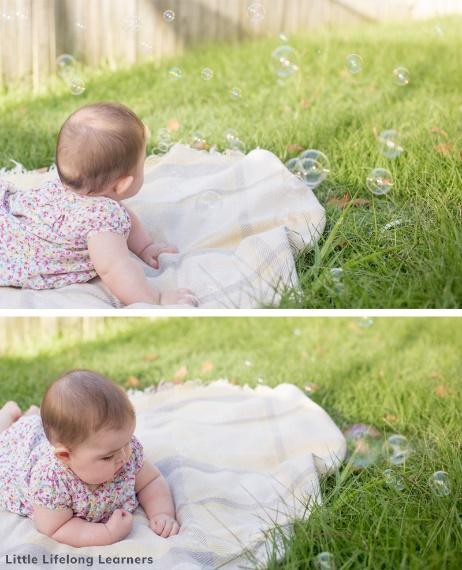
For babies that can’t sit, or crawl bubble play is still fun! Think of what a great option this would be to do with a baby while they worked on tummy time! What a great way to fit that into your day!
As babies are starting to cruise or pull to stand, they can work on going after the bubbles. When they are learning to stand independently bubbles are another great way to motivate them to shift their weight.
As your baby learns to walk, they will be able to move after the bubbles and squat up and down chasing after the bubbles!
The options with bubbles seem endless and such a great tool to use for many years!
Once your baby gets stronger on his tummy, he will start to reach out for the bubbles. Think of all the muscle strengthening and balance development going on as he attempts this! Bubbles also provide motivation to move. I’ve seen many a baby make their first forward movements, determined to get to that bubble on the floor.
As your growing baby starts to crawl, creep and cruise he will thoroughly enjoy chasing after bubbles. Crawling over, under or through obstacles to get to the bubbles encourages further development of muscle tone, body and space awareness and problem solving for your baby.
When your little one is learning to stand and walk independently, bubbles again provide many opportunities to work on developing muscle tone and balance as he moves after the bubbles, starting, stopping, changing direction, shifting his weight, reaching up and squatting up and down.
Fine motor development
Once your child can grasp, he will want to hold the wand. It does get messy, but any practice at grasping, holding and manipulating the wand in and out of the container helps the development of fine motor control, important for the development of the correct pencil grip, writing and working with tools in the future. Give him plenty of opportunity to do this with both the left and the right hands: Read why this is important here:
When will my baby become left or right handed.
Popping the bubbles, be it with the whole hand, two hands, a finger, a foot or a toe all involve the development of hand-eye or foot-eye coordination. These early movement experiences form the basic building blocks of the catching, hitting, throwing and kicking skills involved in ball sports.
Access more baby hand-eye coordination activities here.
Numerous studies point to the benefits of spending time in nature.
Regular exposure to nature reduces stress, increases physical and emotional well-being, and can even contribute to the development of empathy.
In the natural world, children can take risks and freely explore. They discover their physical limitations and potential.
They learn to slow down and observe the world, taking note of patterns and changes.
Urban areas present unique nature opportunities for families, such as mature landscaping, established parks, and community programs. Consider finding the hidden nature. Children are adept at finding nature in unexpected places. From the plants growing in sidewalk cracks to the bugs under rocks, take a cue from your child and challenge yourself to discover hidden beauty.
You don’t have to have a backyard to have fun outdoors with your baby.
I love to bring my little guy to the park. There are so many great motor and sensory experiences for a baby at the park. Here are 5 quick and easy things you can do at the park today!
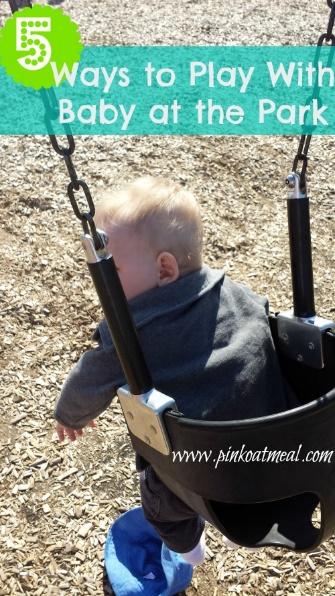
The Baby Swing
This is the most obvious and most parks have a nice swing for baby! Great for the sensory system. Think of all the great vestibular input your baby gets on the swing! You must feel comfortable with your baby’s ability to stay up when placing he/she in the swing.
Sitting and exploring the Woodchips
Lower Extremity Strengthening Exercises
A whole new sensory experience for baby getting to sit/touch/feel the wood chips. The woodchips promote balance challenge and core strengthening by sitting on that uneven ground! Just be careful none go in the mouth! Baby must be able to independently sit to do this activity.
Tummy Time
Yes! The Park is the perfect place to get your little one on the grass and on their tummy. Tummy time is number one in promoting motor development! Doing tummy time in the grass gives your baby a whole new sensory experience too! Grass is a lot different than your carpet or wood floors!
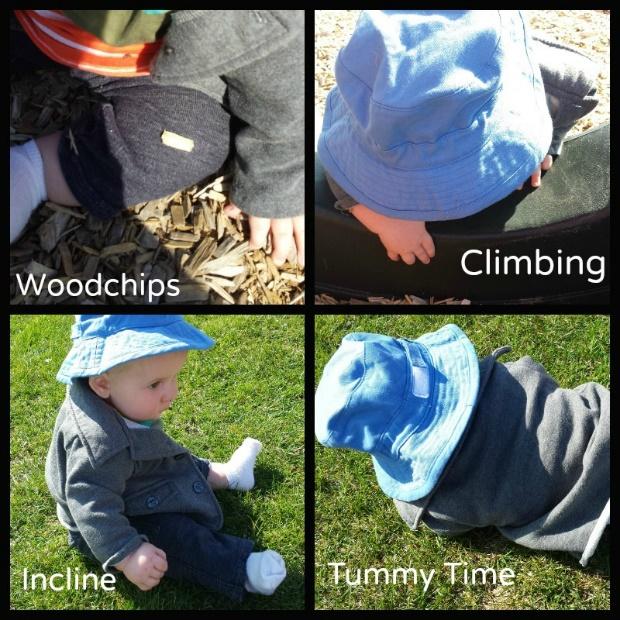
Sitting on a Slight Incline
Find those small changes in elevation in the land and sit your baby on it with their feet pointing up the hill. Sitting in this reverse direction promotes great core strengthening for your little one. You must feel comfortable with your baby’s sitting skills for this activity.
Climbing
Check around your park and see if there are any of those low-level obstacles that you can play on with your baby. If your baby is starting to pull up and move over different obstacles in the home, why not challenge your baby at the park!
I easily spend 20-30 minutes at the park with these quick things to try with your baby. My little guy loves them all. On top of that he gets to watch all the people that come to the park and smile and flirt with them. Just another added bonus of the park!
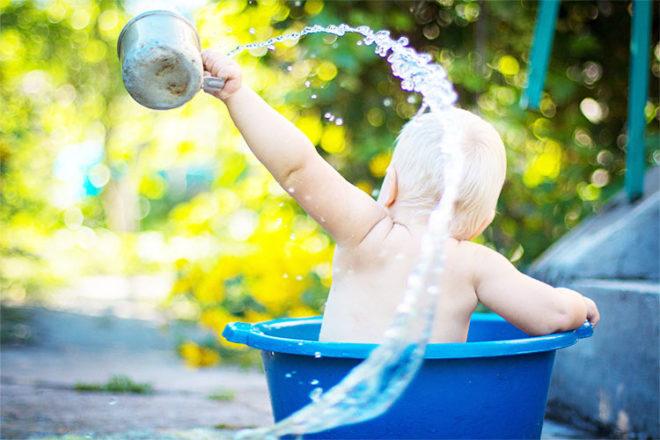
Let your baby play in a plastic bucket or small tub with some water safe toys and watch them learn! When we do ours we aim to make them Treasure Baskets of sorts and group a couple of items together. A few things we have tried are bottles and cups for pouring/sieving, different textured sponges and foam/bubbles. For explosive foam try mixing your water and soap with your kitchen hand blender before putting the baby in!

Invite a few friends to a picnic in your favorite outdoor spot. Pack up a few of your favorite story books, grab a cozy blanket and head out into the garden or a park for storytime! This has always been one of Alfie’s favorite activities, you can see a list of our favorite garden stories here. Bonus points if you bring treats!
This takes a little time but is so worth it. Set up a bird feeder in a quiet but easily visible corner of your garden. Once a day or two has passed the local birds will know where to look for their goodies and you and your infant can spend a surprisingly long time watching them come and go, it sure beats the TV! Watching Hope following the birds was amazing, she was so focused. It was proof of Dr Montessori’s words “When a child finds something that interests him he loses his instability and learns to concentrate.” (The clear window feeders are lots of fun!) I ordered ours from Amazon with a book about birds so we could look them up and learn about them. BTW deer like birdseed too. So we took ours down when she went to bed after I woke up one morning, with a buck scraping his horns on the window trying to get to the seed.
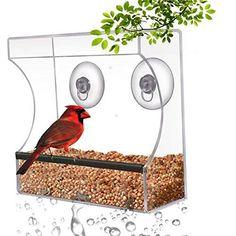
Break out the bubblesI do not know a single kid who doesn’t enjoy bubbles. Babies are no exception! Little Man is at a fantastic age where everything is interesting to him, especially things that move. He is fascinated with bubbles and can’t seem to get enough of them. Sit the baby on a blanket in a shady spot and just go crazy with the bubbles. It will be a blast for both of you (do not forget to take pictures!).
HINT: Here's how I made my own no tears, all natural bubble solution so that he could see and feel bubbles pop on his skin without the risk of stinging her baby blues.
-1/2 cup water -1/2 cupSeventh Generation Baby Bubble Bath (make sure it is the bubble bath and not the baby wash). Mix these together gently in a jar or Tupperware. Add some bubble toys and VIOLA-happy kids.
Ways to Bring Nature Inside
Let them help be a part of the whole process of collecting and assembling
and then investigating nature inside your home
Nature Sensory Bottles
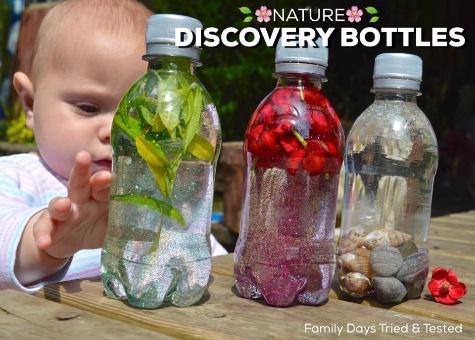
These were a real treat in our house. Simply choose which sense you’re going to activate and fill small clear jars with either flowers (sight), herbs (smell), grains (hearing) or anything that will surprise your little one! I used empty spice jars or plastic jars from Dollar Tree. The grains were a big hit as they made lovely gentle sounds, which she preferred over loud, synthetic commercial ones. I used smaller spice jars when the kids were babies. Fill bottles with water and your natural treasures and tighten the cap securely.
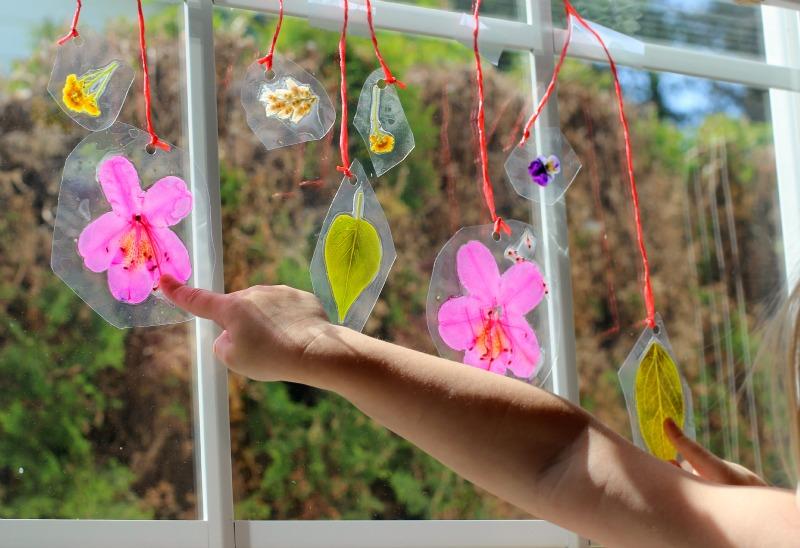
Simply trim the stem off a few flowers as tight as you can to the bud then run them through the laminator (or press them in a heavy book for a few days then use clear contact paper folded over the flowers. I cut all my sheets to the same size to make it easier for children to sort through. She really enjoyed studying each little bud and leaf.
The girls made theirs into a suncatcher garland& loved exploring the flowers with magnifying glasses and comparing the flowers and leaves. Beautiful right? I love spring crafts because they bring so much color into the house!
Baby Nature Blocks
Hope was a happy baby who loves simple games like that (as do most babies. Blinking lights and flashy toys are really not necessary!)
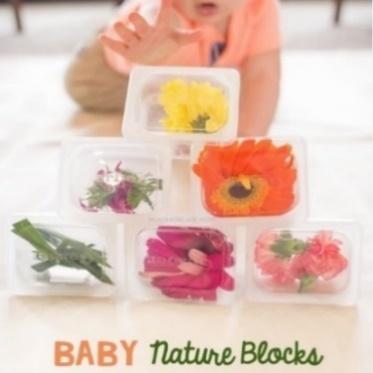
But sometimes mama just wants to get crafty and make a new toy for baby. I did that today with a grocery store bouquet of flowers and some upcycled baby food containers!
How to Make Baby Nature Blocks
First off, this is going to be the easiest toy to make! I barely need to make a “how to” section on this post. But I know how much some of you like details, so here goes:
Supplies:
Flowers (I used a grocery store bouquet) or other nature
Baby food containers (Gerber’s plastic ones work well)
After the food containers were empty and had been washed, I just placed a few flowers and leaves inside of them and snapped the lid back on. That’s it. The hardest part of this whole activity is having flowers on hand.
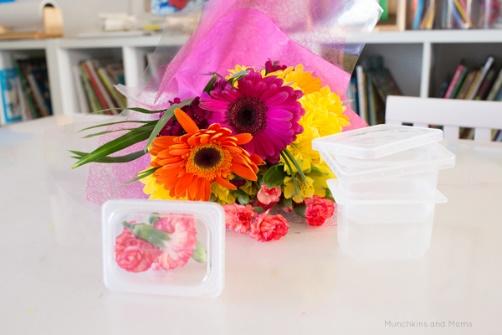
The next step was introducing them to baby. He was soooo happy! He knocked over every tower I made, threw them across his mat, investigated them from all angles, banged them together, etc.
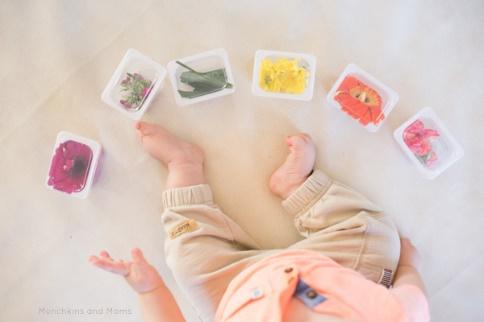
These blocks are so inviting! The way the light shone through them, the vibrant colors of the flowers, and the way the petals gently swished as he shook them made them extra intriguing for our little guy <3
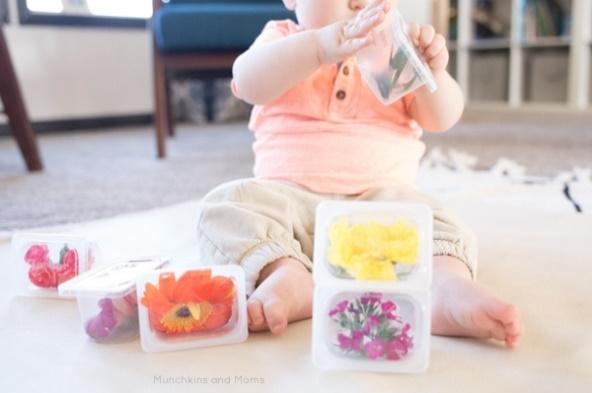
I know some of you will ask how long these blocks keep for. The truth is I don’t know. We just made them yesterday, so I’ll test them out and update you all later.
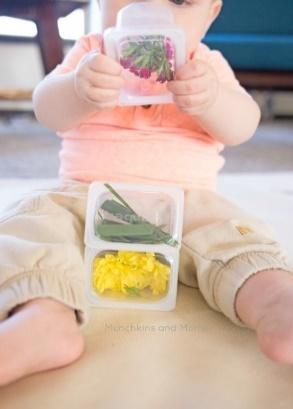
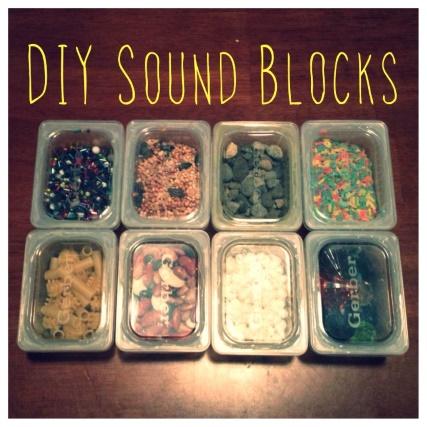
Sound blocks can be made with the same process. The eight sound blocks I made were filled with nature, rice, beans, pasta, birdseed, shells, pea gravel, beads, and colored gems. You could use any materials you have on hand though that you feel would make a neat noise when shaken. I think next I’d like to make one with bells inside!
Nature Sticky Mural
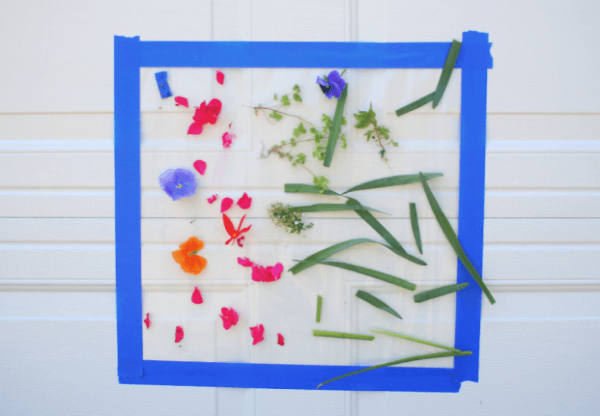
Nature is art, and you can also create your own custom art with elements from nature! I can Teach my Child has a lovely idea for an outdoor mural where toddlers can stick leaves, petals and whole flowers in any pattern of their choice. You’ll need contact paper for this activity, which you can stick to a wall or solid gate outside. Hand the children the materials and let them create art!
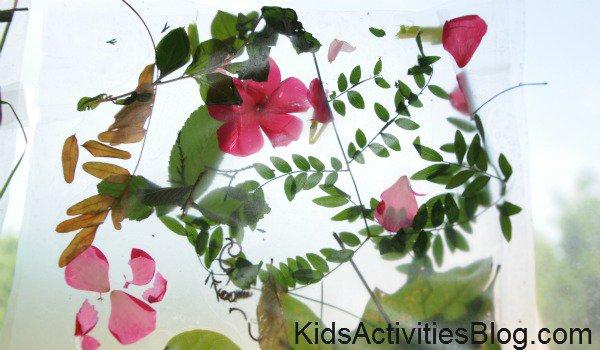
Collages are among the easiest craft projects for toddlers and preschoolers, and this one from Kids Activities Blog is no different! However, what’s special here is that you use only natural elements to make the collage! They have used contact paper to make the collage do double duty as a sun catcher, but you can just use a sheet of thick paper or card stock as well. Use fresh flowers or dried ones – they’ll all look pretty!
Nature Sensory Bag
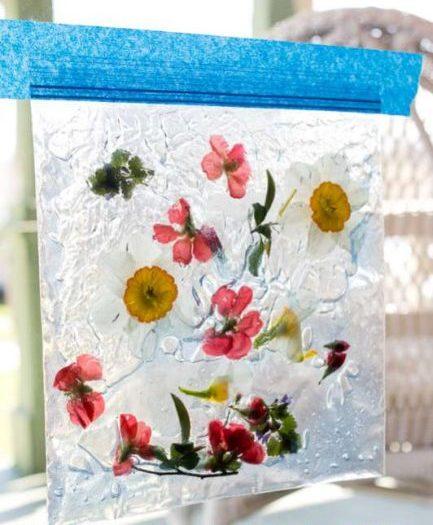
Sensory bags are a great way for babies to explore and learn to focus their attention. This sensory bag from Hands On as We Grow also doubles as a sun catcher – just stick it on window! Gather the materials by doing a scavenger hunt or a nature walk and use double bags especially if you’re dealing with over-excited toddlers or babies! You can focus on using different textures here, so it’s more fun to squish and move around!
Scent Jars
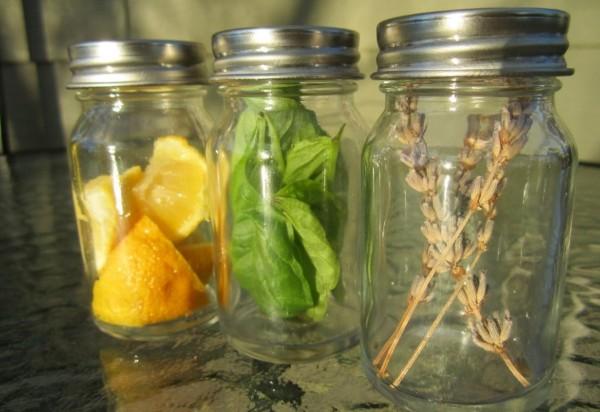
This is an excellent sensory activity for toddlers and preschoolers and helps them learn about different scents. Mamas Happy Hive has used lavender, lemon and basil, but you can use any scent of your choice. Just use clean, dry glass jars, add a piece of lime or a spring of lavender along with the associated essential oil. Hand the jars to your child and let him sniff and guess!
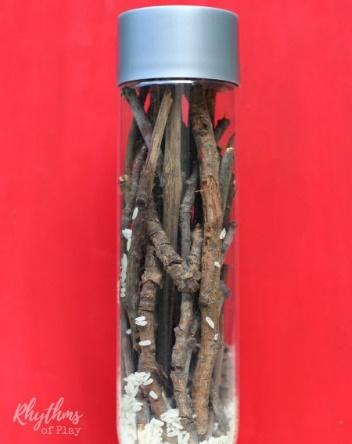
Sensory bottles are a great option for babies and toddlers, and we love this one from Rhythms of Play! The best part is that you can make it with things lying in and around your house. Get a transparent plastic bottle so kids can see all the components even while they’re shaking and playing with their rainstick. With the rains coming soon, let them get used to the sound of falling raindrops!
Nature Soup
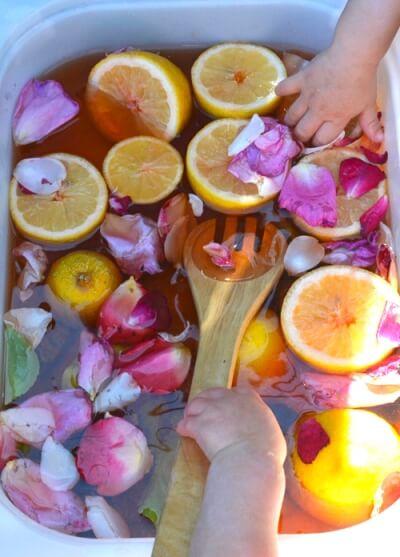
Who doesn’t love water play? We bet your little one does and that’s why she’ll love this nature soup activity from Meri Cherry! This is basically a water based sensory activity, where you create a ‘soup’ with all kinds of elements – lemons, leaves, flowers, twigs and more! Put it all into a large plastic tub with colored water, and then hand them utensils and brushes to swish everything through. Let them stir, sieve and pour to their heart’s content!
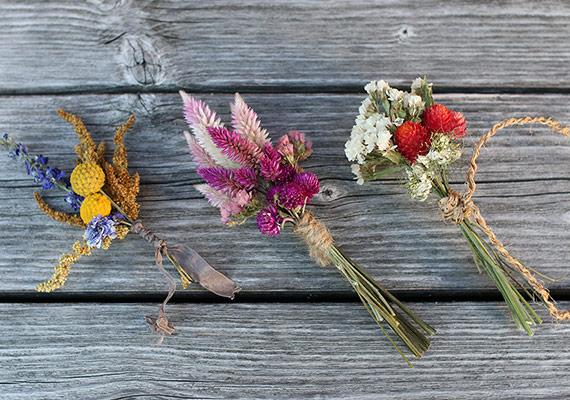
Dry herbs and Flowers from your walks and adventures
Hand drying, the oldest method, is also the easiest and most effective method for drying anything: leaves, flowers or herbs. Hang drying is also good for drying large quantities. You can tie and hang dry flowers in a closet, attic, dry cellar, garage, outdoor shed, or anywhere that is dry, warm and out of strong sunlight. Use for wall hangings from a stick or small branch or display in a vase.
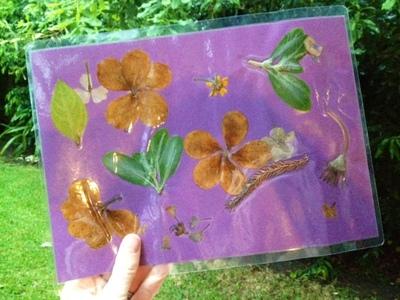
Make placemats to spread your love of nature
It could become an ideal gift for any occasion. Older children will manage this easily on their own but younger children will need help from an adult with the lamination process. It takes a week or so to dry the flowers, so you'll also need to plan to set them aside and be patient.
See more nature crafts at the end of this book

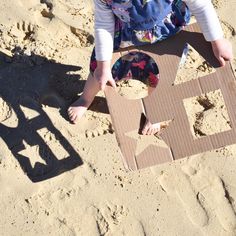
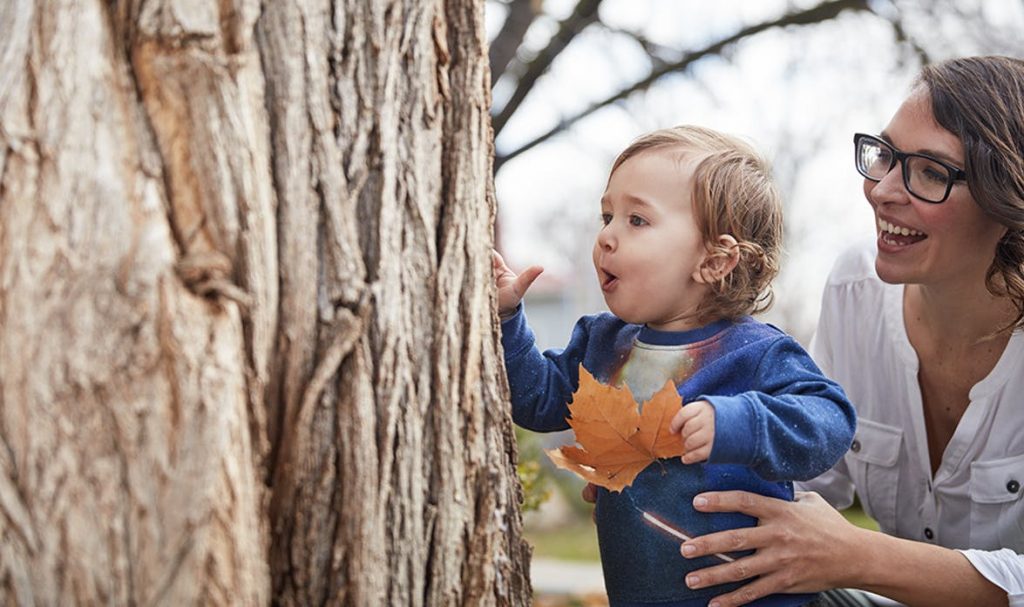
Baby Infant Nature walk Activities Hike
Neighborhood or nature walk
Taking Baby for a Walk
NOTE: I always tried to stimulate three senses in the way we enjoyed the world and our day. So, if something catches their attention visually try getting them to touch, smell, hear or taste it and triple their excitement and fun. I do that with all kids, but for Hope it was virtually essential. We did not realize how bad her eyes really were until later in her life. But by stimulating the other senses Hope was used to adding other ways to experience things that interested her. She even somehow manages to portray how she enjoys her world through her art. She learned to process life in three senses, and she continues that as a life skill as an adult.
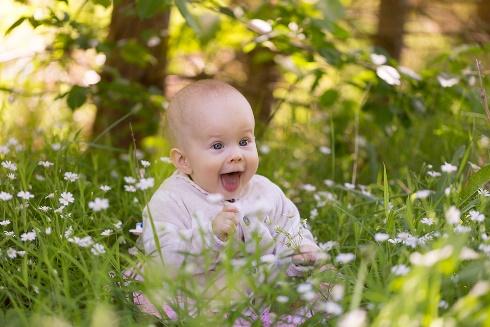
Have you ever noticed your baby’s mood lift when you take them outside? Sunshine and fresh air have well-documented benefits but being outside is good for your baby for other reasons, too.

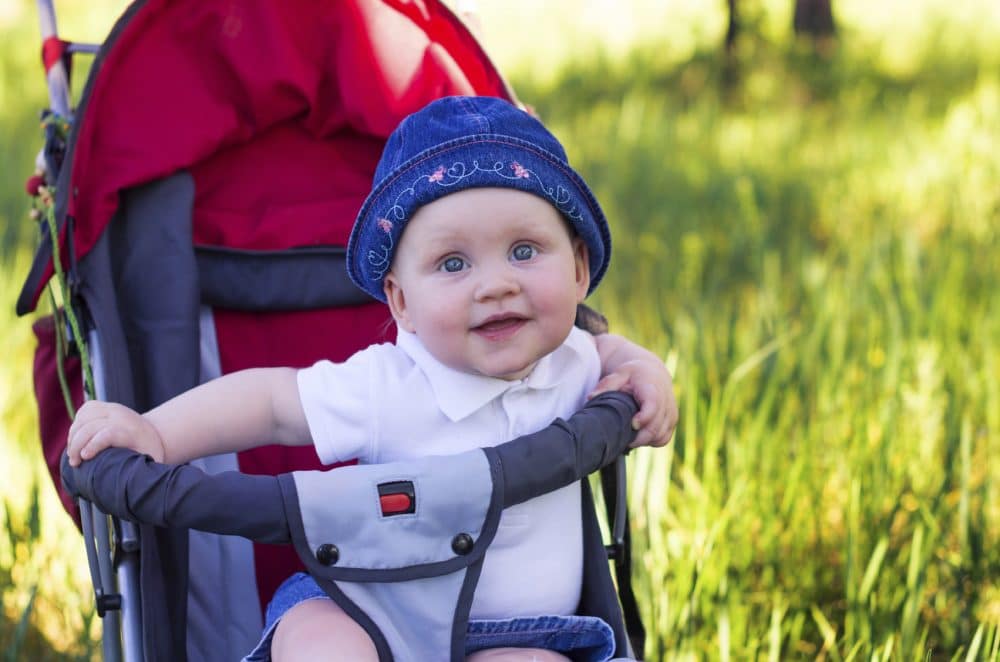
Spending time outside can also improve language skills—and maybe even their sleep
If you do not happen to have immediate access to nature, do not worry about your baby missing out. Simply being outside in the midst of a busy city can give your baby as many benefits as a walk in the forest.
Here are some of the many reasons to take your baby outside:
New sensations lead to brain development
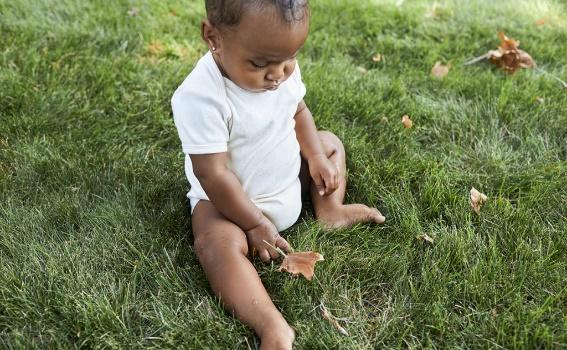

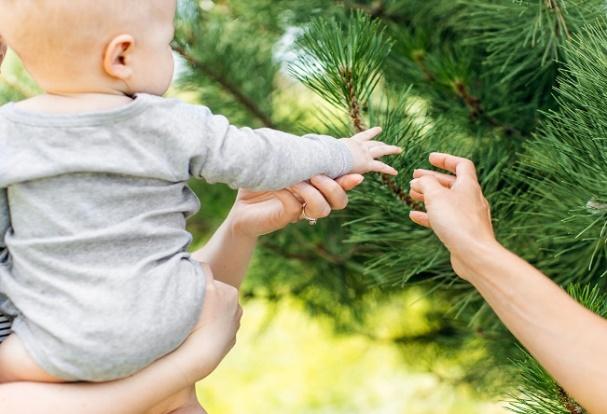
New sights, sounds, smells, and textures are enjoyable and exciting for your baby. Even if they’re strapped to your chest or reclining in a stroller, they receive all kinds of stimulation outside that they do not get when they’re indoors. This stimulation also helps build the synapses—connections between cells in your baby’s brain—that are crucial to cognitive development. Even just a walk around a city block can offer as many distinct, new, and unpredictable sensations as a walk in the woods.
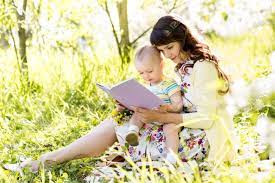
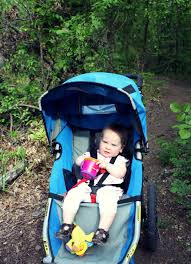
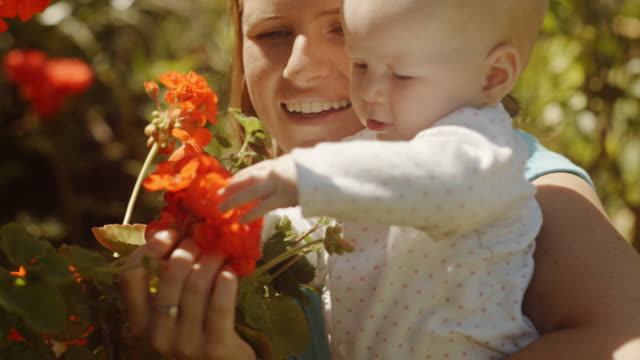
Remember to prepare your baby for new experiences with nature related books, videos and any other media that your child enjoys. Maybe a miniature pond or other small world wild waters and wetlands or forest treetops full of flying birds and bugs. Even the dirt and plants interest them when furry creatures or slimy ones scamper and run about. They are being taken to a new and exciting place with all sorts of new things to explore with their senses.
New language opportunities
Spending time with your baby outside also provides new opportunities for language development. As you walk around, narrate what you see and try to react to your baby’s sounds and gestures. Known as “serve and return,” this kind of early “conversation” with your baby can have a major impact on their language and cognitive development.
A 2014 study found that infants and babies are more likely to try to verbalize experiences they’ve had outdoors: “When an infant feels the leaves or the toddler notices the airplane in the sky, they are more inclined to verbalize this experience because it will elicit a favorable response by their caregivers.”
If your baby looks at a tree, for example, get close and invite them to reach out a hand to touch it, describing what they’re seeing and feeling: “you’re touching the bark of the tree. It feels rough, doesn’t it? The bark helps protect the tree.” If your baby reacts to a sound, try to find the source and name and describe it; if something captures their gaze, try to go investigate.
Exposure to sunlight plays an important role in how our bodies secrete melatonin, often referred to as the “sleep hormone.” A 2004 study in the Journal of Sleep Research found that “babies who slept well at night were exposed to significantly more light in the early afternoon period.” Particularly if you have a fussy baby, time outdoors in the afternoon—leading up to the “witching hour” (late afternoon into evening)—can help regulate their sleep-wake cycle. Exposure to direct sunlight can help establish your baby’s circadian rhythms more quickly than if they’re indoors all day.
Resources
Sleep Study (Journal of Sleep Research)
Early Brain & Motor Development (Journal of Physical Education, Recreation, and Dance)
Outdoor Play Environment in Early Childhood for Children (European Journal of Social Sciences Education and Research)
The idea that newborn babies should stay inside is simply an old wives’ tale and completely false. Getting fresh air and natural sunlight is good for both you and your baby, no matter how recently she was born. In fact, there is no medical reason not to take her outside the day after you take her home from the hospital, if you both feel up to it.
Given the choice, many kids would say yes if we asked them - others will fail to answer and jump straight in. This may be hard to hear – the germs, the mess, and the task of cleaning up – but did you know that allowing children to play in the dirt is important to their development, and their health?
Here are 5 reasons to let your baby get dirty.
1. Lower stress levels
Free, unstructured outdoor playtime is great fun, and it can also help relieve stress and anxiety. A recent University of Queensland study suggests that people who visit parks for 30 minutes or more each week are much less likely to have poor mental health than those who don’t.
2. Keep them active
When allowed to play in the dirt, your children are likely to be running, jumping, crawling, and cartwheeling through it – not just making mud pies! This activity is highly important in child development.
3. Influx of vitamin D
Playing outside in the dirt will often mean more time in the sun (and an influx of vitamin D — something we all need to protect the health of our bones and immune systems. As taught in Harold’s Summer Holiday, sun safety is important, but not getting enough time in the sun isn’t healthy either.
4. Boost their immune system
Research shows that playing in (or even eating) the dirt can strengthen young immune systems.
"Without exposure to everyday germs, which can be found in mud, children miss out on building a stronger, more robust immunity to sickness,” Dr Ryan Harvey from House Call Doctor explains.
5. Happiness is priceless
It will only take a second. The smile on your child’s face as they run, jump and skip carefree reinforces: Playing in the dirt is fun!
However, you should take some precautions and implement certain restrictions in order to keep your baby healthy. Here are some guidelines for where to go and not go with your newborn, how to dress her appropriately, and how to protect her from the elements.
Playing Safely Notes
Avoid Large Crowds
While it is fine to go out in the yard or to a quiet park, you'll want to try your best to avoid places where there are crowds for the first several weeks of your baby's life.
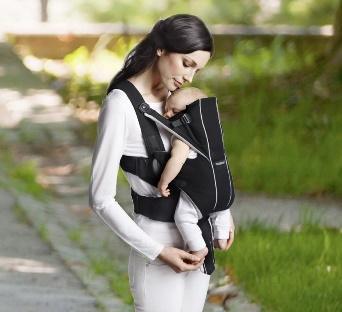
The younger she is, the more immature her immune system, and the more susceptible she is to pick up germs from other people and nearby coughs, sneezes, and unclean hands. Once your baby reaches 2 to 3 months, her immune system will mature significantly, and you won't need to be as concerned.
Babies are irresistible, which means strangers may want to touch and play with her—leaving you with less control over what she's exposed to. So, keep that in mind before you head to the mall or the local swimming pool. A good way to protect a baby from strangers' germ-filled hands is to wear baby in a sling or carrierfacing you. When friends and family want to hold your baby, insist that they wash their hands first.
When You Get Home
When you get home from an outing, be sure to wash your newborn's hands, especially if anyone has touched her. It would also be a great idea to wash your own hands, to avoid transferring anything from yourself to the baby. Some parents feel better giving their baby a bath after coming home from excursions, especially shopping trips to the grocery store or mall where the baby may have been exposed to germs.
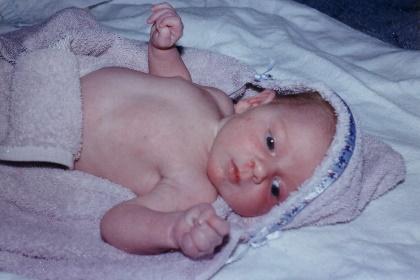
Protect Your Baby from the Elements
Whether it is winter or summer, facing the elements without the right protection is never a good idea. Here's what you need to know for the different seasons of the year.
In Winter
It is perfectly safe to take the baby outside in the winter, provided she is bundled up properly (as discussed above), the temperature isn't too cold, and you keep the trip brief. Sometimes babies need a few gasps of fresh air and natural light, especially if they are colicky.
Use caution in cold weather. Babies are at an increased risk of hypothermia, due to their still-developing nervous system, minimal amount of subcutaneous fat, and an inability to shiver to bring up their body temperature. If the weather is freezing outside, you may still take the baby out for quick trips out, provided the wind chill factor is above 20°F. Do not stay out for longer than a few minutes.
In Spring
Spring is a wonderful time of year to have a newborn. Winter's cold has started to thaw, and the days are getting longer. This is an ideal time to enjoy a walk or trip to the playground with older kids.
Spring days can be deceptive though. A bright and clear day can quickly give way to gusts of wintry air, or a sudden rain shower. Always check the weather before taking the baby out in the spring and be prepared with an umbrella for the stroller, extra blankets, and a change of clothes in case you get caught in an unexpected downpour.
In Summer
In summer, you want to protect your baby from the sun, excessive heat, and mosquitoes. On hot summer days, try to avoid going on in the heat of the day, and instead try to time outdoor activities for the morning or late afternoon. If the thermometer reaches 80°F, head inside.
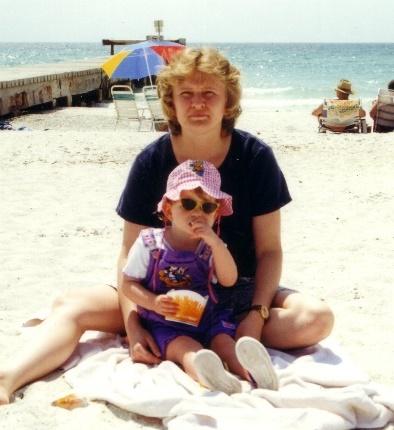
Babies under 6 months of age should never use sunscreen, so you'll need to keep the baby in the shade and use a sun hat. When taking a walk or going to the park, use a stroller with shade and check to make sure the baby isn't in direct sunlight at any time.
If your area has a lot of mosquitoes, you may want to use a mesh net to cover the stroller or pack-n-play in the back yard but be sure the mesh is away from your baby's face.
In Fall
Just like springtime, autumn can be a great time to have a baby. The temperature is moderate, with lots of sunny days and colorful leaves to enjoy. However, the weather can change quickly on fall days as well.
In early fall, chilly mornings can give way to summer-like afternoons, while in late autumn, bright sunny days can have a deceptive winter chill. Layering is key in fall weather, so be sure to have extra blankets with you to keep your newborn warm outdoors.
Having Fun in the Sun (Safely!)
Summer is so much fun! It is time to get outdoors after a long winter and enjoy some fresh air and sunshine! Unfortunately, a sunburn can make for a pretty painful end to a long day of playing. So, make sure with all your summertime activities you are taking steps to protect your baby's (and your own!) skin.
Young babies especially have a hard time with the sun. If your child is under six months old, try to keep them out of direct sunlight. Find a place under a shady tree, use an umbrella, or make sure the canopy on your stroller is up. Covering the baby's head with a hat--a light colored hat with a brim will keep the baby's face in the shade and it is great if it covers the baby's ears too!
It is best to dress your child in clothes that are lightweight and in light colors (to prevent overheating) but will cover and protect the most amount of skin. For young babies (under 6 months), sunscreen can be applied to small areas of the body that aren't covered by other clothing (such as the backs of the hands, tops of feet, face, and back of neck). Older babies and children can have sunscreen applied to all areas of the body (just be careful of those sensitive eyes!). If your baby has sensitive skin (and many babies do), consider a sunscreen that has zinc oxide or titanium dioxide.
Always apply sunscreen 15 to 30 minutes before going out in the sun, and make sure you rub it in well everywhere that will be exposed to the sun. There are places that often get forgotten, like the backs of the knees, tops of feet, or the ears, so make sure they do not get left out! Reapply at least every 2 hours to ensure that you are getting the protection you need. Once your child is covered head to toe (remember, you can get a sunburn even on cloudy days), get out there and enjoy your summer.
FOR MORE DETAILS on an easy DIY shelter from the sun CLICK HERE
Add a baby blanket and toy storage and you have a baby oasis for fun.

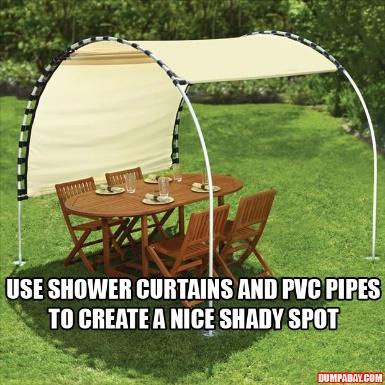
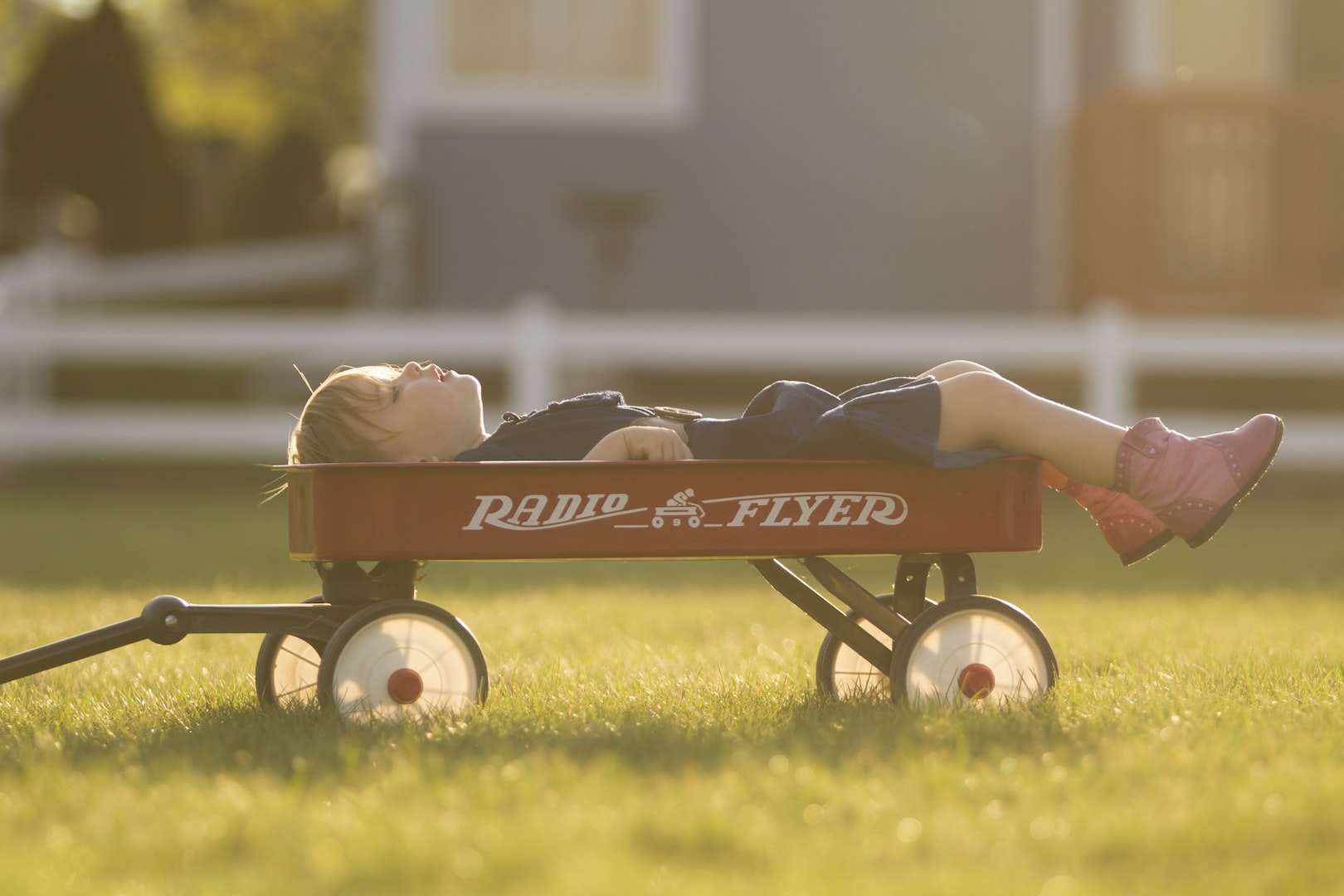
Superscript
Fun in the Sun
Backyard or Park Play
Baby and ToddlerTips &
Outdoor Play Inspiration
How to encourage nature interaction between you, your babies and nature?
Because babies are still taking in the world, don’t overwhelm them with too much all at once. Let them explore slowly. They might want to crawl around or be happy sitting in one spot. And since they are just little babies they won’t be too bothered if you bring them to the same old park bench or backyard spot time and time again!
When you’re down on the ground with your baby pick up things and hand it to them to explore, like leaves, larger rocks, and pine cones. You can point out birds or describe how the breeze feels on their skin. Direct them to look at the dancing leaves or the bright flowers. You are simply a guide for them… connecting words and feelings to what their senses are discovering.
However, if you find visiting the same places boring, try sightseeing in new parts of town, check out farmer’s markets, take a walk at the botanical gardens or zoo, visit outdoor festivals, and start exploring your local nature trails if you haven’t already.
If you’re a person who needs a little more motivation and company to go out for walks you might want to look into Hike it Baby. This organization has hike coordinators all over the United States and Canada who arrange group walks for young families.
You can also include nature at home too. When you’re reading books to your babies, find books with plants and animals in them. Describe how they look. Make the sounds. Talk about whether you see these things outside or not. These are little ways to start bringing nature into the home and into your interactions with baby so when you head outside you will be more likely to also take note of these things.
The short of it:
When your children are just babies getting outside should be easy. Don’t overstress and plan. Remember, simply sitting in the grass and feeling the breeze ruffle their hair is exciting enough for them. Instead, use this time to get yourself comfortable with bringing them outside. Figure out how to go for walks and do it regularly.
Creating a routine helps set the standard for your child as they grow into the more adventuresome toddler years and you’ll be more likely to continue heading out with your littles if you’ve gotten comfortable with the process already.
You don’t need any fancy gear and you don’t need to organize nature activities. Instead, let your baby’s eyes, ears, hands, and feet do all the work.
Exploring nature with babies can be a simple as you make it. A walk around the block, a blanket on the grass, a visit to the neighbor’s garden. The important thing is to just get outside and start.
Fun in the Sun
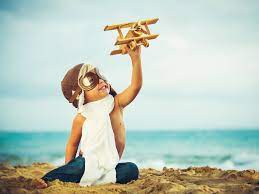
Summer should be all about fun, getting outside as much as possible, and taking things easy. So, I would like to give you a list of simple ideas you can refer back to as many times as you need to keep the littlest ones in your family busy this summer so you can enjoy a little relaxation as well.
Enjoy a meal picnic style
Blow bubbles
Play in the sprinklers (Check out primary.com for some amazing swimsuits and baby rash guards)
Create DIY puzzles
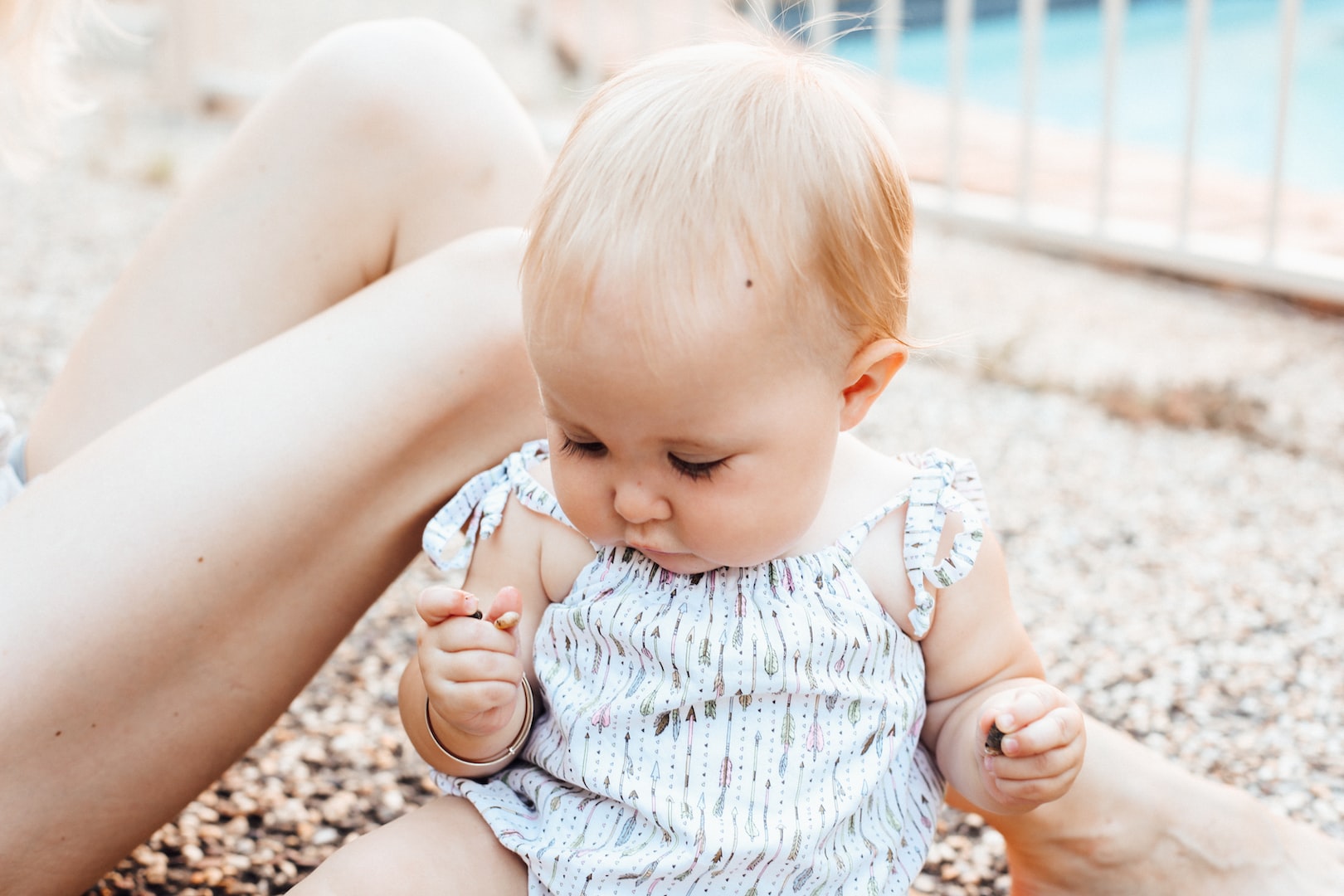
Take a trip, even just a road trip to a local spot
Take a walk
Visit a park
Play with Pom Poms
Play musical instruments to music (make instruments if you don’t have any)
Have a dance party or jam session with anything that makes a noise
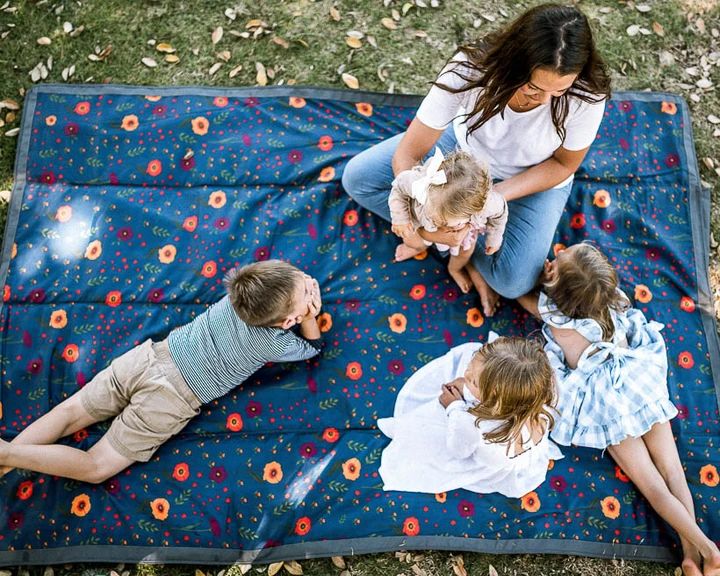
Create a scavenger hunt (bug stickers, sticks, stones, flower stickers etc)
Read nature themed books outside
Make a playdough patch to play on
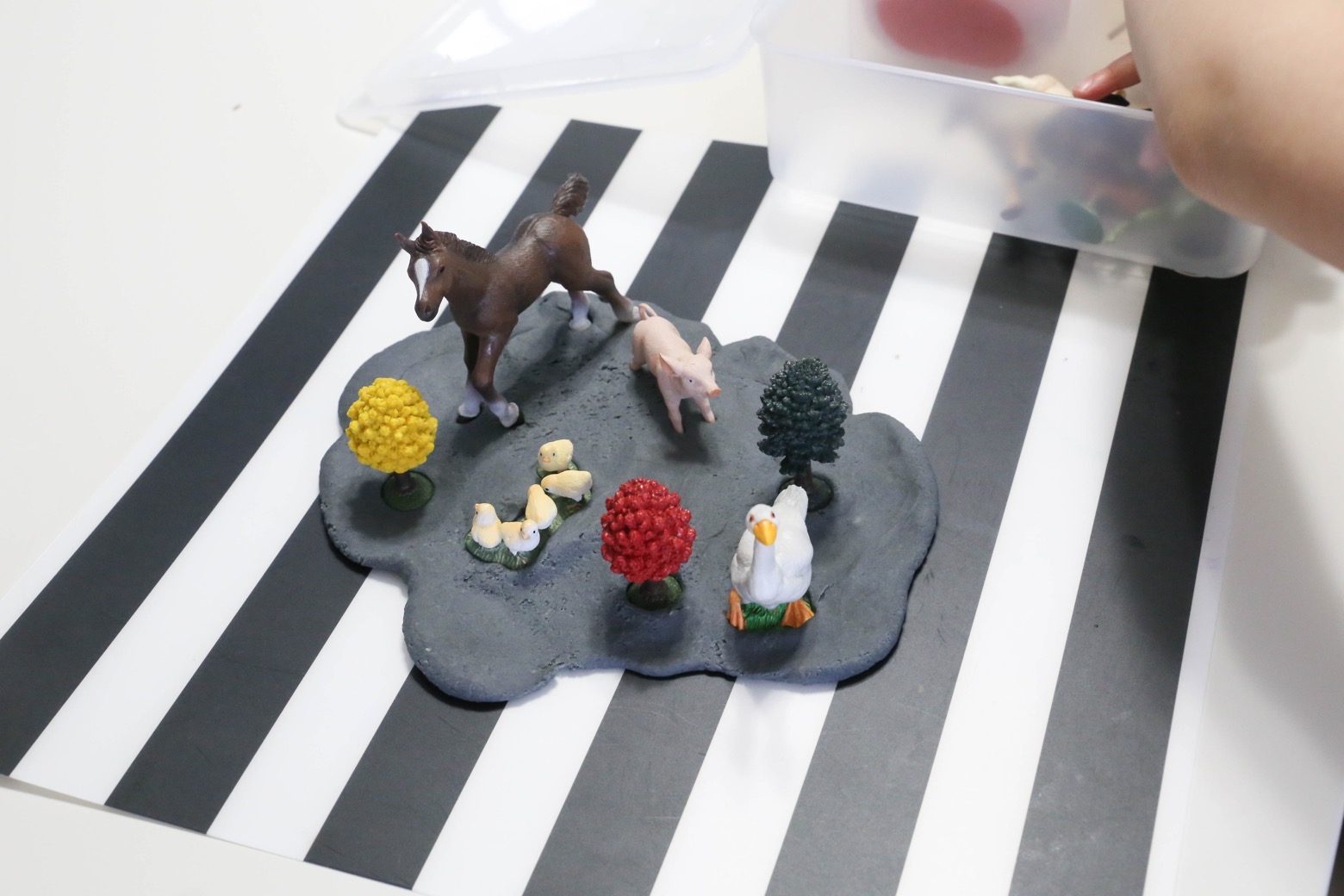
14. Hide toys in Jell-O for a fun sensory experience
15. Plant a fruit or veggie
16. Go swimming (Check out primary.com for some amazing swim suits and baby rash guards)
17. Make your own ice cream
18. Get them involved with cooking or baking
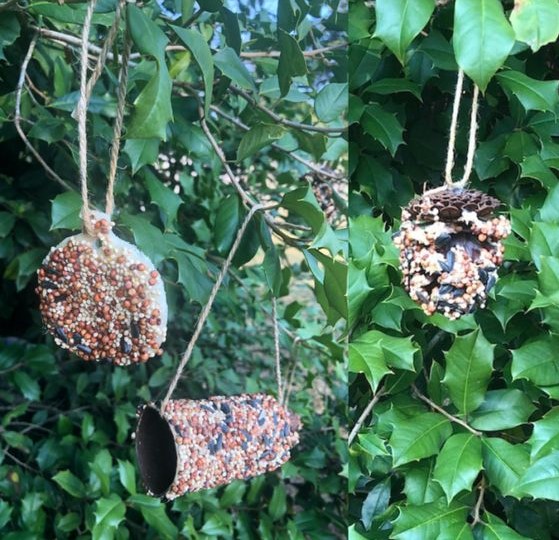
19. Make a bird feeder
20. Pick some flowers show them how to add water and flowers in a vase
21. Make an nature observation and sensory bottle together
22. Make nature confetti together with flowers or leaves-have them scatter it across their name in glue
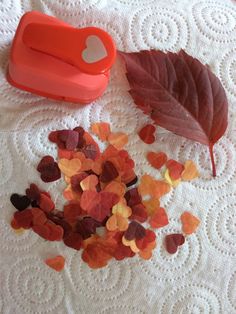
23. Do some mess-free painting by placing paper and paint in a Ziploc bag
24. Do some yoga (check out Cosmic Kids yoga on YouTube)
25. Wash toy cars or animals in warm water outside
26. Make tea and have a tea party for grandma or a favorite aunt
27. Make a sticky paper garden project taped to outside of door or a low window
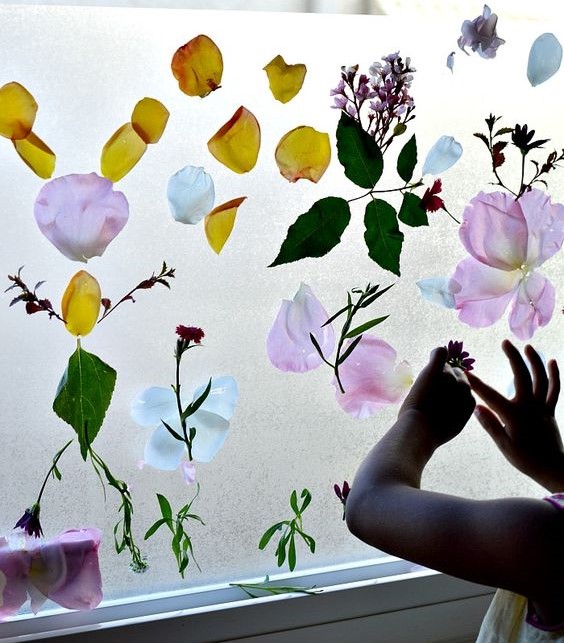
28. Make playdough use nature to make silly faces
29. Play with playdough with nature items
30. Go on a nature treasure hunt BUGS, FLOWERS, STONES, STICKS etc.
31. Play with sponges and water (See 10 Ways to Play with Sponges)
32. Create a ball or bean bag toss game
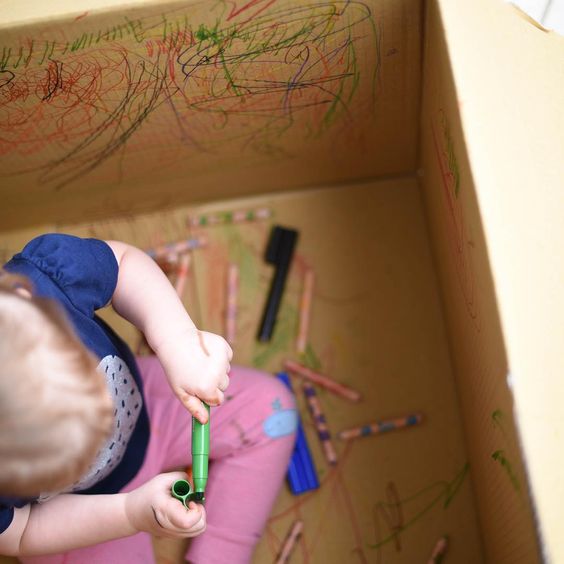
33. Draw in a box
34. Make a fort or tee pee
35. Use loose parts in sand, water, or playdough
36. Create “potions” with color mixing water and nature items
37. Bang pots and pans
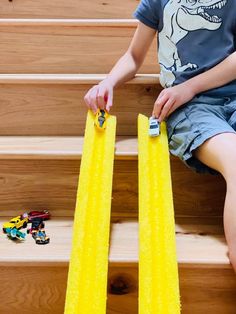
38. Create a ball or car ramp with pool noodles play together
39. Make a tape road and play with cars on sidewalk or driveway
40. Have a stuffed animal tea party
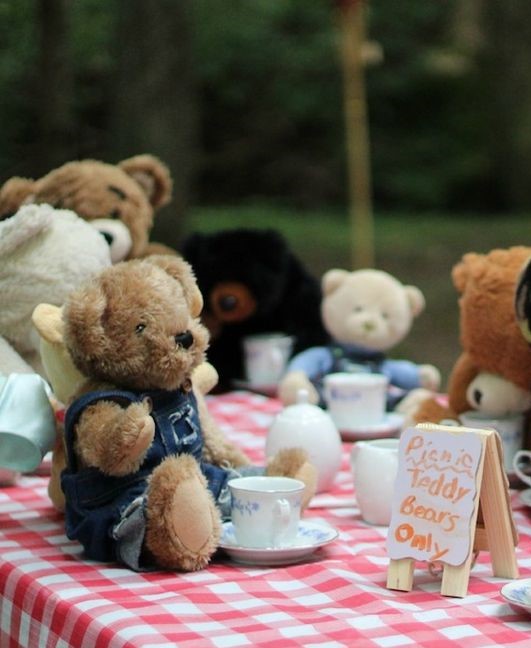
41. Use recyclables and tape to create a new toy
42. Pretend play grocery store in your pantry
43. Play with water in the sprinklers
44. Pour colored water from one container to another and make new colors
45. Use a kiddie pool for something other than water
46. Sing songs
47. Create a “treasure basket” with items around the house
48. Explore cold and warm items
49. Finger paint with edible paint
50. Play with raw or cooked pasta
51. Play with stickers
52. Play with Duplos in water
53. Make “sand” by blending crackers or oats (See my Edible Sensory Beach idea)
54. Tape pictures of friends and family to blocks (See other ways to play with pictures)
55. Use glow sticks in the bathtub
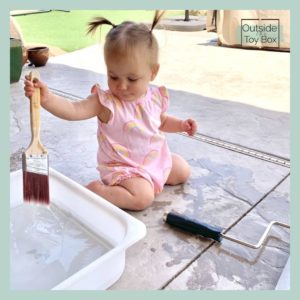
56. Paint with water
57. Eat a popsicle (we made ours with watermelon and almond milk. We used our Grabease utensils which made for perfect toddler-sized popsicle holders)
58. Mix colors with colored ice cubes in the tub or on a paper plate
59. Paint with something you found outside (flower, stick, leaf, etc.)
60. Make quiet blocks with pool noodles
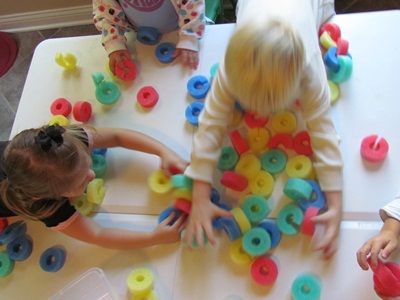
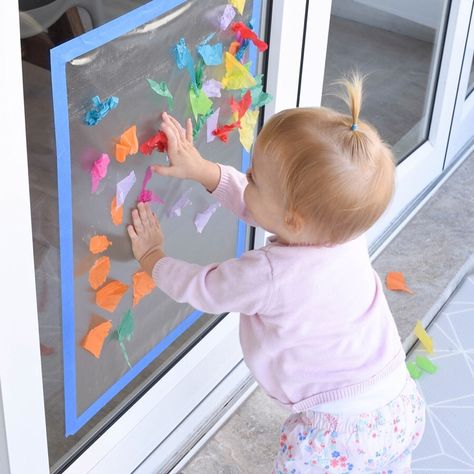
Superscript
Babies Love Autumn
Use this guide to plan your perfect fall with your baby. Full of baby sensory activities for fall including fall crafts, autumn books and seasonal food favorites.
Why Fall is a Great Time of Year for Babies
Gone are the days where you have to worry about heat and too much sun exposure – enter cool weather, crisp air and new experiences for you little one.
1. Sensory Opportunities Everywhere
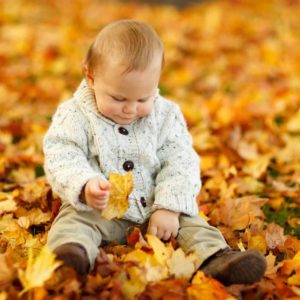
Leaves, pumpkins, pine cones and apples are all wonderful opportunities to expose your baby to new textures, tastes and smell. Below is a collection of baby sensory activities to try this autumn.
Baby Pumpkin Carving Sensory Activity
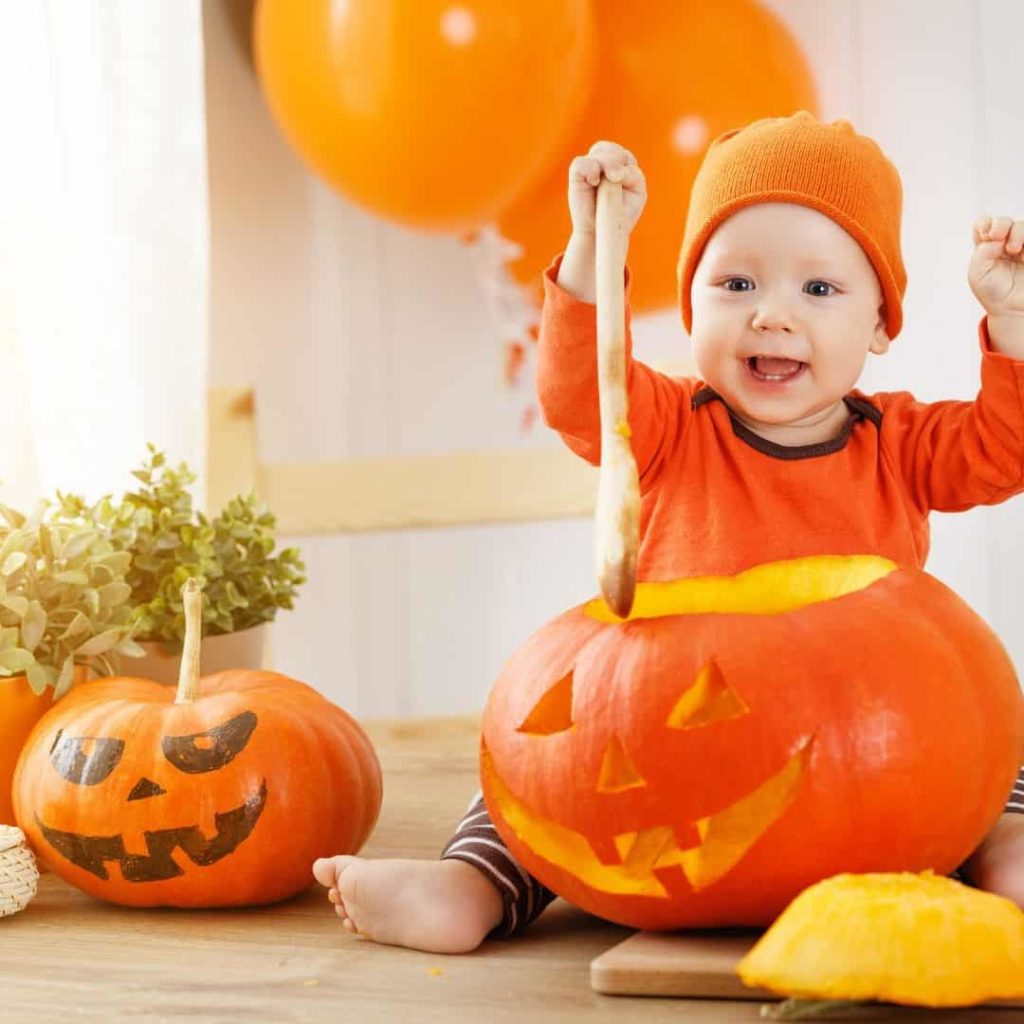
Let your baby help you while carving a pumpkin. Place a towel or sheet on the floor underneath your pumpkin (top removed). Let your baby sit next to the pumpkin, give them a spoon and bowl or let dig with their hands.
PREP TIME 1 minute
TOTAL TIME 1 minute
Instructions
This is a clothes off activity – they will get messy, probably try to eat some pumpkin (no harm – just watch the seeds) and will throw the pumpkin guts around
Set your baby up on the floor (keep close by to keep them safe). If its warm enough you can head outside.
Give them a big spoon and bowl
Have the bath ready and don’t expect them to scoop out the whole pumpkin – the younger the baby the shorter the activity
Baby Fall Scents Sensory Activity
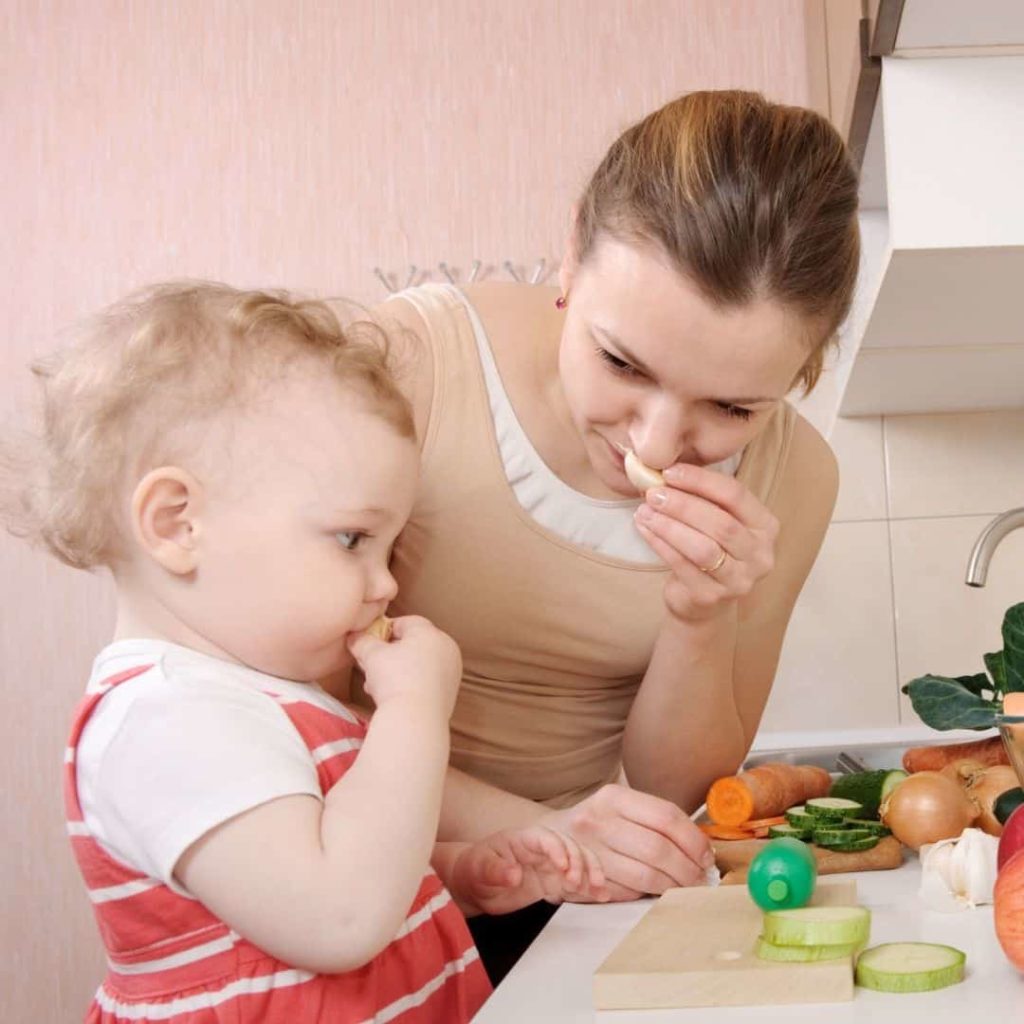
One of baby’s most advanced senses at birth is their sense of smell (they learn their mama’s smell very quickly and that’s why you can calm them down with a shirt that mom wore).
Keep encouraging their development with a fall smells sensory game.
Instructions
Place you baby on your lap (lay them across your lap if they don’t have head control yet) then gently wave fragrant items past their little nose while you tell them what their smelling.
Ideas:
Sliced apple
Cinnamon stick
Slice of orange
A bag of leaves
Pumpkin pie spiceRelated:
5 Baby Activities to Stimulate Your Newborn
Baby Tummy Time Fall Activity
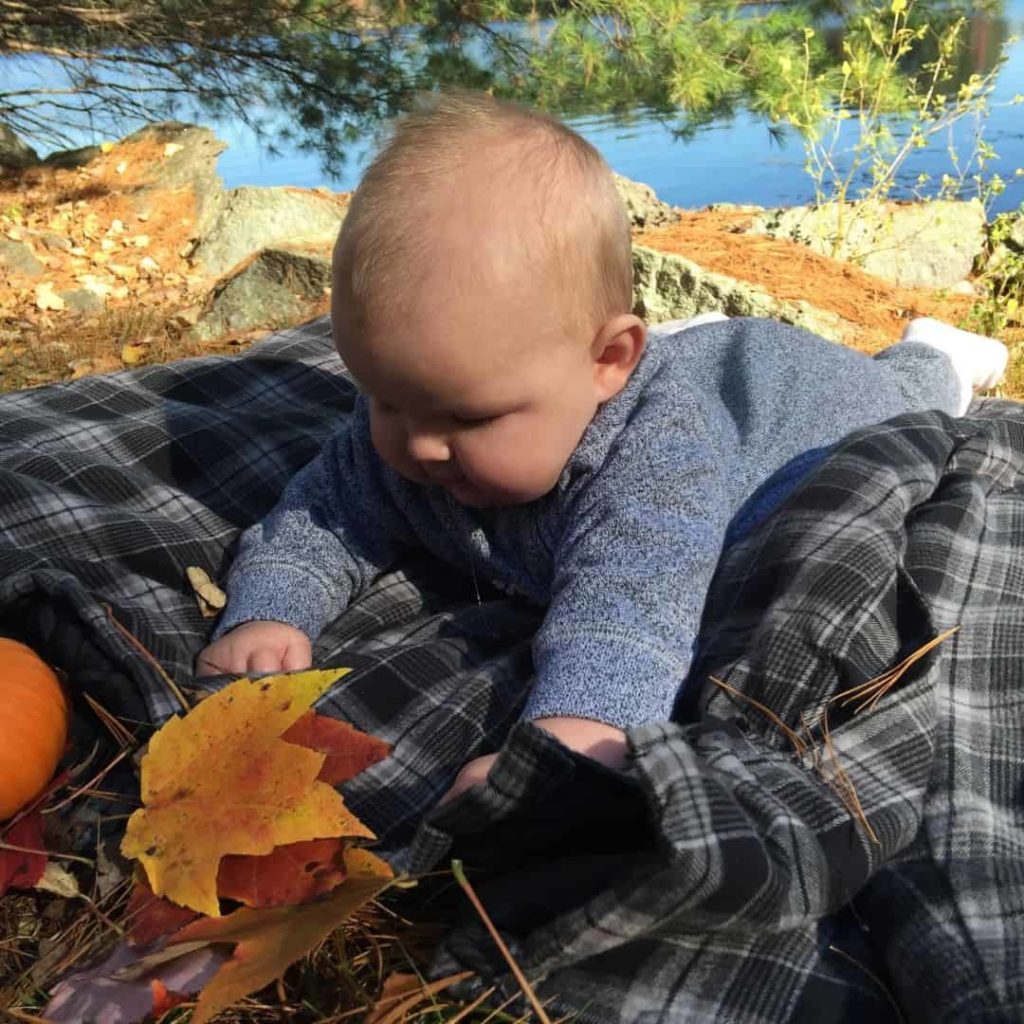
Grab a flannel blanket, bundle up your baby and get outside for tummy time. Find an area with dry leaves baby can touch, add some small pumpkins and gourds for different textures.
And when you’re done bring home some leaves to add to sensory bags for later.
Materials
Blanket
Pumpkins
Leaves
Tummy time is so important for babies. Bringing it outside mixes it up for them and you!
2. Fall photos
Another fall activity for babies, is more for mom and dad, but photo shoots during this beautiful time of year are a must.

Fall Baby Must Have Photos:
In a pile of leaves
Next to a pumpkin/in a pumpkin/pumpkin patch
In a Halloween costume
At the apple orchard
To up the cuteness factor even more, pick up a cute fall outfit for the occasion.
3. Fall baby food
If baby is starting to eat purees or solids now is the time to introduce the following foods that are in season.

Examples:
Pumpkin
Squash
Sweet potato
Apples
Fall Themed Baby Books
Expand your bedtime reading routine to include books about fall, Halloween and Thanksgiving
Here are simple tips for your nature walk:
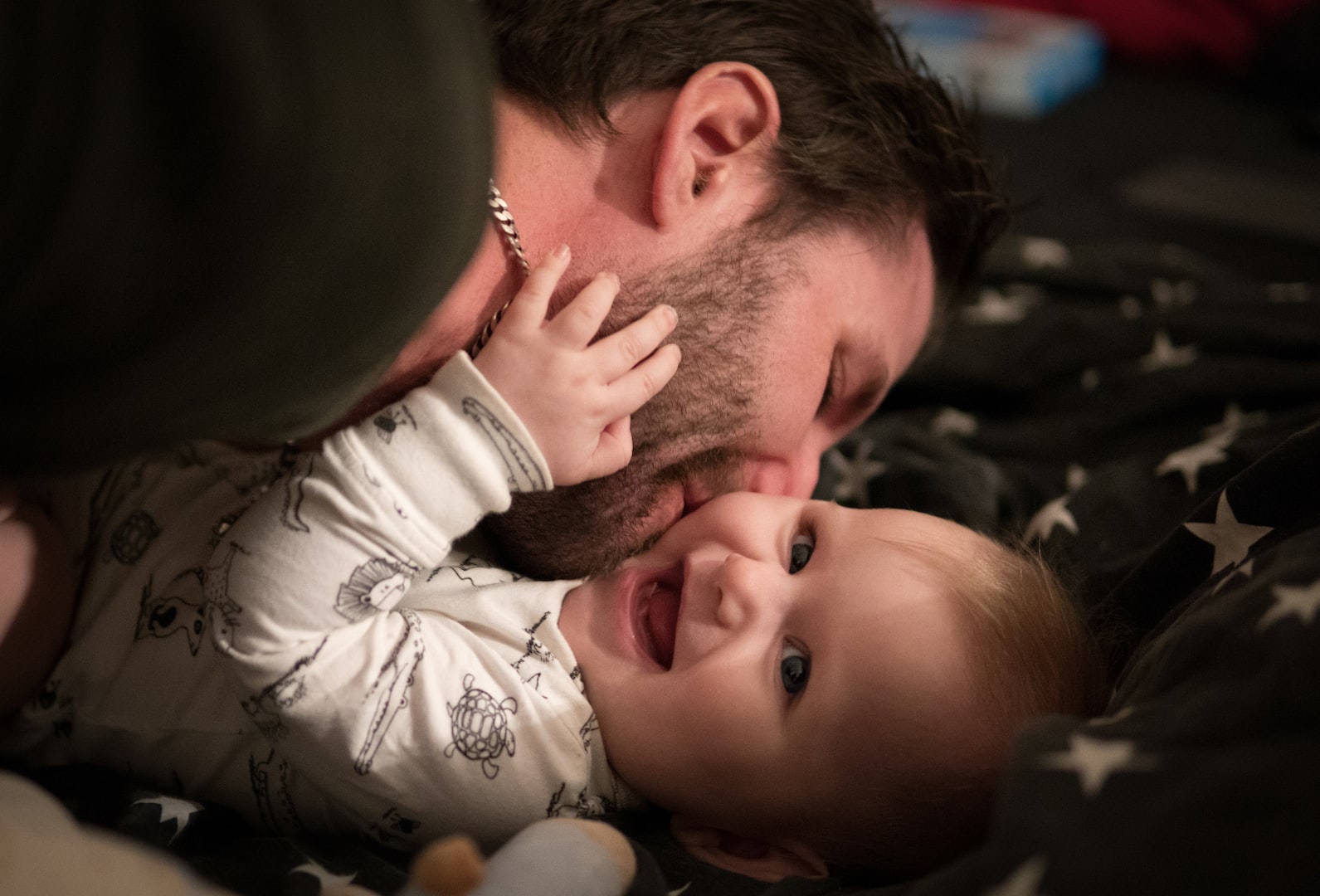
Allow your baby to get close to the ground and examine natural details—different types of grass, bark, moss, leaves, stones, pinecones, and soil may catch their attention. Collect one of each item into a container or basket.
Hunt around for some bugs! Talk about which insects crawl and which one’s fly.
Look up at the sky and tell your baby about the weather and how it makes you feel (physically and emotionally).
Trees are full of lessons—help your baby feel the texture of the trunk by placing your hand over theirs and run them along the bark and count the other trees around you together.
Practice sniffing scents of flowers, grass, fruits, or berries in a garden if you have one.
If your child likes you to take photographs or create art outside, this is a great time to have them capture some of their observations for their Adventure Journal of the critters or other pond features such as plant life or the ripples on the water’s surface.
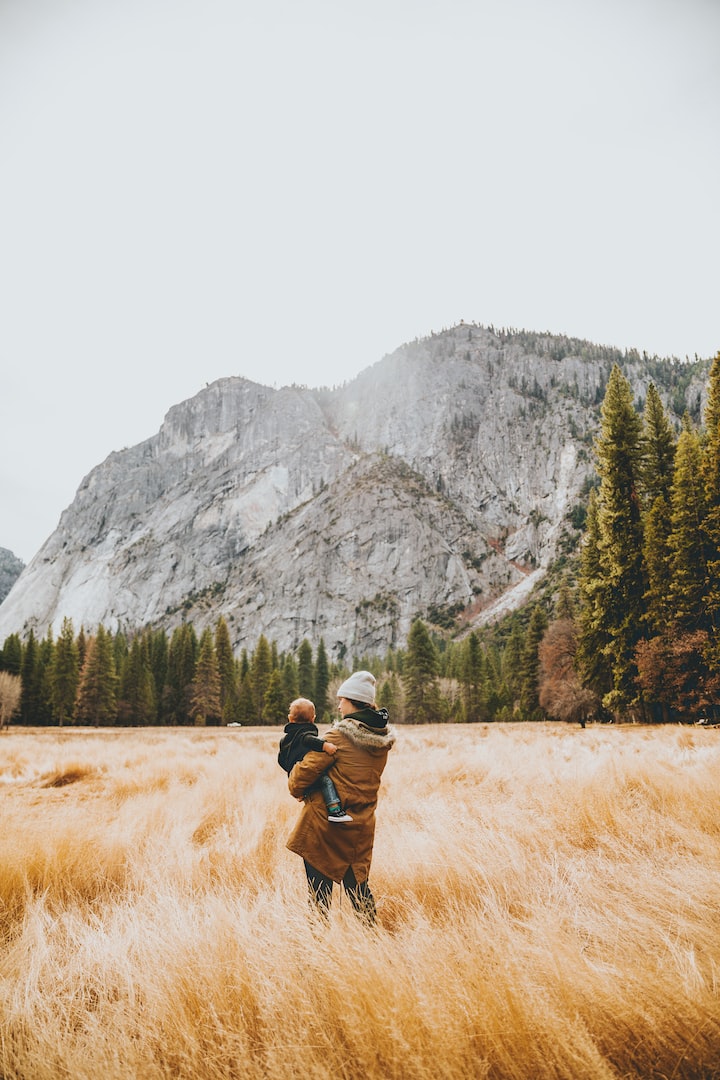
Superscript
The Magic of Spring
Turn Any Walk into a Nature Walk
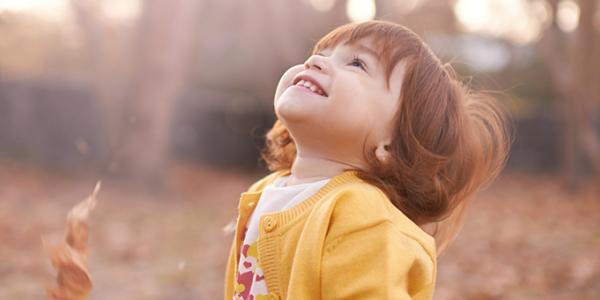
Every walk is an opportunity for children to learn about the natural world. Walking around the block with my child when he was 2 years old could take an hour because there was always something new to explore.
As you explore your neighborhood, yard, patio,
or any nature you find outside your window:
Be open to the wonder of noticing small details and new growth.
Keep the safer distance of 6 feet from others who are not in your household.
Leave electronic toys behind so children can focus on the world around them.
Bring paper and crayons so children can draw what they see if you bring your cell phone and need to take a call.
Bring a digital camera with you so children can take photos of things that interest them to share with [far off, distant] family members. And you can take other photos to print to create a scavenger hunt for children the next time you take the same walk.
Walk at different times of the day or night to increase your chances of seeing something new.
Ask, “What’s different about what you see today?” each time you and your child walk outside.
Play “I spy with my little eye” from your window and help children learn to give clues about what they spied.
Model using all five senses. You might say, “I’m seeing the big clouds,” “I’m touching the wet grass,” “I’m hearing the jets of an airplane,” or “I’m smelling the fallen pine tree needles.” It’s not safe to taste many things outdoors, but you can “taste” the air.
Carry along an inexpensive magnifying glass so children can get up close and personal with nature. Many smartphones have a magnifier app.
Make dressing for the weather part of the learning experience by singing songs about the weather as you and your child put on sunscreen, hats, or several layers of clothing. Try “You Are My Sunshine,” “It Ain’t Gonna Rain,” or “The Mitten Song”. Let your child work to figure out how to zip a zipper or put on boots just long enough so she can learn these tasks and not so long that she becomes frustrated.
Observe the weather
On the walk, or even as you look or step outside, use your magnifying glass to look closely at drops of rain hanging from a leaf or to examine the structure of snow. If it has recently rained, take a medicine dropper so your child can suck up rain from puddles and squirt it back out again. Watch where the water flows and ask, “I wonder where it will go from here?” If it is sunny, make shadows with your body or jump over the shadow of a family member. Use sidewalk chalk to draw the shapes of the clouds you see. Track the path of the sun as it appears to move across the sky—where is it in the morning and where is it at bedtime?
Animals
Use your magnifying glass to look closely at small wildlife such as non-poisonous spiders, roly-polies, worms, and any non-stinging insect that will hold still long enough. Ask your child to show you how the worm or ant moves and join in as he wiggles or crawls. Ask your child to think about how well animals move even though their bodies are so different from our own.
Count the number of larger animals you see on your walk. Is the neighbor’s cat in the window again? Look for birds in bushes and on electric lines. Are there cows in the field, squirrels in the trees, or dogs going for a walk around the block? View birds on live “cams,” a virtual window into the natural world of birds. Talk with your child about what these animals are doing.
Plants
Look closely at the different shapes, sizes, and structures of leaves and flowers (but watch out for thorns and poison ivy). Collect leaf shapes and then make rubbings of different types of leaves. To do this, put a piece of paper over a leaf resting on a hard surface, then rub or wipe the paper with a crayon held sideways to reveal the leaf’s veins and edges. Collect fallen leaves and seeds by pressing them into the sticky side of a loop of tape. Ask your child to measure how tall a plant is in relation to her body (“This bush is as tall as my knee”).
Observe changes in the life cycle of a plant. If a plant has a bud on it, ask your child to guess how many days it will take to open. Then count the days as you revisit the plant on your walks. If your children are old enough, have them record their findings in a notebook or with a digital camera.
Rocks
Use your magnifying glass to see the tiny shapes of crystals or pieces of sediment that make up the rocks in your neighborhood, including those that are used in buildings. If rocks are not part of the landscape where you usually walk, take a field trip to a local creek where you might see some naturally deposited rock. Compare sizes and colors. Try using them as chalk on other rocks or on your sidewalk.
Check the website of your local library for access to electronic or board books that will help children learn more about animals, plants, and whatever else they observe. Children love to see the variety of caterpillars, birds, local mammals, and flowers in these identification books. Internet sites and apps are also great resources for identifying animals and more,
Nature’s Playground: Activities, Crafts, and Games to Encourage Children to Get Outdoors by Fiona Danks and Jo Schofield.
Take a Walk book series by Jane Kirkland includes books for elementary-age children that discuss different environments (beach, city, wetlands) and different things to observe (birds, butterflies clouds).
Bugs Are Insects by Anne Rockwell. For children kindergarten to second grade.
Seashells, Crabs, and Sea Stars by Christiane Kump Tibbitts. For children kindergarten to fourth grade.
Winter Trees by Carole Gerber. For children kindergarten to second grade.
Leaf Man by Lois Ehlert. For children ages 4 and up.
Nature Close-Up: Seeds and Seedlings by Elaine Pascoe. For children from kindergarten to eighth grade.
California Academy of Sciences and National Geographic Society, seek by iNaturalist. https://www.inaturalist.org/pages/seek_app and teachers’ guide, https://www.inaturalist.org/pages/teacher's+guide
Cornell Lab of Ornithology, All About Birds, Bird Guide, https://www.allaboutbirds.org/guide/, and bird cams, https://www.allaboutbirds.org/cams/
Little Pine Learners, Easy nature “weaving” craft. (Wrap with string or yarn if you don’t have rubber bands.) https://littlepinelearners.com/a-simple-and-beautiful-nature-craft-to-tr...
A pre-K teacher offers ideas to integrate nature learning into the curriculum on her website, Thinking BIG, Learning Big.
There are so many things for infants to do outdoors. And if a baby is cozily bundled up, a nap on a screened porch is a refreshing change for them - even in cooler weather.
Nurturing With Nature
Seeing and smelling - such pleasing experiences for infants outdoors. In mild weather, be sure to push strollers to places where babies can see, touch, and smell flowering plants. They want to feel the rough bark of a tree, the soft brush of wild grasses or grains of sand, and explore the many textures of large stones and rocks. You can guide this sensory journey as you help them to notice their natural surroundings, like the gently swaying leaves in a summery tree.
If possible, consider landscaping your outdoors with a flowering hedge of perfumed jasmine to delight babies' sense of smell. And on a warm summer day, babies who sit well relish the experience of a shallow wading pool, where they can splash in a few inches of water while you cheer on their discovery of wet versus dry. Be sure babies wear hats and have sunscreen on exposed skin.
Lawns and other safe outdoor spaces are wonderful places to set babies down on their stomachs so they can observe from close range ants busy crawling, grass moving, grasshoppers leaping, buttercups all yellow and dainty. This arrangement will also give babies opportunities to push up from their bellies and strengthen their arm muscles. Be sure to bring along wet wipes, as babies love to squeeze dirt in their fingers. At the same time, you can help them understand that they may squeeze, touch, and sniff but may not eat many of the earthy materials outdoors.
Even a stroll to mail a letter can be an adventure! Lift up baby so he can drop your letter into the slot. And be sure to point out interesting events along the way: "See the doggy sniffing near that fire hydrant?" "See the light turn green at the corner? Now all the cars know they can go zoom, zoom along the street." "Hear the siren wailing as the fire truck rushes to put out a fire?" The sights and sounds of an urban landscape provide so many opportunities for using new words with little ones. You'll see sights together and speak the words, such as truck or car or green light or bus, that babies will have seen and pointed to in picture books.
Outdoor play in a large sandbox is a delightful sensory experience for very young children. Sandboxes invite babies to use their fingers and hands and, at the same time, to begin to learn simple rules, such as "The sand stays inside the sandbox." Infants develop dexterity while filling and emptying pails or sifting sand with a flour sifter. They learn how sand feels dry and how it feels wet, when mixed with water. And, of great importance, they get a chance to play peacefully next to peers. This companionable side-by-side play is the precursor to more interactive play older babies will come to enjoy.
Whenever you can arrange outdoor experiences for your little ones, know that you are helping them experience another dimension of living - far different from indoor spaces. So give them windows on new worlds - visit a park, zoo, flower garden, or a duck pond, or even stroll to the corner store.
Ponds, Lakes and Creeks:
Sensory Discovery Zones
Sensory Discovery Zones
June 27, 2020
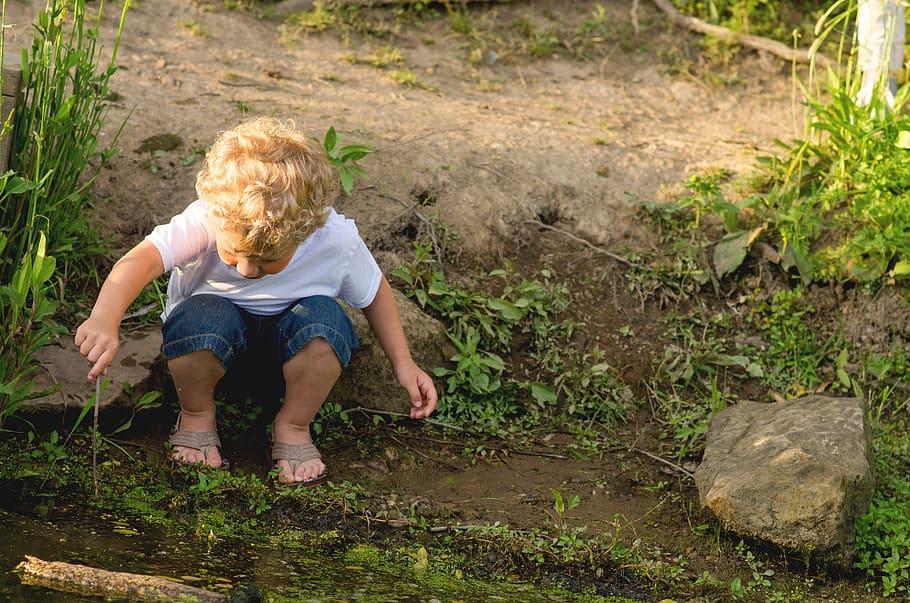
Ah, pond life. The simple life. But what looks like a quiet, still— even stagnant— place on the surface is actually a busy ecosystem brimming with life and so much nature to take in.
A child can wade in the waters of a pond, explore the mud between their fingers, listen to the calls of frogs, see dragonflies exhibit a multitude of behaviors and feel the sunshine on their face. Ponds are great for teaching children about wildlife and the different stages of the life-cycle of small creatures such as frogs as they unfold in natural surroundings. True reality entertainment.
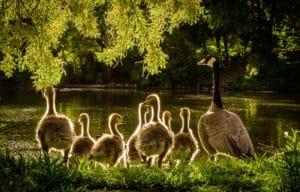
Ponds are quiet bodies of water so shallow that rooted plants grow completely across it. A pond's bottom is usually covered with mud and its water temperature is fairly uniform from top to bottom and there is very little wave action. Sounds like a good place to explore!
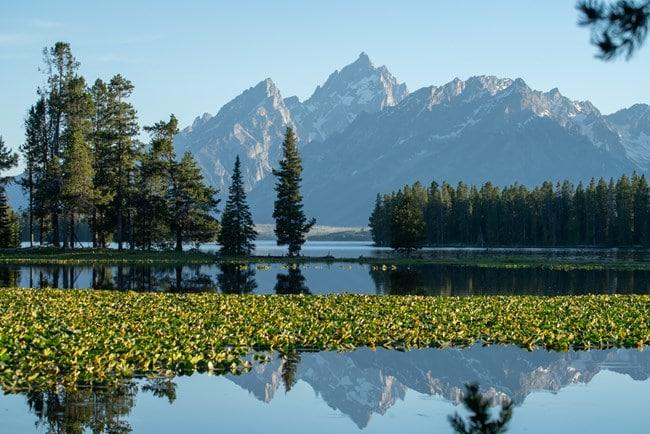
Just remember that not all ponds are created equal. Some ponds are created by streams— mountain-stream ponds. Others are created intentionally such as farm ponds There are also mountain ponds, formed by glaciers, cypress ponds and bog ponds. You can learn a ton about your local pond together with your child.
Bring a bucket for sampling, a water scope, a net for catching swimming or flying critters. Whether your child prefers to head in with their bare feet for a truly sensory experience or wear water shoes, warn them that ponds can be slippery places! Rocks, mud, algae, and grass combine to create quite the slippery formula. And a child can drown in just a few inches of water so be vigilant. Always keep an eye on your child when exploring ponds. Be sure to check the wading area for slippery or sharp rocks and drop-offs.
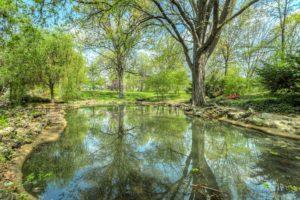
Once you’ve done a walkaround, ask your child to find their own observation spot and have them spend a few minutes just watching. It can be anywhere they choose. Make sure they are within your eyesight. Don’t give them species to focus on or behaviors to look for. Just have them take in the big picture. Ask them to practice silent observation by keeping their movements small and their voices quiet.
After a few minutes of big picture observation, start zooming in on activity or critter that caught their eye. Ask your child to focus on one thing they noticed and tune into it. What is it? How is it using the pond? Who is it interacting with? What does it do in the pond? What does it eat or where does it shelter?
It’s amazing that the world right outside your home is full of opportunities for your baby to learn. All throughout the year, nature—even in a busy city—offers new colors, textures, scents, and shapes for your baby to experience. Take a stroll around the neighborhood or explore at a local pond with your baby, enjoy the fresh air, and collect some natural souvenirs for an outdoor treasure box.
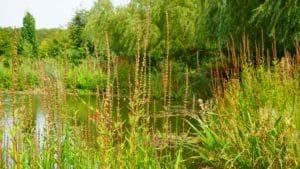
If you have an adventurous child, encourage them to engage more of their senses by experiencing the water, mud or get closer to the sounds of the pond. Ask them what they would like to touch: the fuzziness of a cattail, the gooeyness of mud, the sliminess of an algae-covered rock. Be sure to help them understand how to touch the parts of the pond they are interested in without disturbing the environment or hurting any creatures.
If your child really wants a full-on sensory experience, let them wade into the pond. This is a great way for them to experience how the water temperature, while fairly consistent, does range from bottom to top with the colder, denser water settling at the bottom while the warmer water is at the top. Ask them if they can feel this on their own?
Another fun experience is to feel the bottom of the pond on their feet. As most ponds have a muddy bottom, this should feel good. But there are likely to be plants, some rocks and even some critters like snails and sponges down there. If they are intrepid, have them reach in and pick up some mud from the bottom. Bear in mind that some ponds can have jagged rocks on their bottom and some might have leeches in them. Leeches are found in shallow protected waters and are most active on hot summer days and at night. This nuisance critters are drawn to disturbances in the water near docks and swim beaches. To avoid leeches, swim in deeper waters off docks and floats. Leeches are mostly found in organic sediments or debris, so try to avoid these areas if leeches are known to be in the pond.
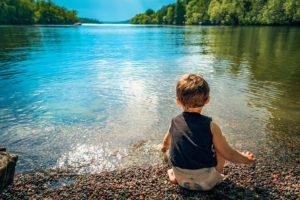
Pond water is a world onto itself! Have your child use their bucket to take a sample of the pond water and peer inside to see what they caught. It could be small fish, plants tadpoles, insects, or a whole lot of murky water. A butterfly or fishing net is also a great way to catch critters in the water or the air around a pond. Butterflies, dragonflies, and water insects love to refresh, eat, and drink on the water of a pond. Chasing these critters on the shore of the pond is a fun challenge for kids and one that not enough kids get to experience. Be sure they learn to be gentle when catching their critter. Once they take a gentle look, noticing the parts of the insect as well as its colors and patterns up close, help your child release the critter safely.
Let your and your child's imagination run wild as you explore this fascinating ecosystem together. Here are some more ideas for having fun exploring nature at a pond! Exploring ponds with kids isn’t limited to the water. A butterfly net can help you capture amazing creatures such as dragonflies, butterflies, and other flying insects, as well as water insects. Chasing a flying insect is a great hand-eye coordination activity—plus, it’s just fun! And when my children do manage to catch a butterfly or damselfly, they love to examine their vibrant colors and fragile wings. Every creature is so unique and beautiful.
Fun Things to do or tell your baby about the water
Find as many pond critters as you can with a Pond Scavenger Hunt.
Our free downloadable printable is here to help!
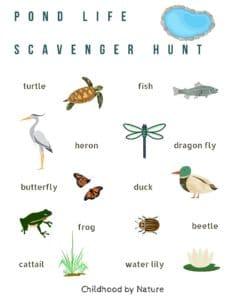
Observe dragonflies. Dragonflies are also called Mosquito Hawks or Devil’s Darning Needles. If you think there is just one species of dragonfly, think again! There are around 400 species of dragonflies in North America alone.
Turtles are pond lovers. They bask on rocks and logs to fill their body with warming energy. They scavenge dead animal and plant material and remove diseased or weakened fish, contributing to improved water quality and fish population health. In the spring, baby turtles (just tiny, mini versions of the big guys) are an absolute delight to find. Some aquatic turtles can absorb oxygen through the skin on their neck allowing them to remain submerged underwater for extended periods of time and enabling them to hibernate underwater. Look for turtle heads popping out the surface of the pond’s water. The soft-shelled turtle uses its long tip nose and nostrils like a snorkel to breathe underwater.
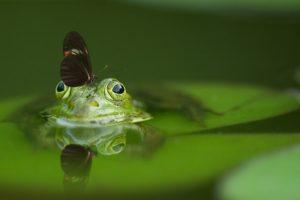
Why do they float? What lies beneath the surface? How do animals use them? Learn more at home. Then, go Monet & create a masterpiece of your own.
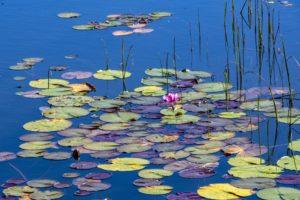
Aim for an early morning or evening casting time, when the fish are most active. You also need to make sure you're courting them with what they want. Pond fish are attracted to sink worms, jigs, and shallow crankbaits. If you know your pond is full of catfish remember to add catfish-specific bait to your tackle box! When pond fishing with beginners or kids, it's best to bring along live baits. Night crawlers, minnows, crickets, and waxworms will attract several fish species in a pond. These live baits can be rigged on hooks in sizes from 8 to 4 depending on the size of the fish species you are targeting.
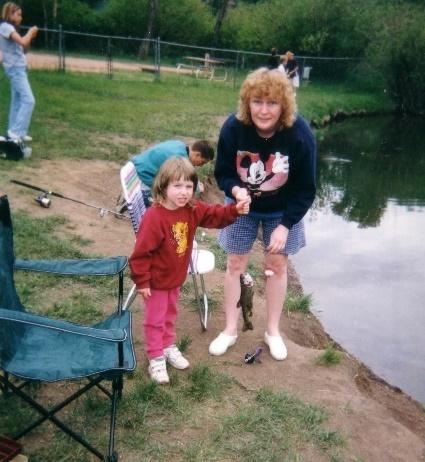
Hope was taught to fish almost as soon as she could hold the fishing pole. By age three she was baiting her own hooks and pulling in her own fish. She loved it. The photo above is her reeling in her first trout in Colorado Springs. My family lives in the Finger Lake area so my grandfather taught all his grandchildren and great grandchildren how to hunt and fish. Those lessons included some of his own wonderful and wild fish tales. LOL They were fascinating. 😊More information on Pond fishing
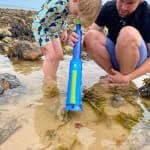
Ponds are home to many animals, plants and organisms, such as frogs, different types of fish, algae and amoeba. In fact, most plants and animals can’t survive without freshwater biomes. Water scopes allow us to have the opportunity to discover the world below the surface of ponds. We bought the Educational Insights one. probably when Hope was two. She still has the smaller piece at age 24. You can buy one or make one using these instructions here.
Make one of these handy tools by sealing a piece of glass in a bottomless bucket or water-proofed box.
Pond fish eat algae and other beneficial bacteria off the rocks and gravel in your pond. Wild koi (also known as the common carp, the domesticated koi carp’s ancestor) will readily eat aquatic insects, flies, algae, smaller fish, plants like water lily and water lettuce, snails, and frogs. Other pond fish are opportunistic feeders and will happily eat all sorts of plants and animals if they’re small enough to swallow! Although it’s not necessary, it can be fun to give your fish a summer snack from time to time. Pond fish will enjoy a little watermelon, orange slices, peas, and even Honey Nut Cheerios.
Feed waterbirds. The age-old debate is whether it’s safe to give birds a snack to birds or not. In fact, bread is not the best food to give waterfowl as it fills them up without giving them the nutrients they need. Bird experts recommend small amounts of grain such as wheat, corn or bird seed, plus fresh chopped greens like cabbage or spinach, as these will supplement the birds’ natural diet and help provide the birds with the necessary nutrients to keep them healthy.
A water scope allows you to see more clearly into the murky waters of a pond or stream. We are very fortunate to have a creek behind our house, and the boys LOVE to go back there and catch minnows and frogs. I wasn’t sure that I really wanted to see more clearly into the murky water (since there are snakes! eeek!), but we decided to give it a try!
To make one, you will need:
An empty plastic container. We used a Powerade bottle, but a large yogurt container would work better.
A rubber band
Plastic wrap
A utility knife
Cut the bottom off of whatever container you’re using. This will be the window into the water. Since we were using a bottle, we cut the top off too.
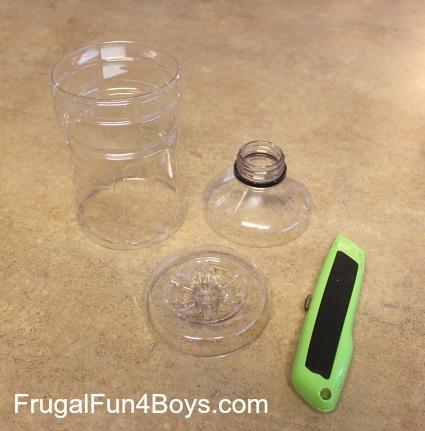
Then, cover the bottom end with plastic wrap. Fasten it on with a rubber band. You want the plastic wrap to go up pretty high on the container, because water will leak in if the container is submerged above the rubber band.
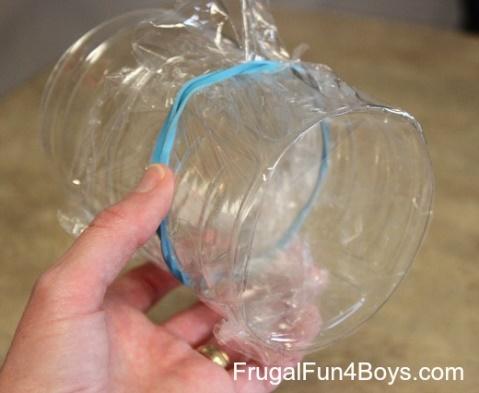
Then you’re ready to explore!
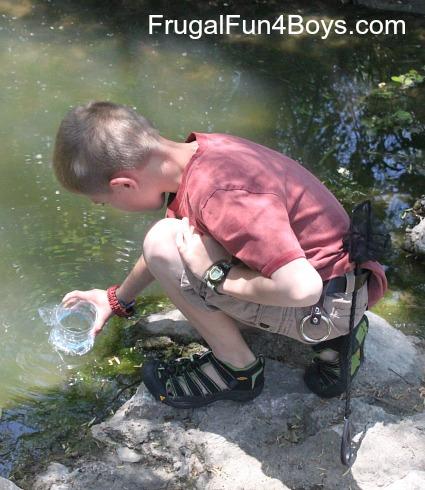
The water scope eliminates glare on the surface of the water, and you can get a much better look at what is down there! It’s hard to tell because of all the glare in this picture, but the water scope really did work well.
Playing On Shore
Some of my fondest memories as a child are of playing in creeks with my sisters and brother and other neighbors. We could spend hours playing, exploring, learning, and cooling down on a hot day. We were late for dinner all the time – sorry mom. Our creek was a treat to play in and take a picnic lunch for a longer visit. It was down at the bottom of a treacherous hill on a dirt road. So we were much older when we were allowed to go by ourselves.
There’s something special about the water, moss, rocks, small creatures, and plant life that you find in and near creeks. Something magical that is different from any other shore. There is so much to find, explore and do that the hours will fly by like minutes.
Every inch that we explore with babies is all new to them. Warm like a blanket, your hugs envelope your baby in the safety and security of your arms where they feel the love you can't tell them yet, but they can feel brimming from your heart. This is the beginning of them knowing they can rely on you, to trust that you will be there for them. An added bonus is when you spot a hummingbird, a butterfly, or a cute rabbit while you’re there.
For some little ones being in a great big space may feel overwhelming. Creating little hide outs, forts, or playhouses is a great way to keep baby feeling snug and secure in the natural environment. When my oldest was young, she and her cousin had “the digging yard,” which was a patch of dirt under the branches of an ancient forsythia bush where they took digging trucks and basically just dug things. Endless hours of fun!
Building special places for your kids
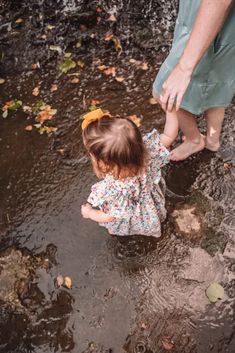
Superscript
Having a Blast in the Snow
Even a simple dog walk can be turned into an exciting ‘adventure’ for a baby. So pack some snacks, get on your boots and take a look at these super fun winter outdoor activities for kids to give you some inspiration. Aside from the obvious coat and hat, for little ones I love having snow pants like these
. These are fairly easy to wrestle kids into and keep them dry and warm. Waterproof boots and mittens are also ideal for keeping toddlers cozy.
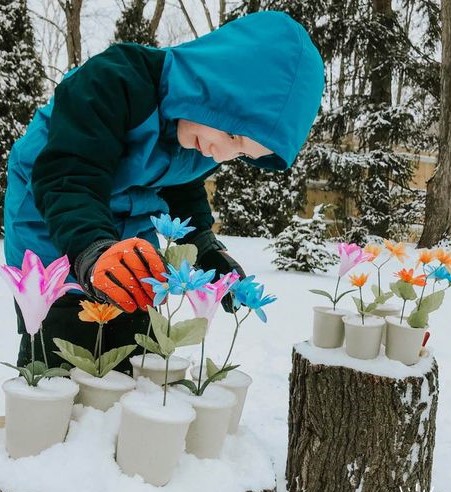
SNOW PLAY
If we are lucky enough to get snow, then it opens up a whole load of other outdoor activities that the kids can enjoy. There’s the obvious building of a snowman, snowball fights, making snow angels and sleding down a hill.
Break Out The Beach Toys
Sand toys make perfect snow toys so pull out the beach toys!
Buckets, shovels, rakes, and molds work just as well in the snow as the sand.
My kids could probably spend all day digging and building snow castles.
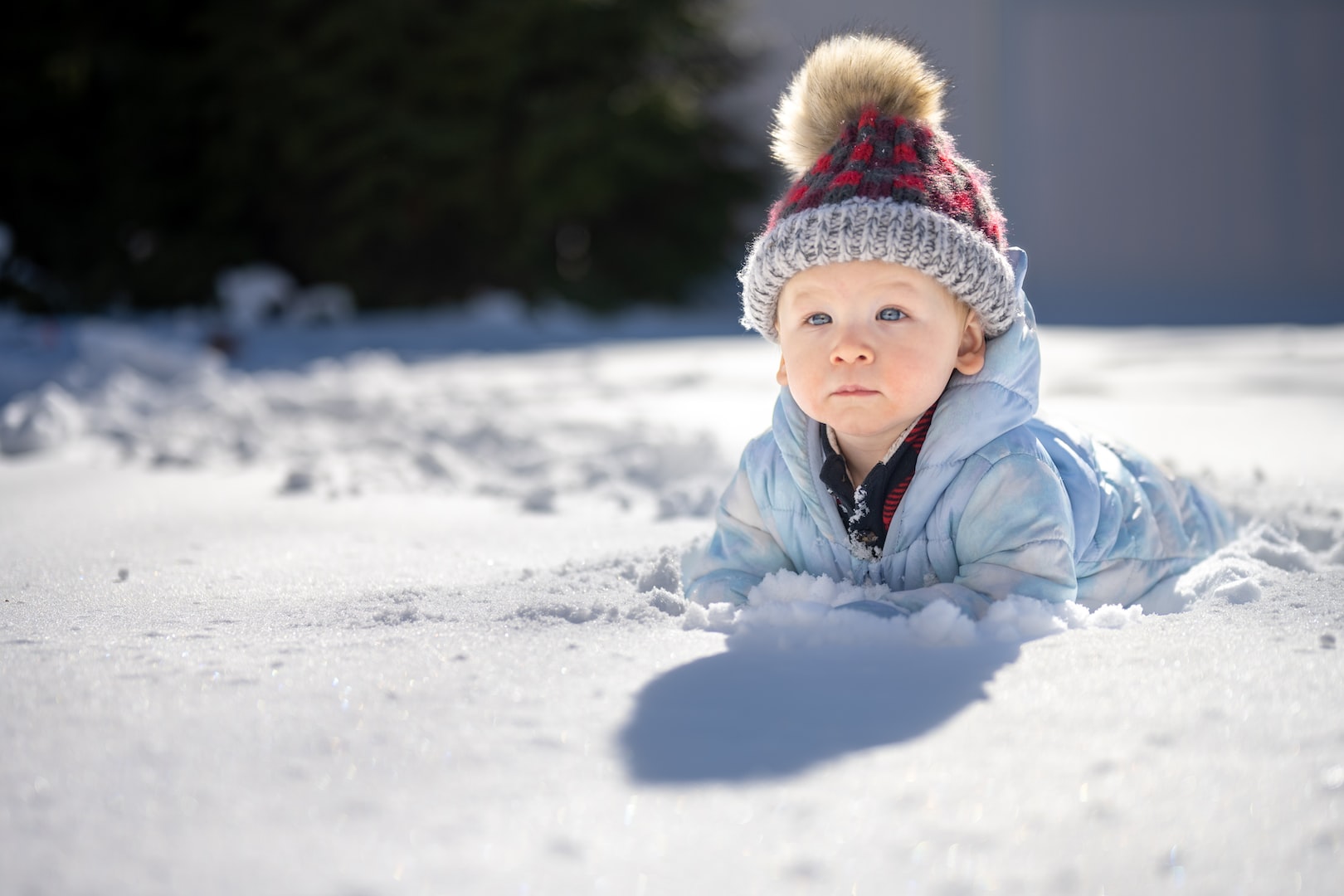
Family Fun With Snowballs
Snowballs are great for more than just the obvious snowball fight.
I actually try to discourage snowball fights since they tend to end in tears at our house, but we still have tons of fun.
Throw snowballs at a target
Sidewalk chalk works well for making a bullseye on a tree or fence. A hula hoop is another ideal target. Also tossing snowballs into buckets is a fun alternative.
Stack them up and knock them down
I know this sounds silly, but it is seriously one of my son’s favorite things to do with snow.
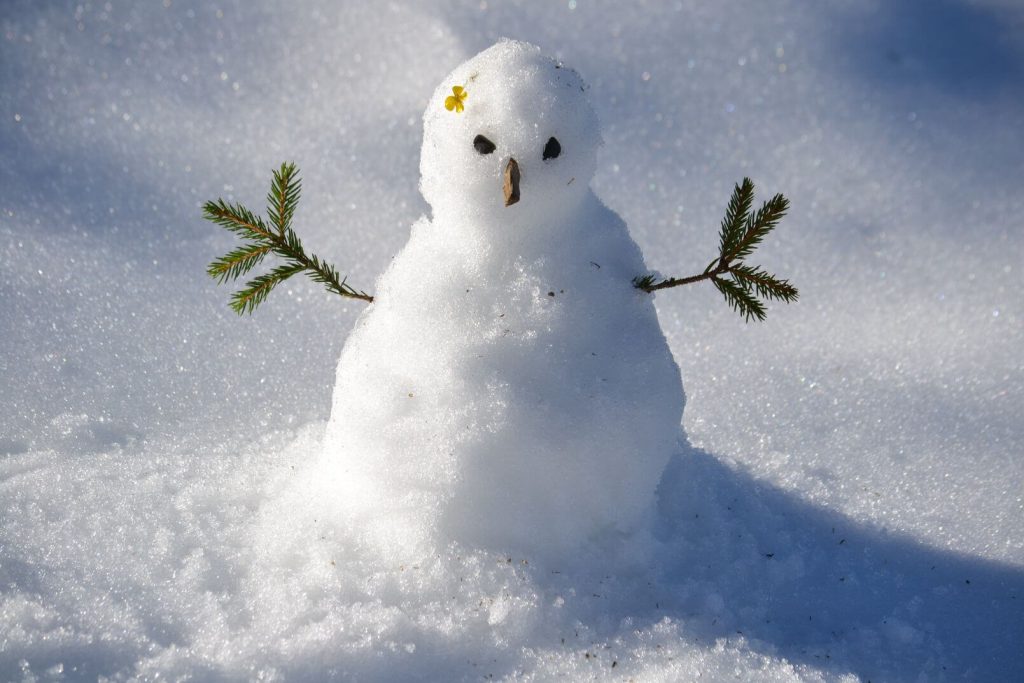
Make mini snowmen
I love a good snowman, but they can take more time and effort to build. My kids lose interest and I end up doing most of it myself. Mini snowmen are a much more toddler friendly time commitment and so adorable.
Sometimes tiny, mittened hands struggle to pack good snowballs, but you can spare the frustration with a snowball maker
. I have to admit that I thought this sounded a bit weird, but you can make tons of perfect snowballs in a minute.
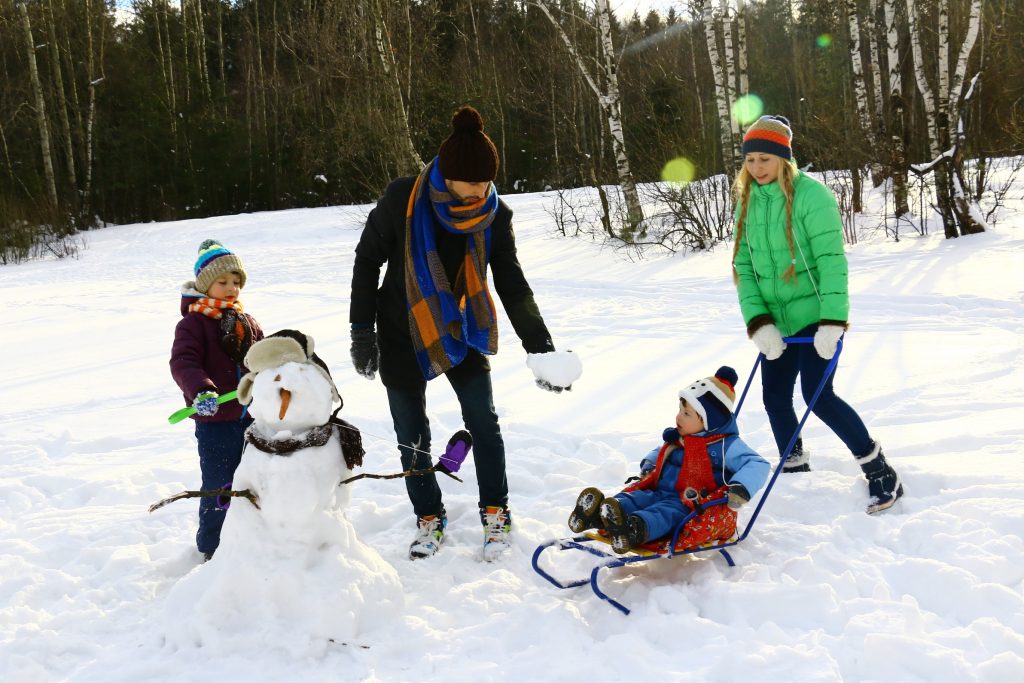
Play with The Indoor Toys Outside
The toys your kids play with all the time in the house will seem way more exciting out in the snow! Also, most plastic toys survive the snow just fine.
Trucks, cars, and construction equipment make fantastic snow toys. My son loves driving his race cars through the snow!
Kitchen sets are also a huge hit since they can “cook” with the snow. Stir the snow in the pot, pour it into cups, and, well honestly, they eat it too.
Work with what you’ve got like superheros, ponies, or an outdoor snow tea party!
Turn your Mud-Kitchen into A Snow Kitchen
Make snow cookies and fill pie plates with snow and decorate them with winter fruit, berries, pines and natures winter treasures.
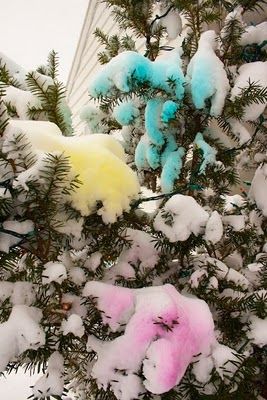
Paint The Snow
Snow makes a pristine canvas for painting! Plus, kids love making a huge colorful mess outside!
You can find several different “recipes” for snow paint, but I’ve just used food coloring and water.
Apparently, you can get more vibrant colors with other methods, but this way is so ridiculously easy and I almost always have everything on hand.
Mix your food coloring with water in a squirt bottle, spray bottle, or even a squirt gun.
Then let your little ones go to town on the snow!
As a bonus, you can throw in a lesson on color mixing while painting.
A few notes:
I’m fairly heavy handed with the food coloring or the colors end up very light.
It seems like squirt bottles tend to be the easiest for little hands to squeeze.
Beware that the paint may stain clothes!
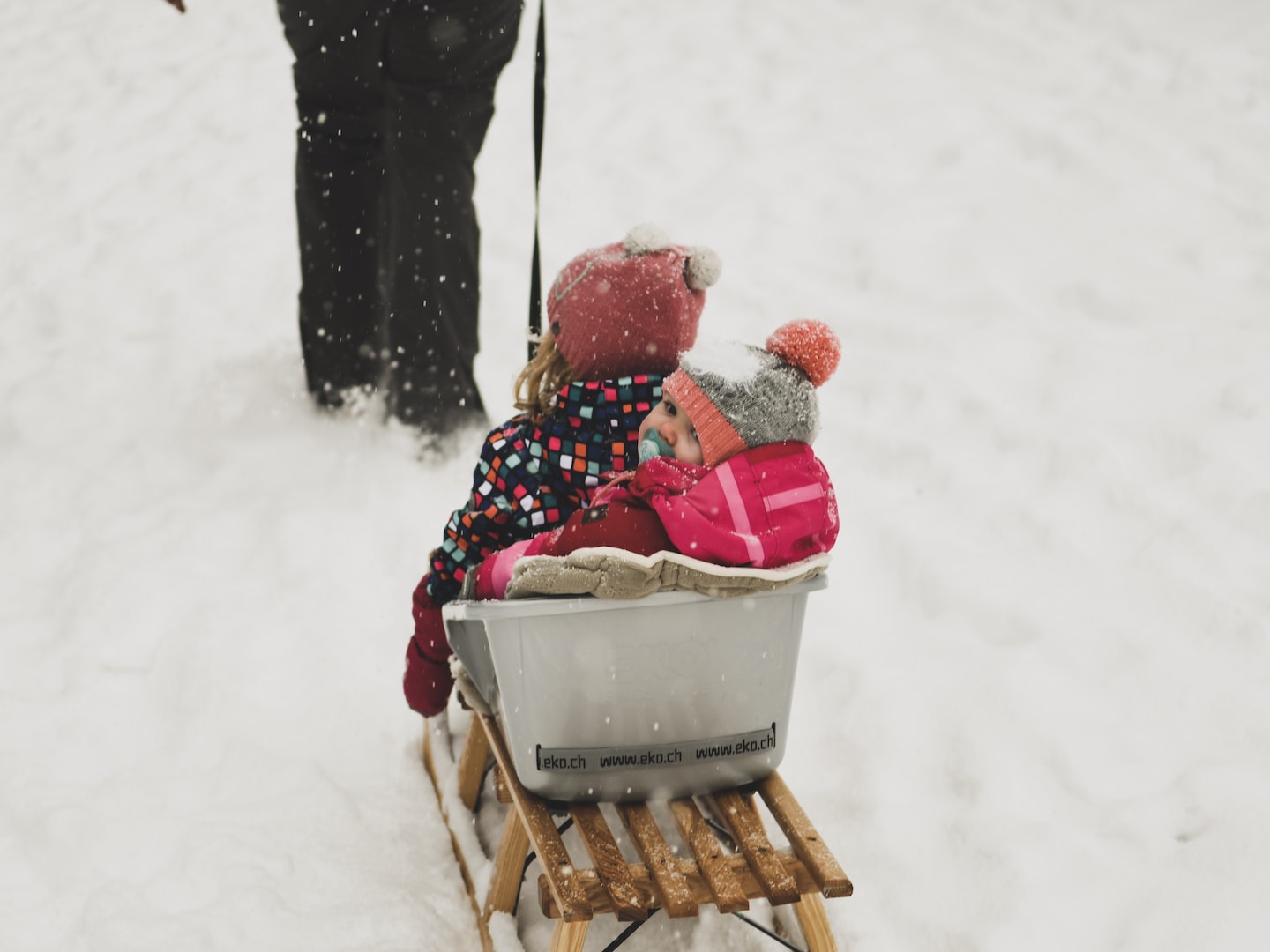
Build With Colored Ice Cubes
This is a really fun idea from Happy Hooligans.
Make colored ice cubes to use as building blocks in the snow!
Your littles builders can make beautiful creations from towers to sculptures with these unique blocks!
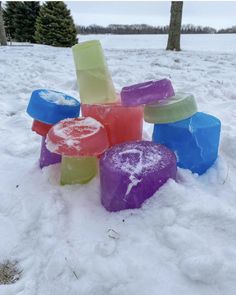
VISIT THE BEACH IN THE WINTER
Just because it’s winter, don’t give the beach a miss. The beach can be great for shell hunting, or treasure hunting with a metal detectors.
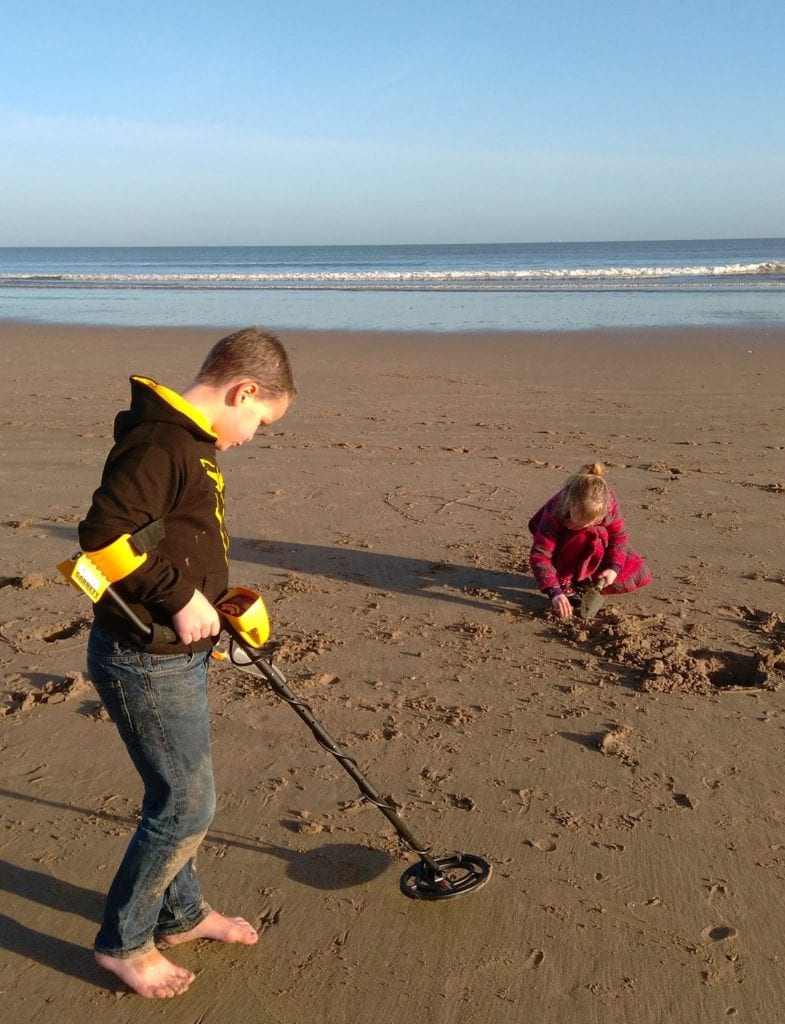
Credit: YorkshireWonders.co.uk
You can also spend hours wave jumping, or use the sound of the sea and the sight of the waves crashing against the shore as inspiration for some creative writing, story telling or beach inspired artwork.
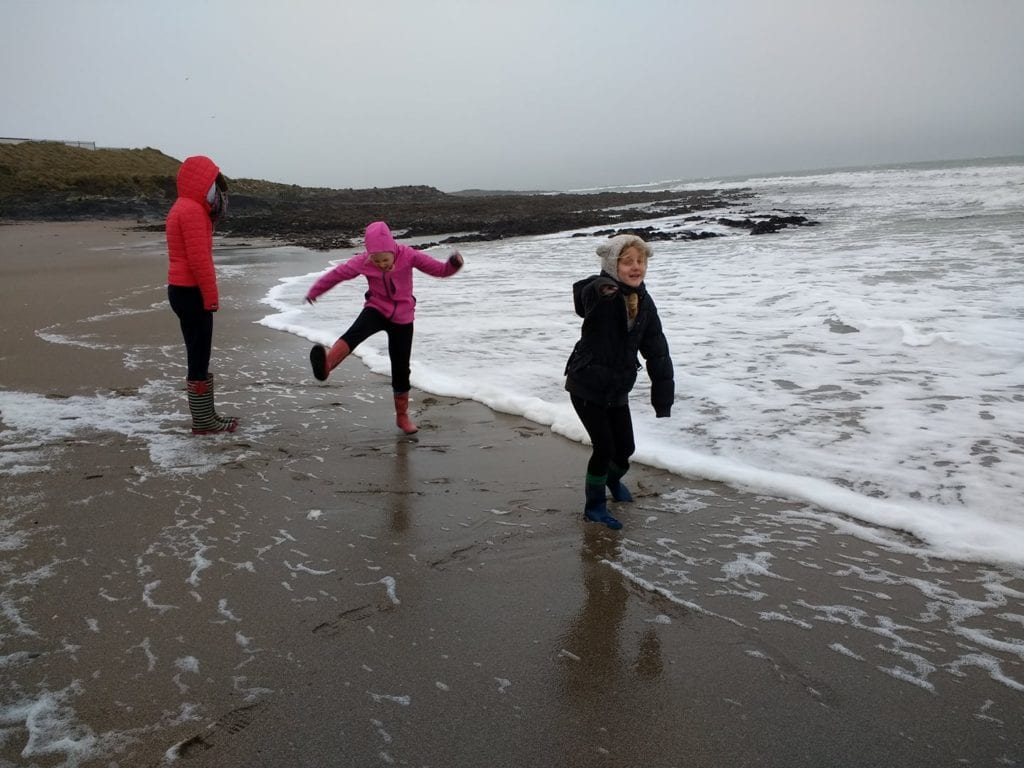
Credit: Libertyonthelighterside.com
FROZEN BUBBLES
It needs to be below freezing for this to work but looks oh so pretty if you can manage to create freezing bubbles. Here are some top tips for frozen bubble making. Failing that – blowing bubbles is a fun thing to do outside whatever the weather! This is our favourite bubble making kit – it makes the biggest bubbles! Find out more in our bubble activities post.

SNOW COOKIES AND SNOW CAKE
Our kids love pretend baking outdoors – you can read more about mud kitchen activities for kids here but when there’s snow – try baking snow cakes and snow cookies!! No mud kitchen needed – just give kids some baking equipment and send them off into the snow to get baking!
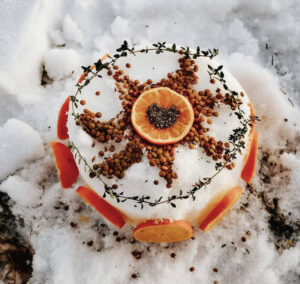
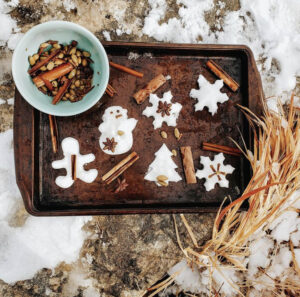
`Snow Baking. Photo Credit: @destinationmommy
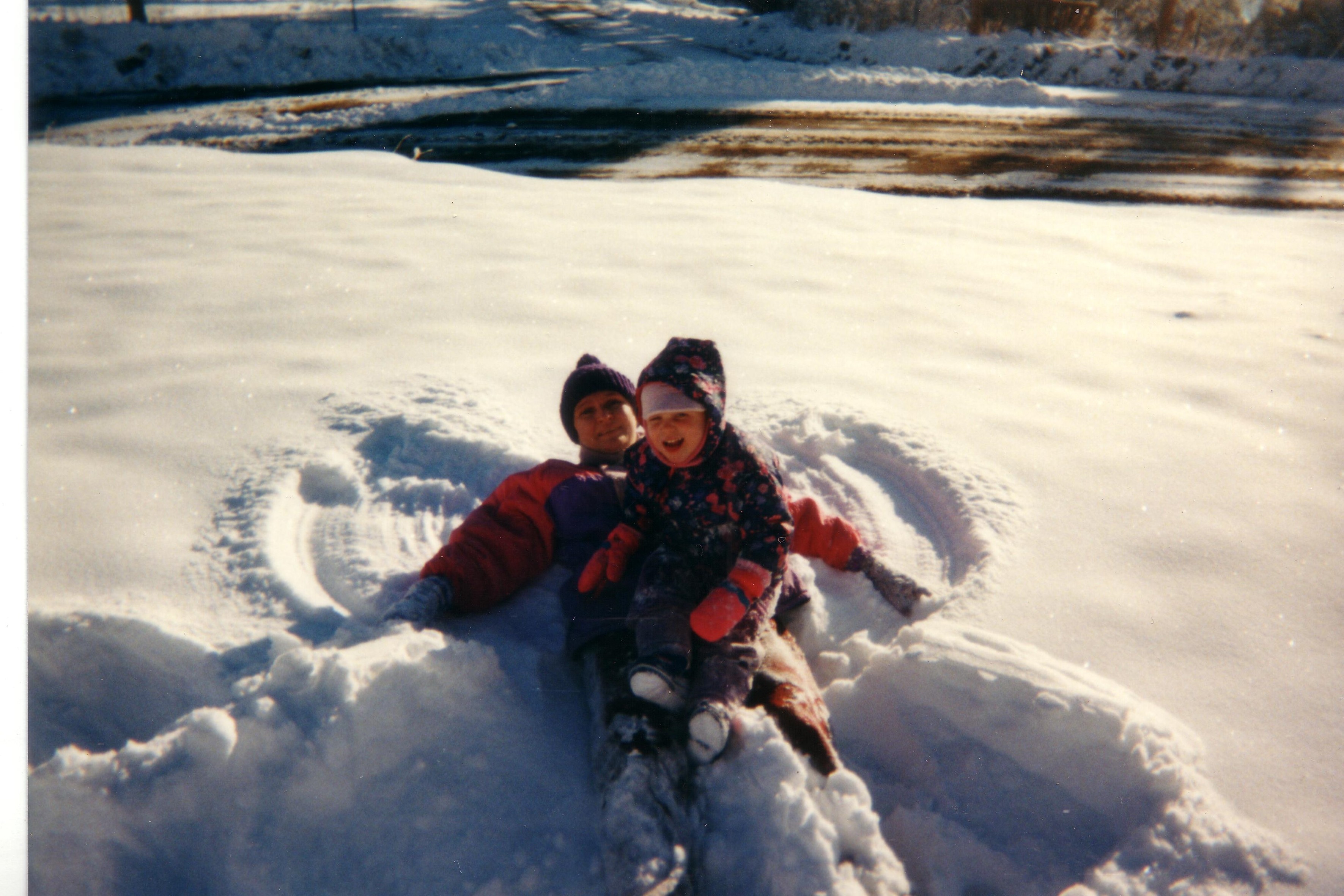
Go for a sled ride – a toddler’s favorite winter activity!
Whether it’s just for fun or for practical purposes, having a good quality pull sled is very handy when you have young children. You can pull them around the block, they can slide around in the backyard, or they can pull their own doll or stuffed animals for a ride!
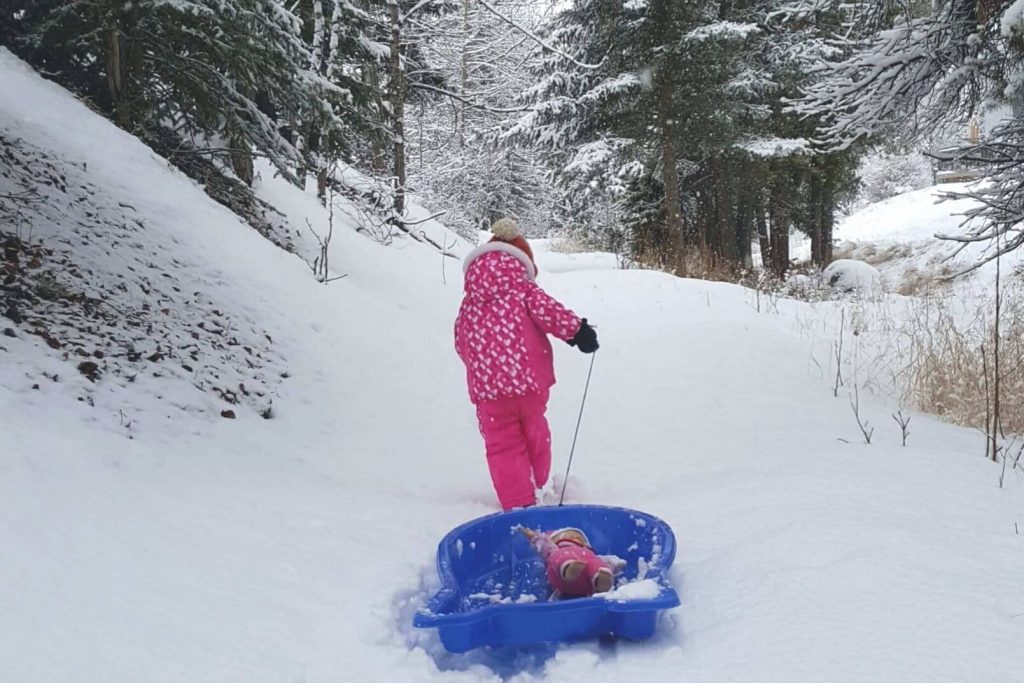
Taking dolly or stuffed animal out for a sled ride
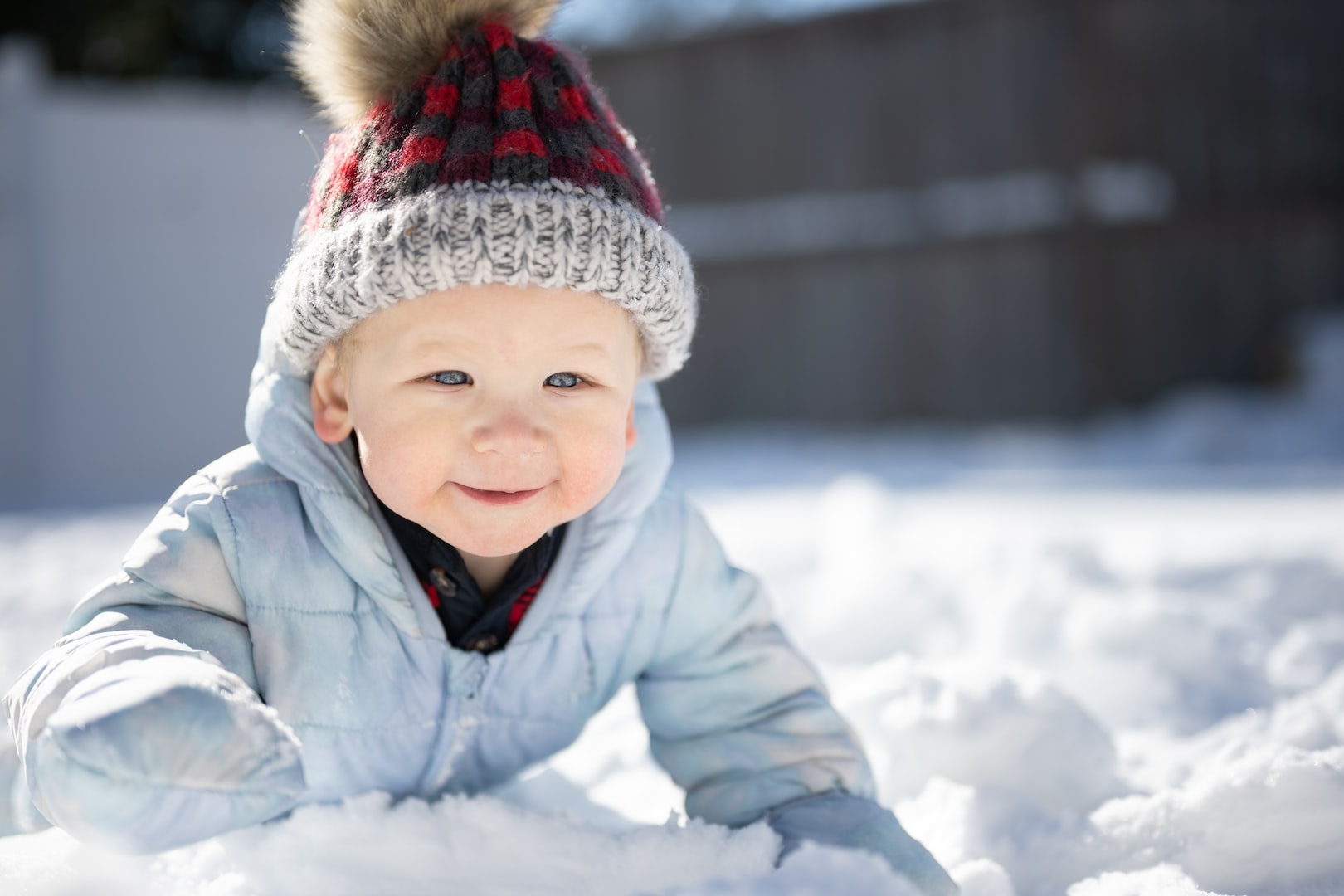
Superscript
A place to grow
Maria Montessori often wrote about the importance of time in nature with children and having a connection to the natural world. There is so much to be learned by watching and experiencing all the world around us. There is beauty in nature, harmony, strength, resilience, and order. These things are naturally attractive to a child. This is a really great collection of Montessori quotes on the importance of nature from How We Montessori, if you want to read more of Maria's words directly!
I often write about all the things that my baby is up to inside, which can make it seem like we aren't spending time outside. This is more of an "I don't bring my camera outside as much" issue than a "we're not outside" issue. In fact, we try to go outside everyday!
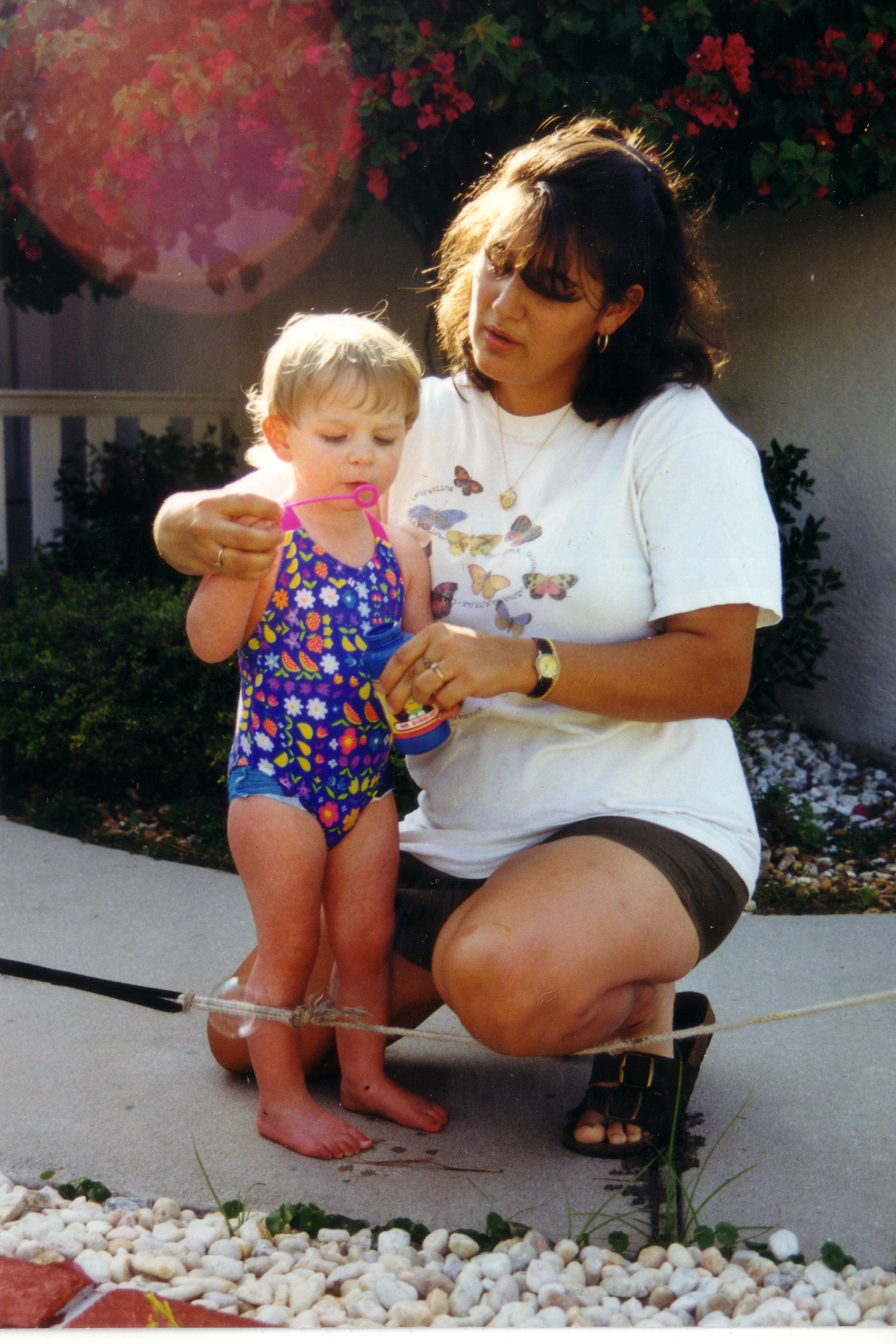
Much like indoor exploration, outdoor exploration needs to be baby-focased. They are discovering everything for the first time. Everything from the smallest blade of grass, to the ant crawling across the sidewalk, to the wind on their face is fascinating. These tiny humans, need time, space, and the freedom to explore the world around them.
Keep clothes loose fitting but seasonably appropriate so that your baby can still move freely. Try layers to keep warm if cooler temperatures are a concern.
Keep hands/feet as uncovered as possible so that exploration is possible.
Prioritize the freedom of movement, just like inside, avoid containers that keep your baby from moving and exploring freely.
Put your baby on the ground! Newer babies can enjoy a blanket under a tree, or near a shrub or flower. Older babies - plop them down and let them explore!
Let your baby touch, smell, taste (where safe) the things they discover outside -- just like you would inside!
Don't be afraid of the mess. The ultimate sensory play can be found outside, let your baby explore the puddle, the mud, the grass, the sand! It's messy, but babies are easy to wash!
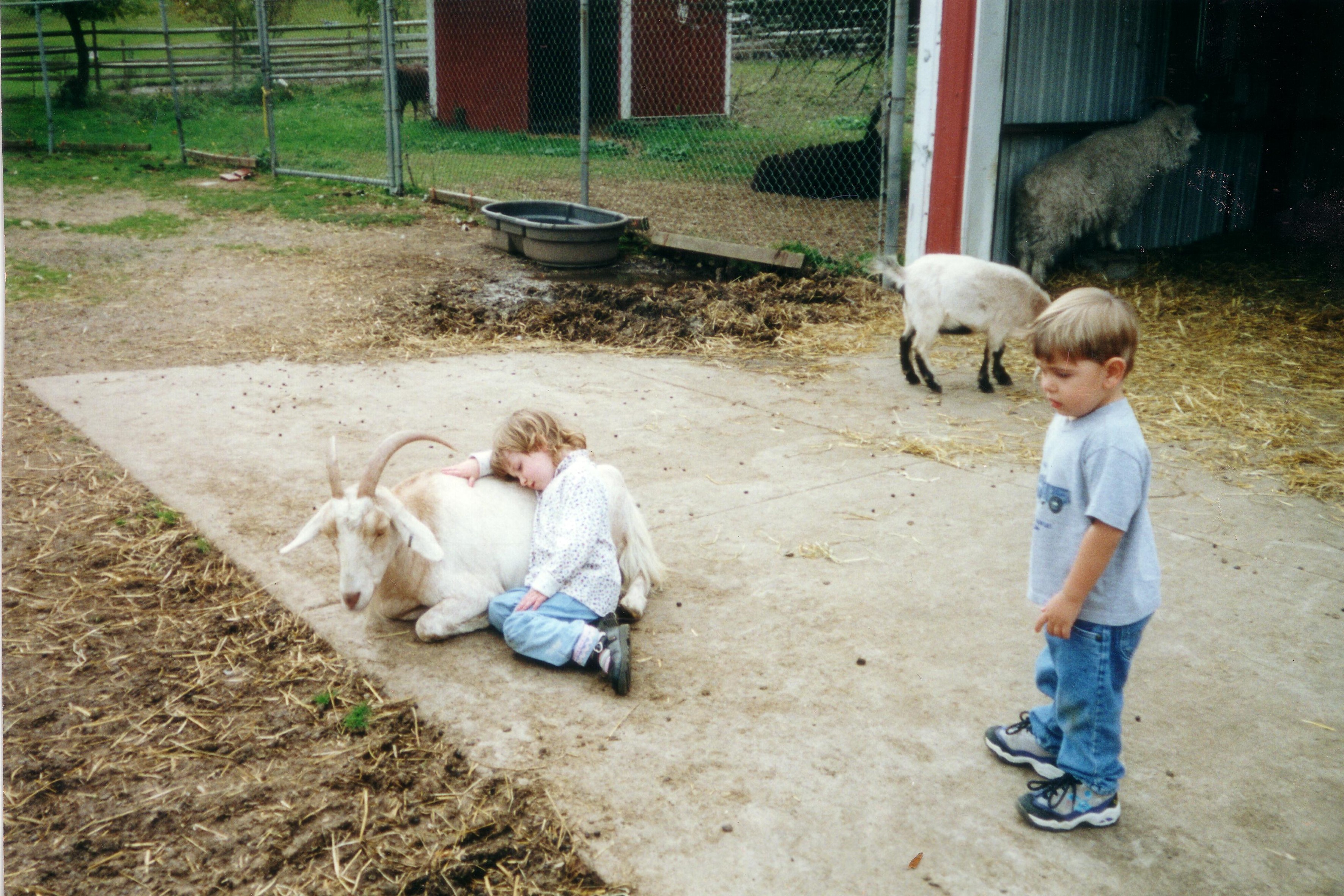
Bottom line, take your baby outside, early and often! It's good for both of you!
Does your baby like outdoor time?
What does your baby like to explore outside?
